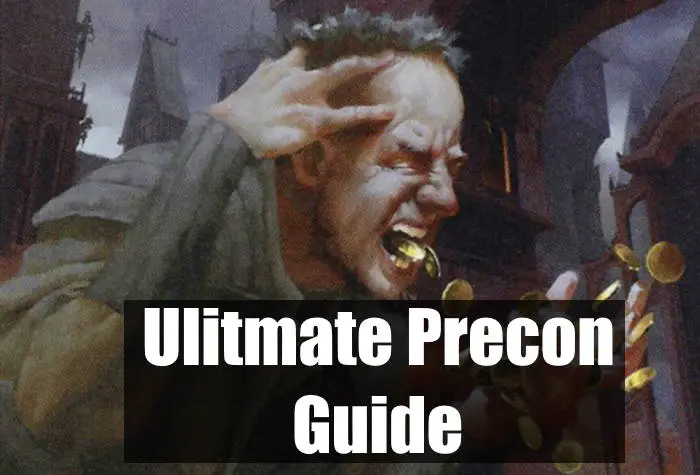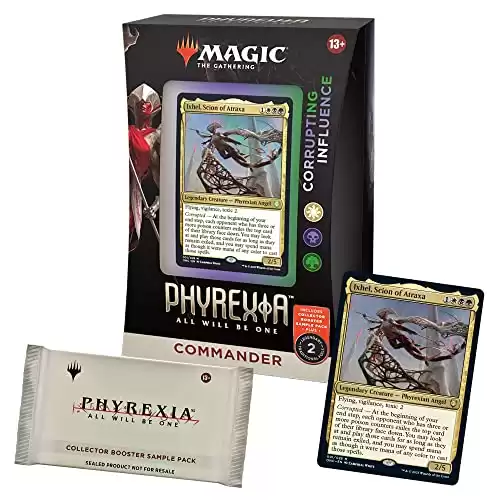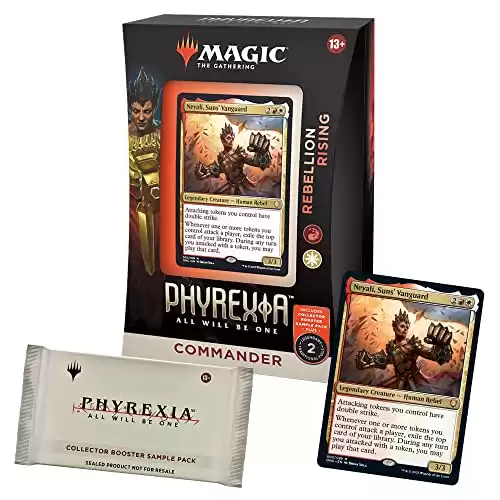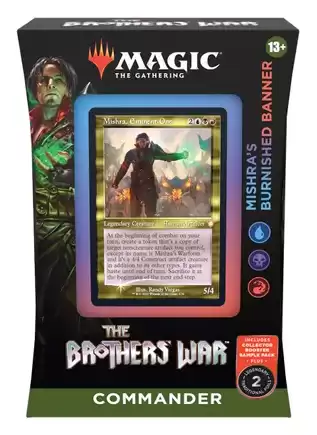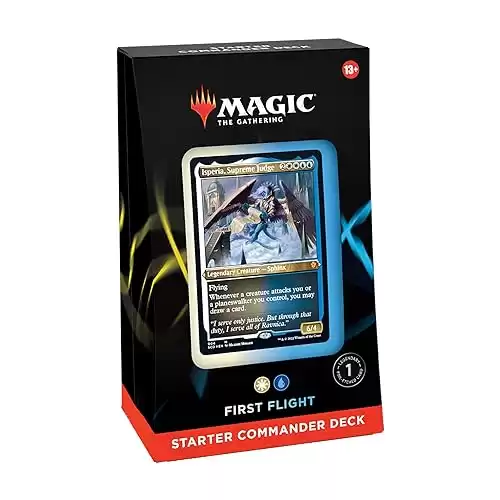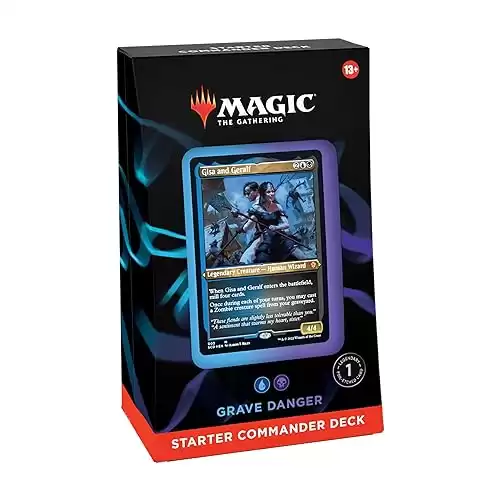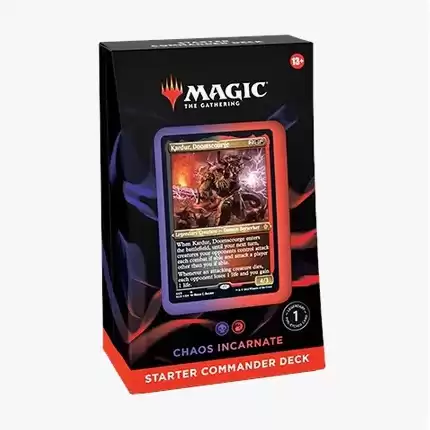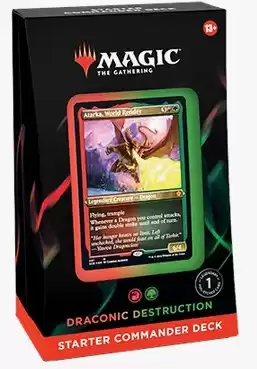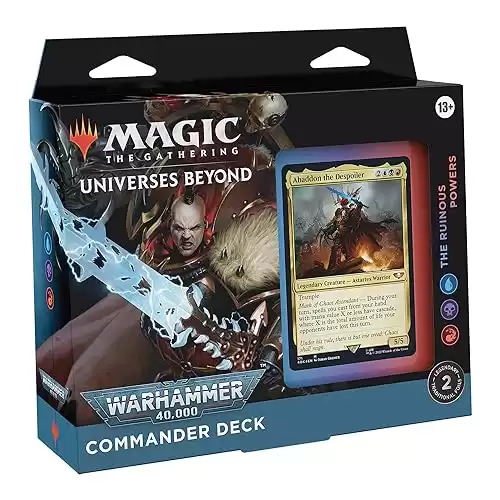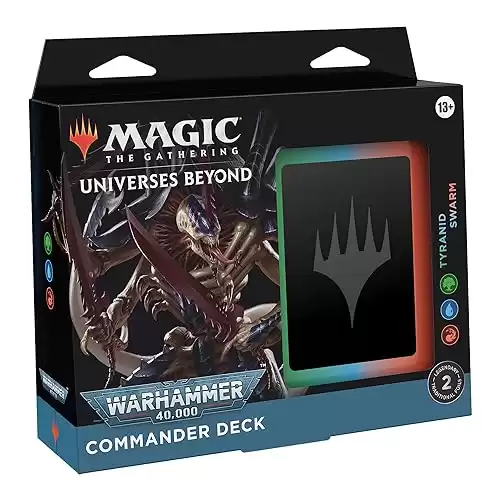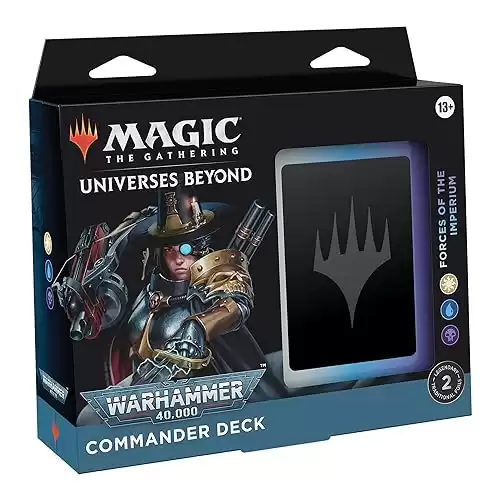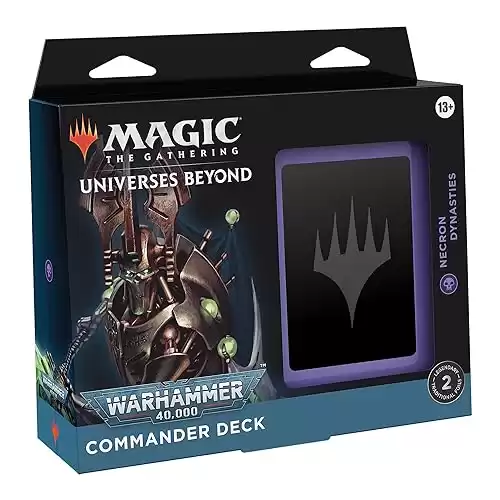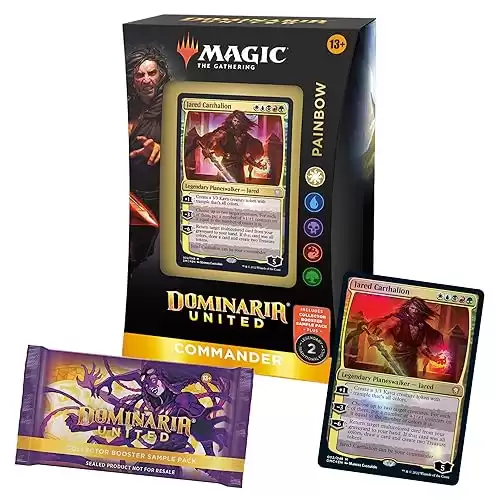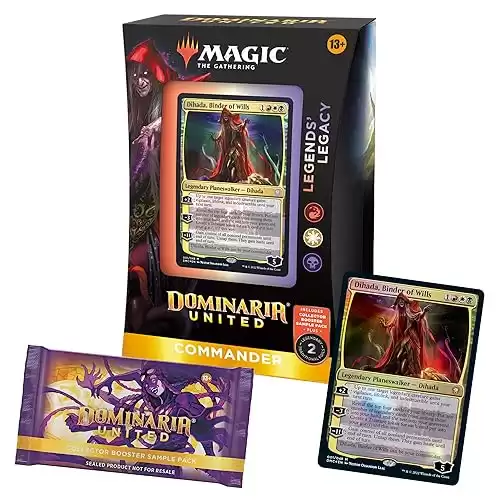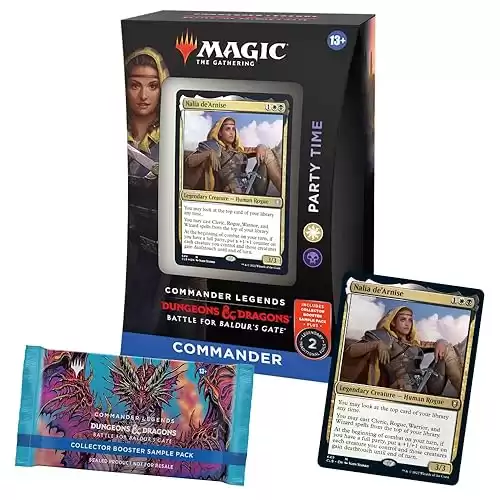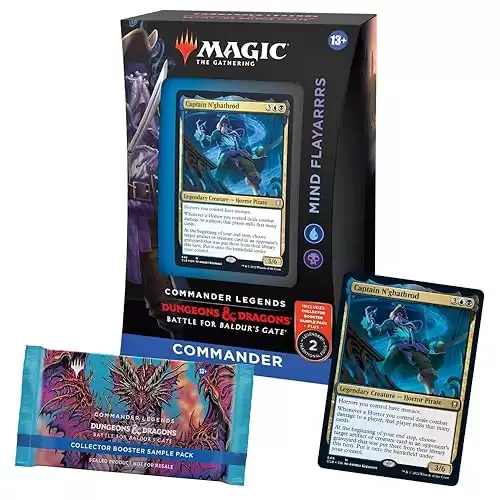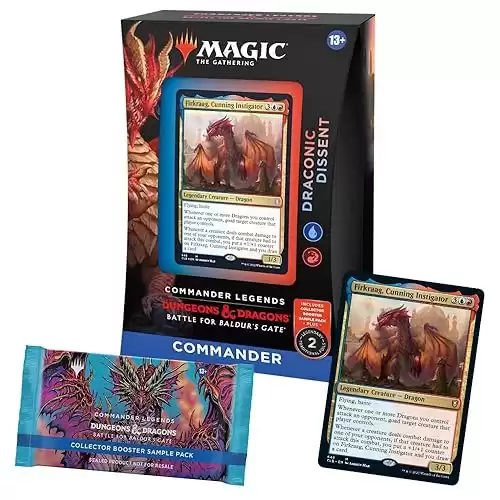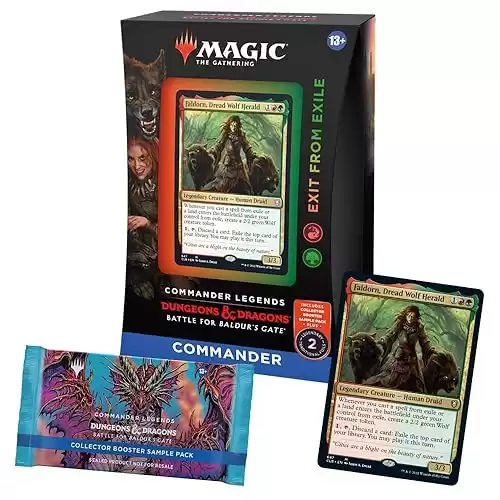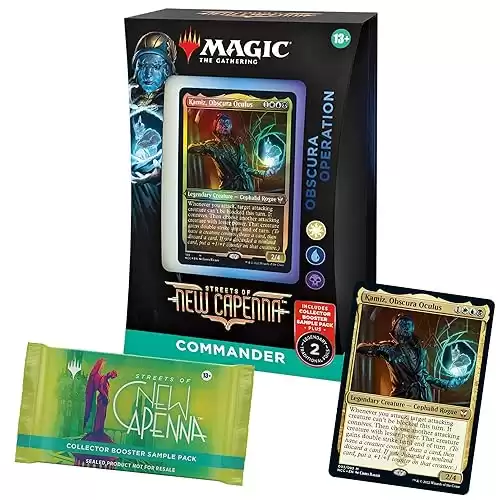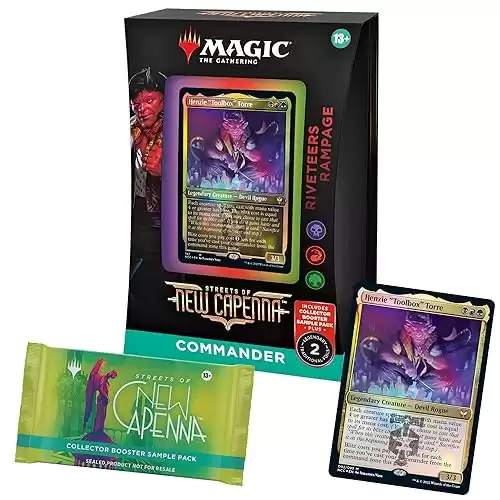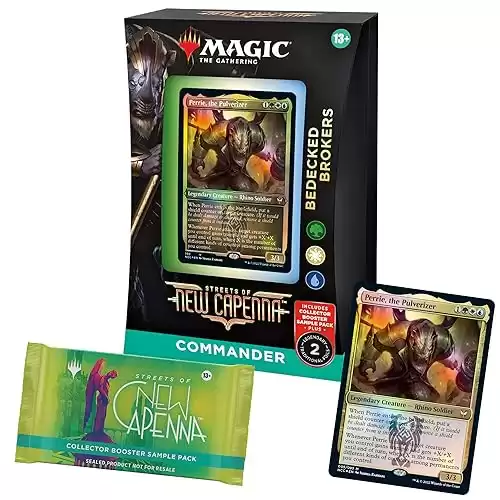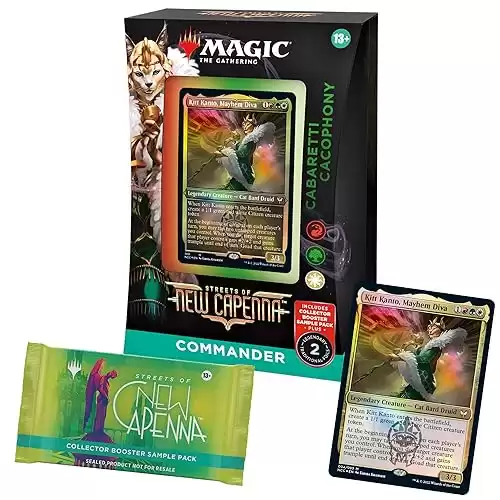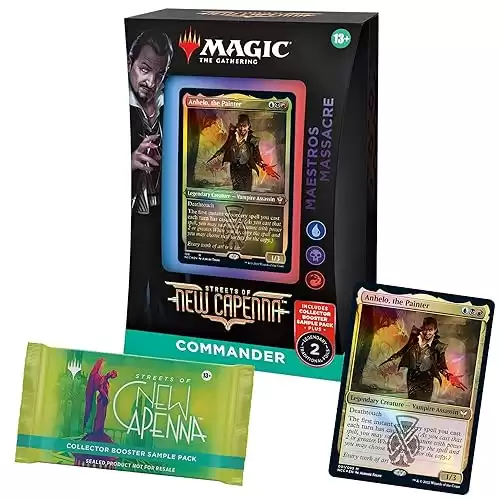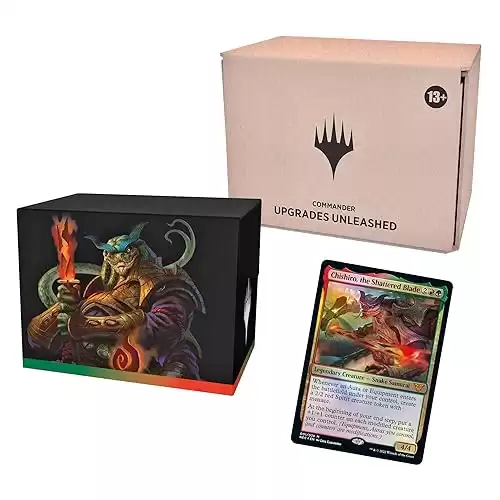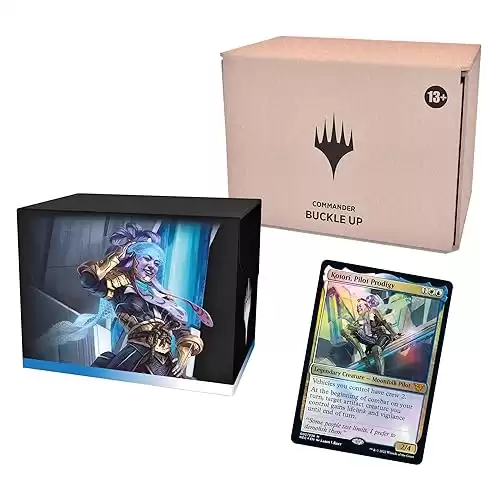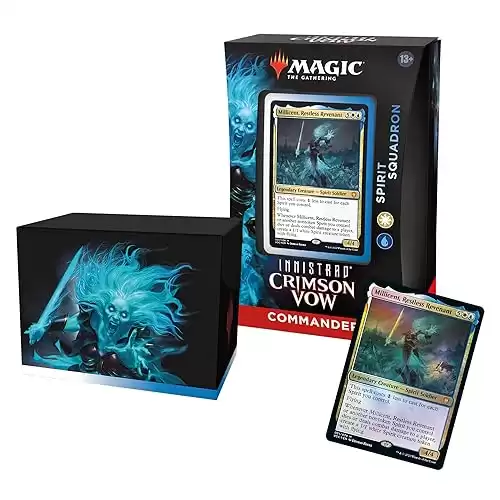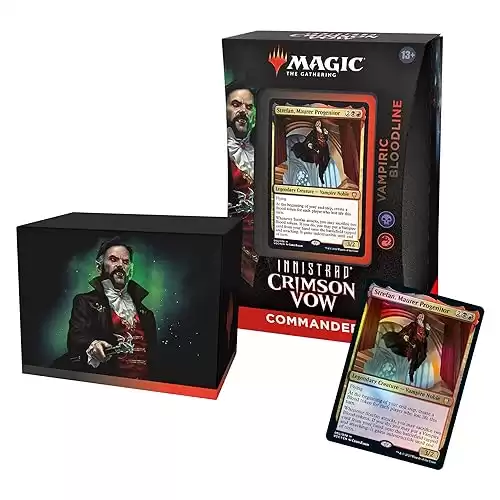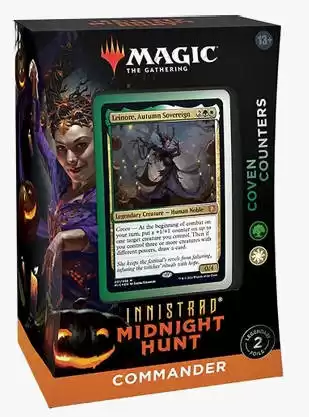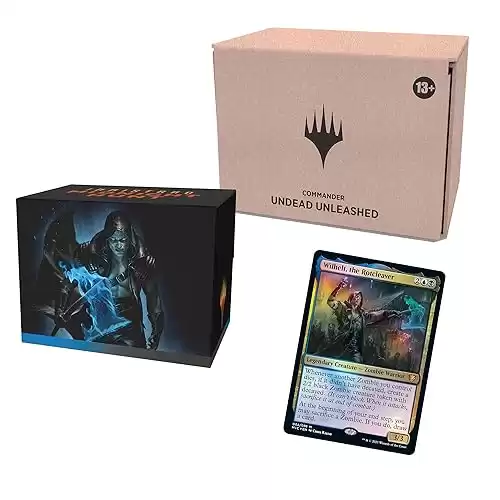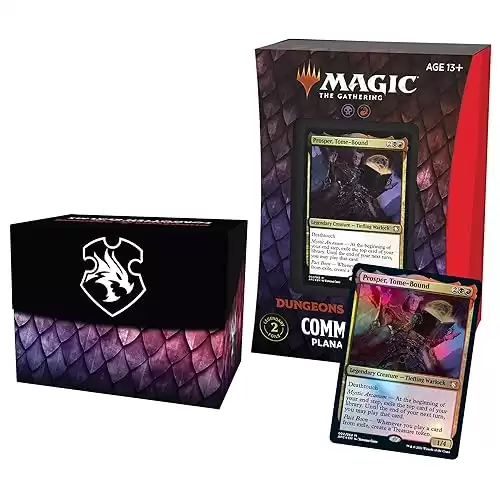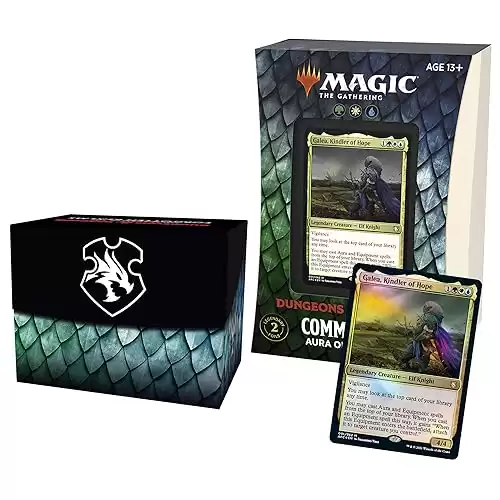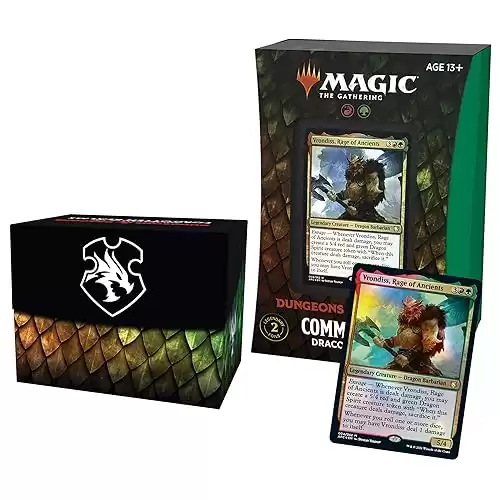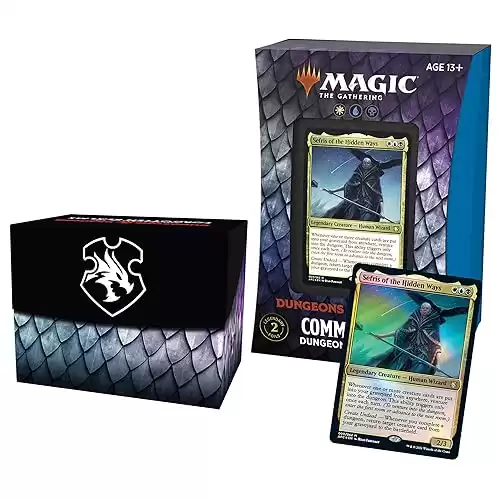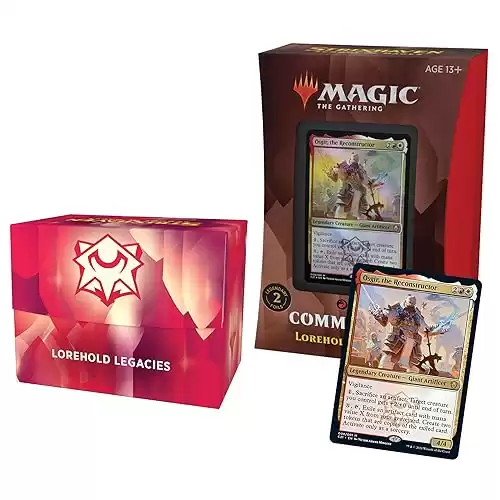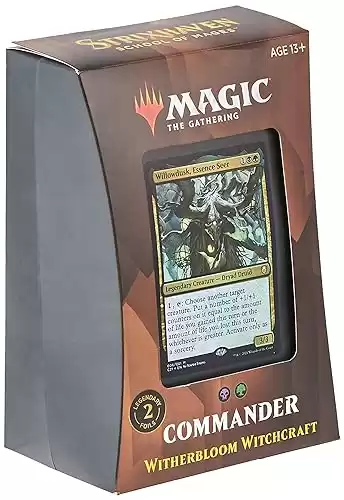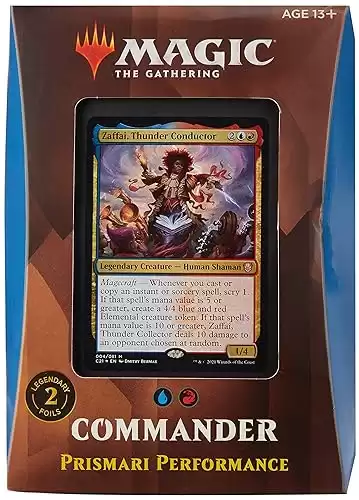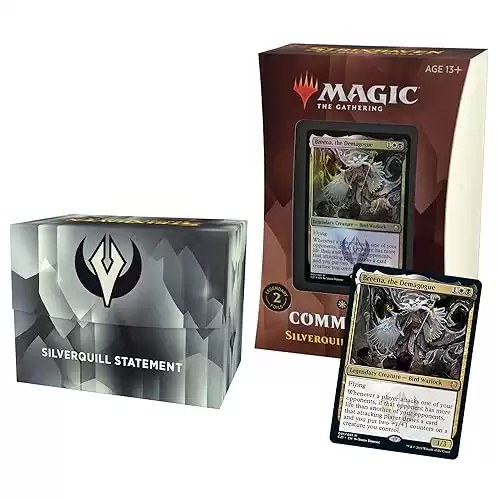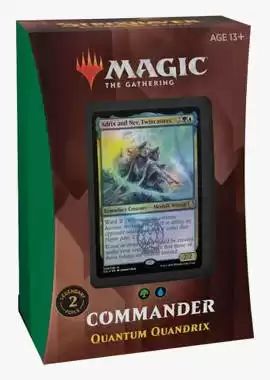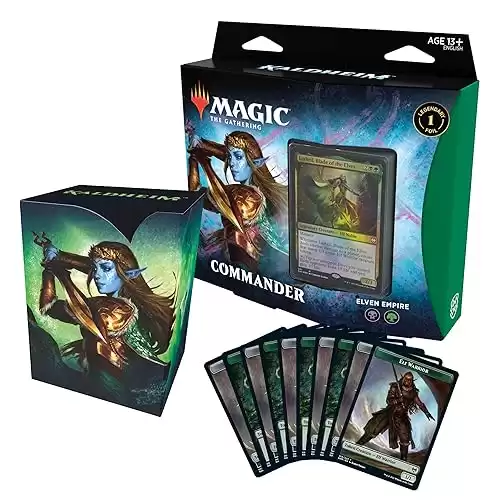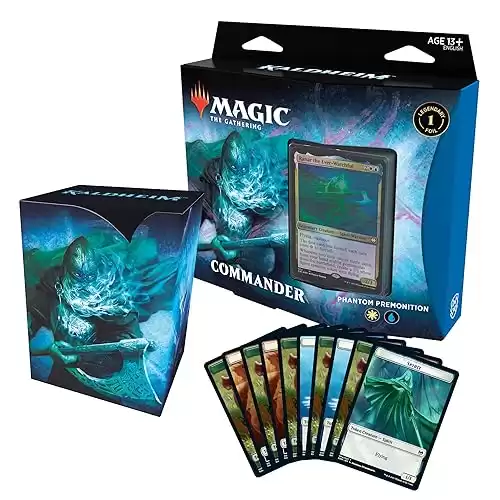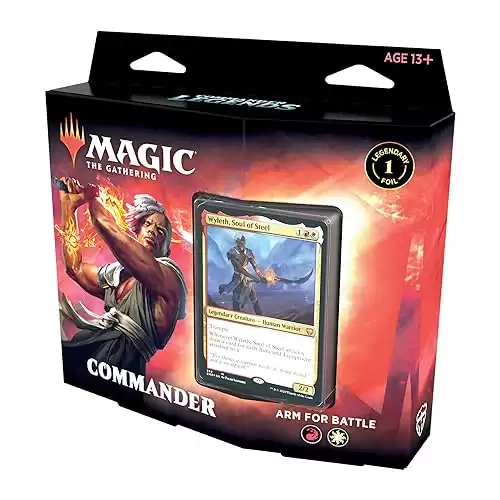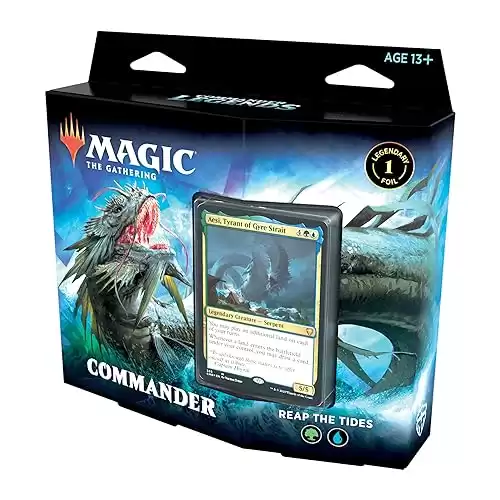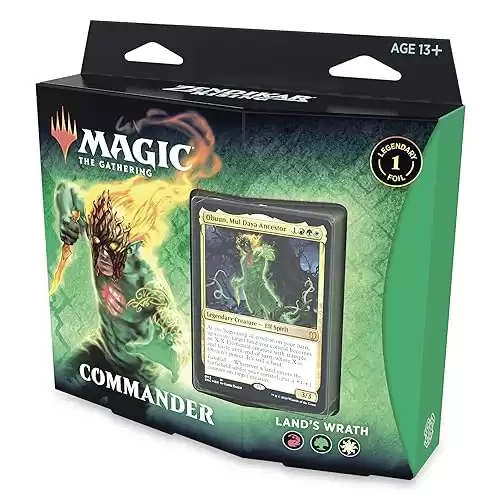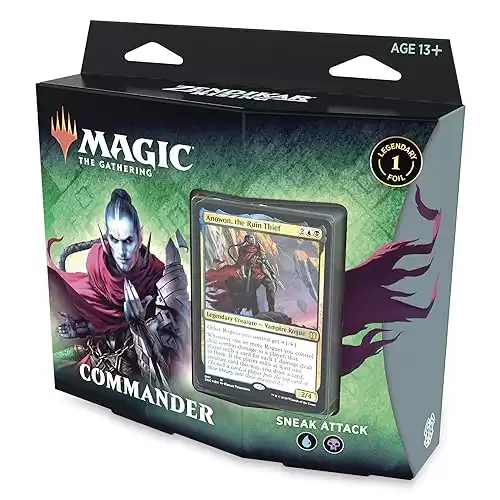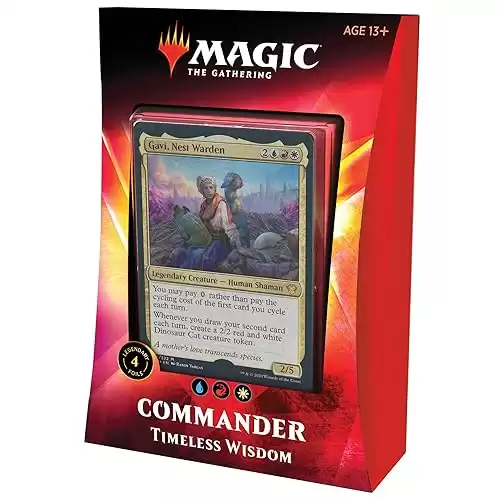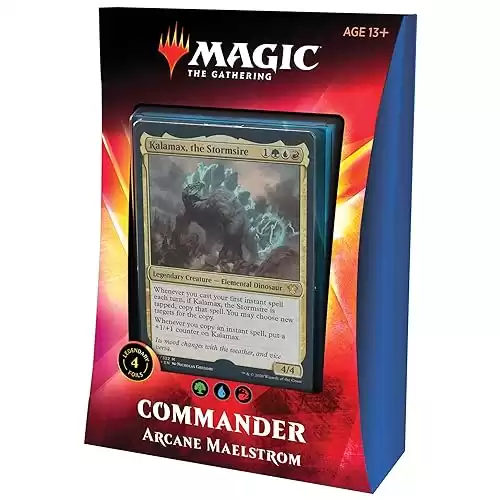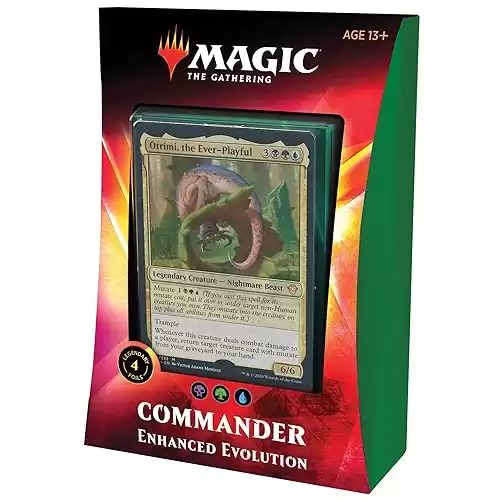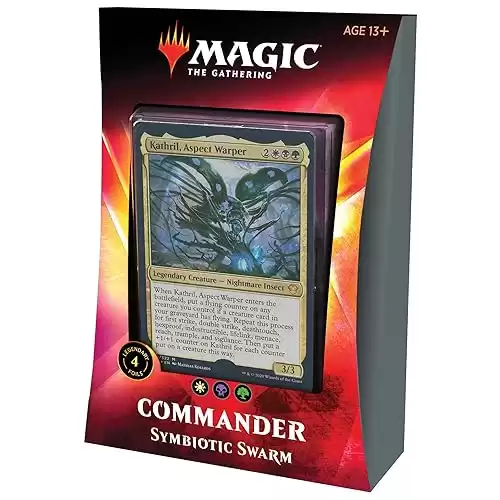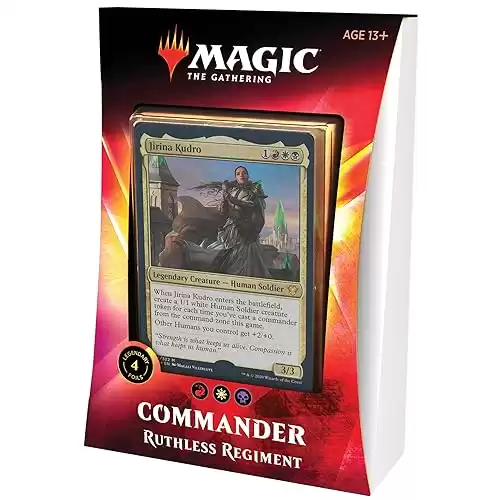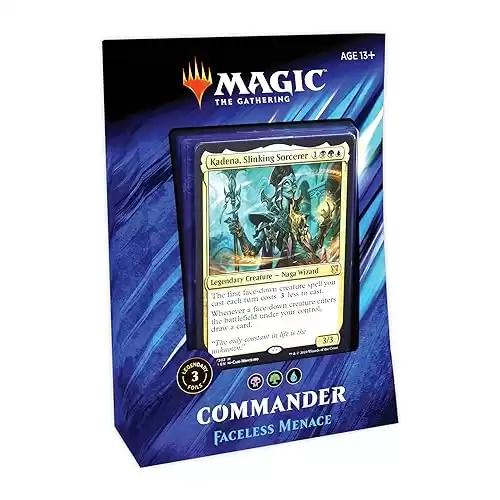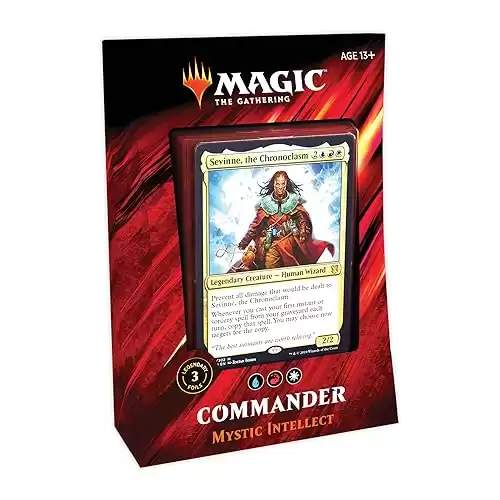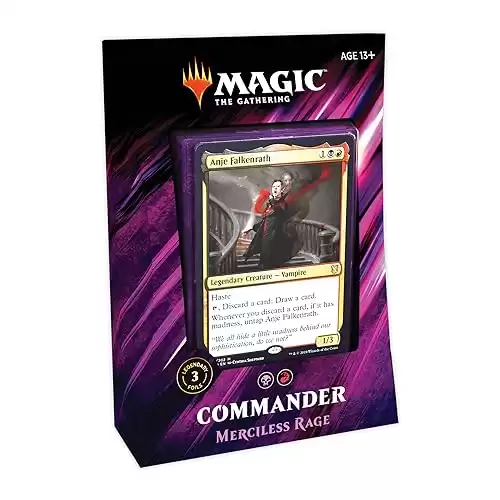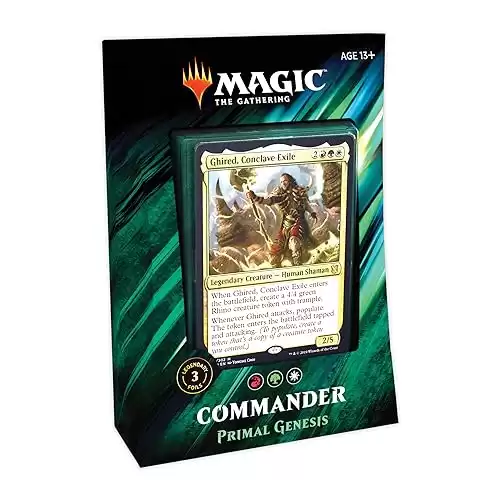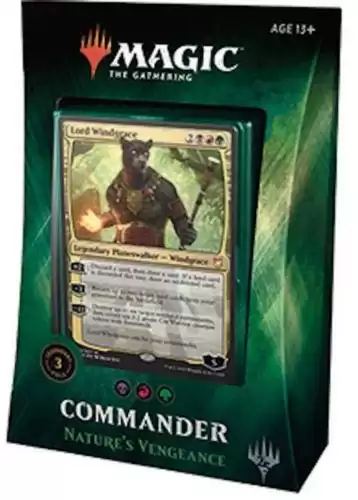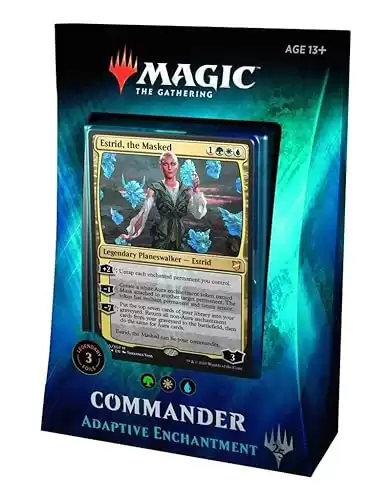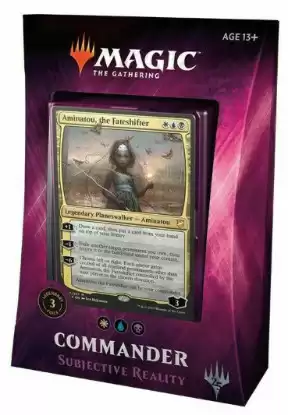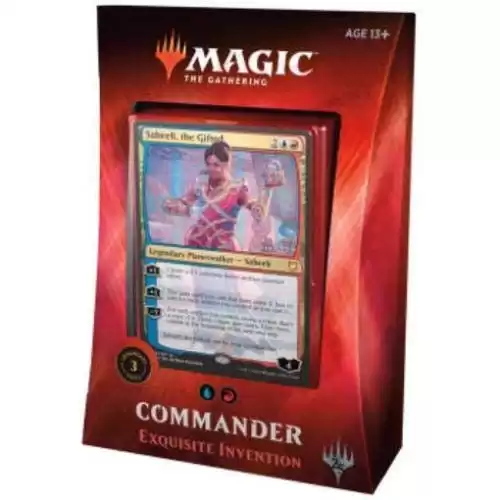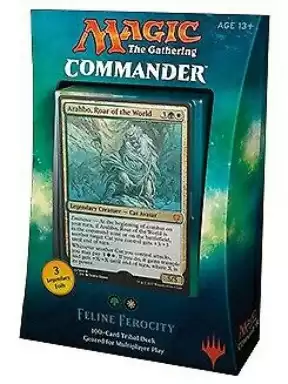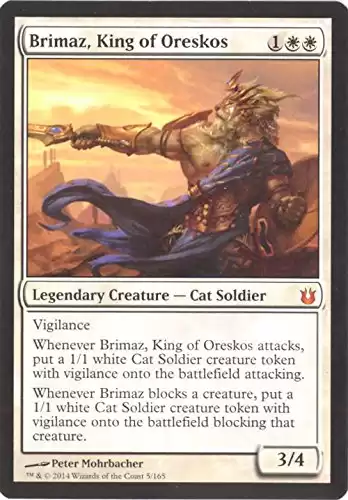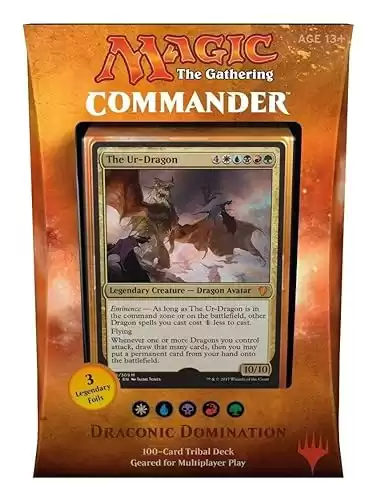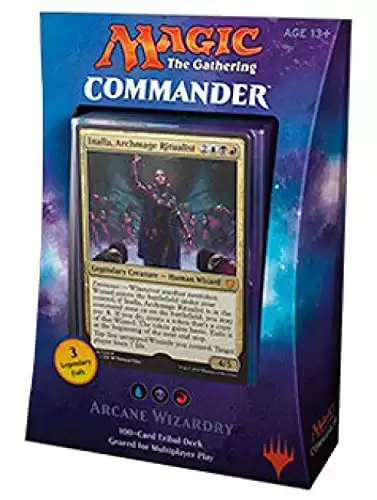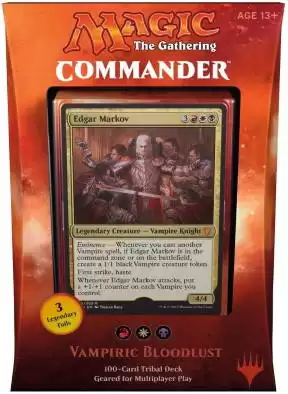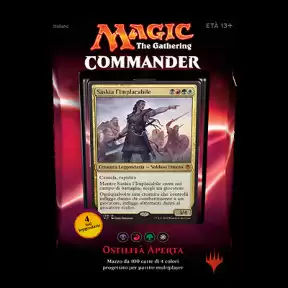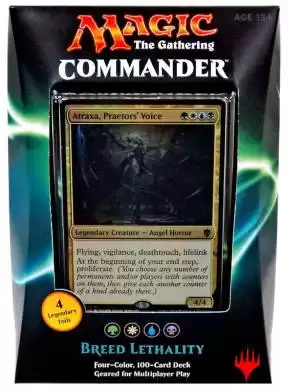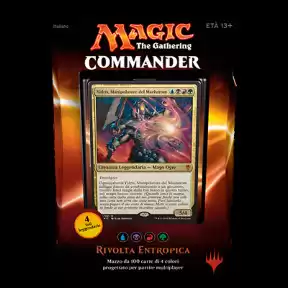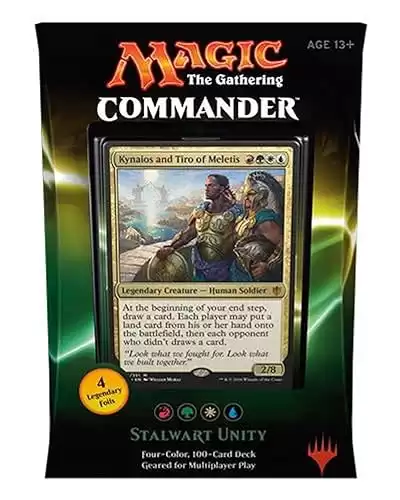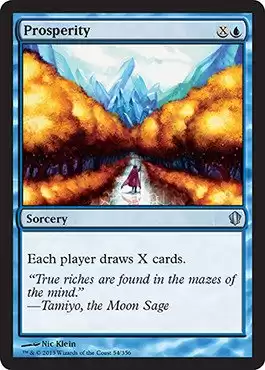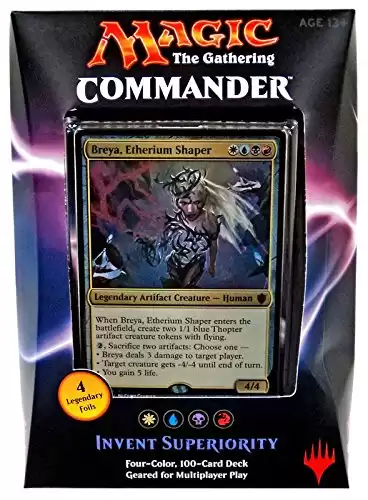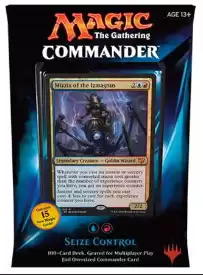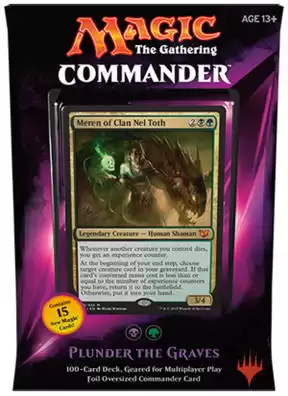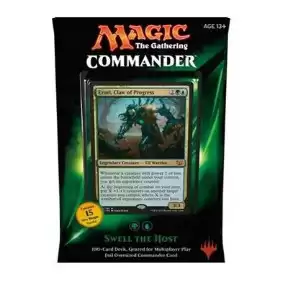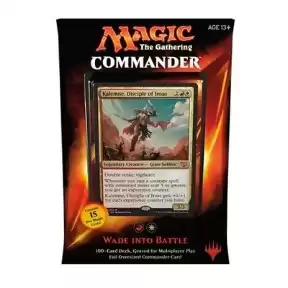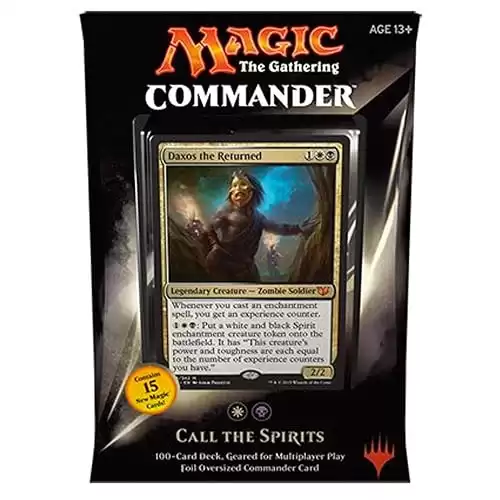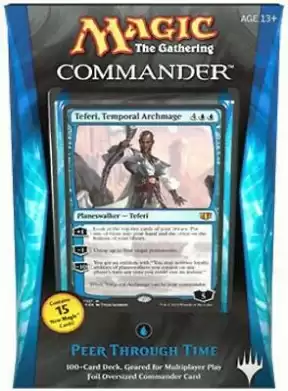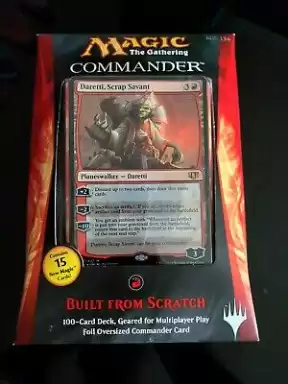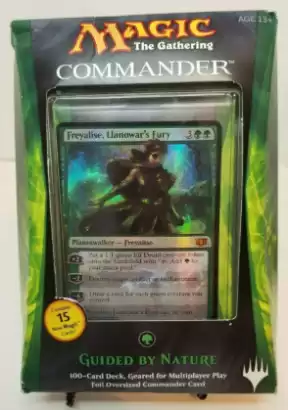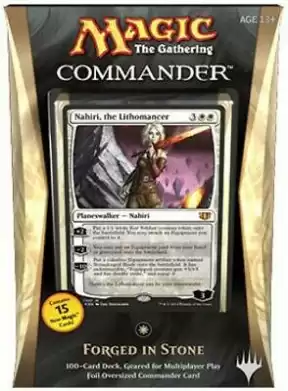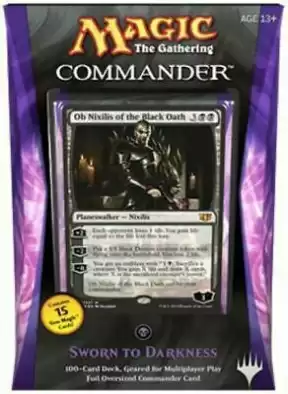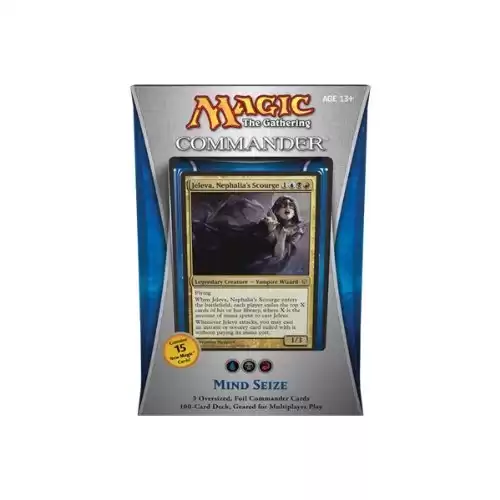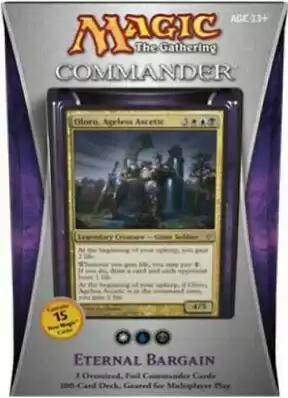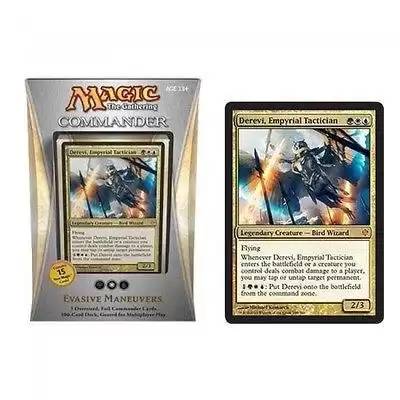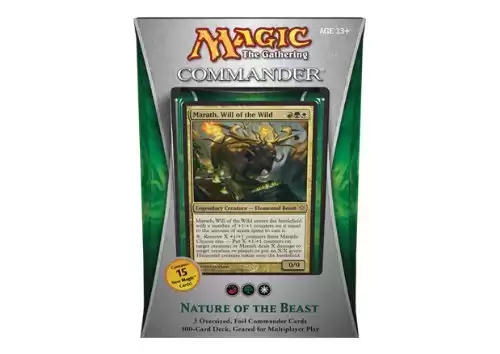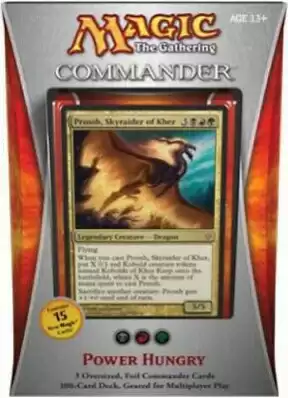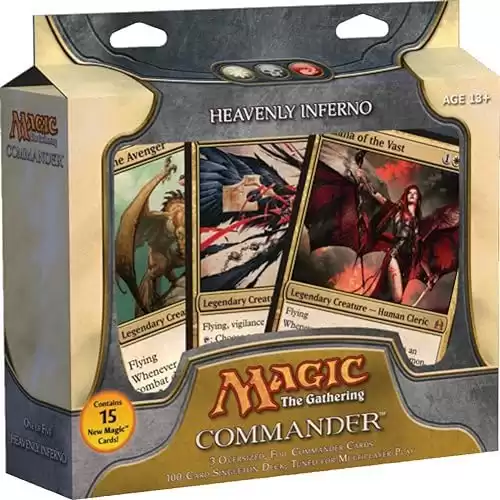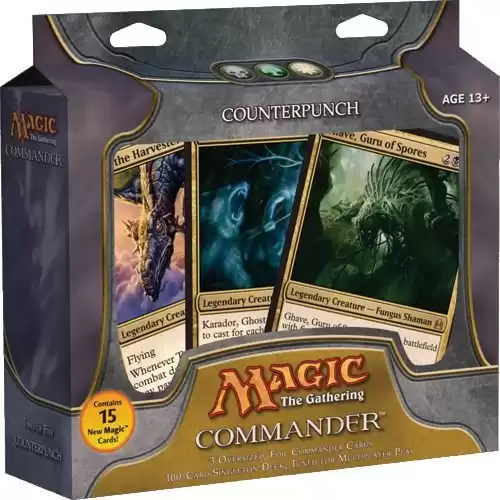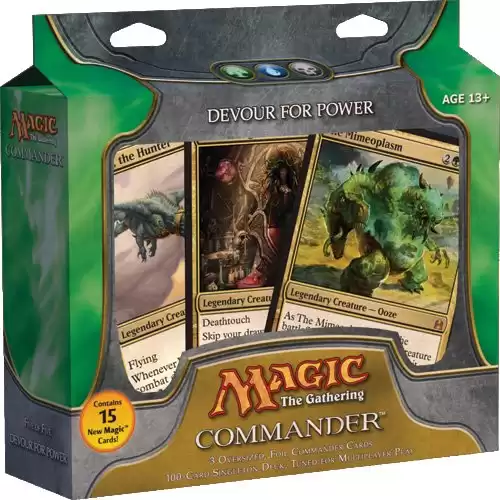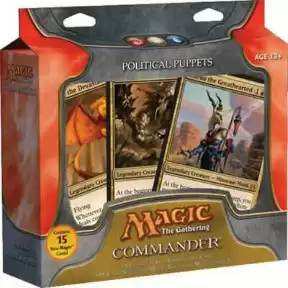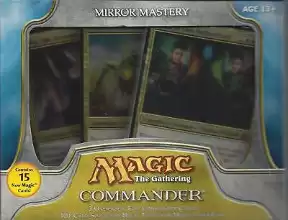Commander or “EDH” is the most popular way to play Magic: The Gathering. The format allows players to build 100 card decks using almost any card in print. This includes some of the rarest and most powerful cards in magic. While this makes the format fun, it also makes deckbuilding difficult and quite expensive at times. To mitigate this and make the beloved format assessable to all players, wizards of the coast release a set of preconstructed commander decks, called “precons” with each set.
Commander precons are prebuilt, 100-card decks that are themed around the set they release with. They contain everything a player needs to play a game of commander straight out of the box.
Commander precons are made to be an entry point into the format for new players. However, they contain between 50 and 60 new commander cards with each release. So, they are great supplementary products for even veteran players. Precons are also the premier place for much-needed commander reprints.
The line of commander precons started in 2011 and release quarterly, with most releases containing four or five decks. With that said, upon the release of the decks for Phyrexia: All Will Be One, there are a total of 85 commander precons released.
Of these 76 decks, there have been decks of all colors and play strategies, each with its strength and weaknesses. Furthermore, some of these decks contain cards that have gone on to be EDH staples. Let’s take a look at each release in-depth. Including the pros and cons, strengths and weaknesses, possible upgrades, and the commander for each precon.
Table Of Contents:
- Phyrexia: All Will Be One
- The Brothers’ War
- Starter Commander Decks
- Warhammer 40k
- Dominaria United
- Commander Legends: Battle For Baldur’s Gate
- Streets Of New Capenna
- Kamigawa: Neon Dynasty
- Innistrad: Crimson Vow
- Innistrad: Midnight Hunt
- Adventures in the Forgotten Realms
- Strixhaven: School Of Mages
- Kaldheim
- Commander Legends
- Zendikar Rising
- Ikoria: Lair of Behemoths
- Commander 2019
- Commander 2018
- Commander 2017
- Commander 2016
- Commander 2015
- Commander 2014
- Commander 2013
- Commander 2011
Phyrexia: All Will Be One
Corrupting Influence
Primary Commander:
Ixhel, Scion of AtraxaColors:
White, Black, Green
Strength Out Of The Box:
The corrupted Influence precon gives Infect a slower, less aggressive, value-based approach to victory. Being able to generate some value via Ixhel, Scion of Atraxa exiling opposing cards at three poison counters makes the deck versatile and able to play a longer, more resilient game.
That said, the deck is packed with ways to proliferate the number of counters each opponent has and is still capable of knocking out opponents early and out of nowhere. However, the precons greatest strength is its ability to start to generate value long before it gets to the tenth poison counter.
How The Deck Works:
The main focus of the deck is to get each opponent to at least three poison counters to turn on the “corrupted” mechanic online. Once each player is adequately corrupted, the deck can start to trigger things like Ixhel, Scion of Atraxa, Geth’s Summon, and Wurmquake.
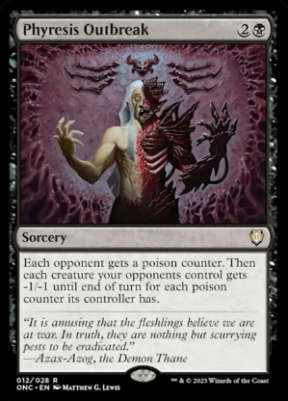
The deck can and at times will win via poison counters. However, given that the deck is centered around Toxic and not traditional Infect the creatures can still deal combat damage to opponents and it isn’t out of the realm of possibility that the deck can take some opponents out by combat as well.
Notable Cards:
| Pros | Cons |
| Can ko opponents quickly via poison counters | Has to get corrupted online to function well |
| Generates value without being at 10 poison counters | |
| Resilient to removal |
Upgrades:
The upgrades here are me leaning further into the slower, more methodical “gradual Infect” plan. So, getting early poison counters onto each opponent will be very important in the early game, and then we’ll aim to proliferate our way to victory once the value engine is up and running.
Related: Corrupting Influence: Commander Precon Upgrade Guide
In: Yawgmoth, Thran Physician, Skithiryx, the Blight Dragon, Phyrexian Crusader, Ajani, Sleeper Agent, Inkmoth Nexus, Planewide Celebration, Blighted Agent
Out: Phyrexian Rebirth, Norn’s Annex, Trailblazer’s Boots, Chromatic Lantern, Scavenging Ooze, Path of Ancestry, Grafted Exoskeleton
Rebellion Rising
Primary Commander:
Neyali, Sun’s VanguardColors:
White, Red
Strength Out Of The Box:
Right out of the box, this deck has a few things going for it. First, is the streamlined, straightforward gameplan. Almost every card in the deck works toward what the deck wants to be doing – Which is creating and attacking with tokens. The second thing is card advantage.
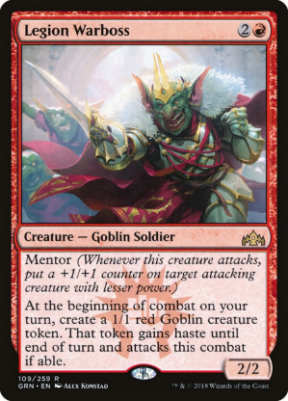
The primary commander Neyali, Sun’s Vanguard will give you access to the top cards of your library whenever you attack a player with a token. This is going to trigger a lot and gives the deck the gas it needs to close out games and recover after
How The Deck Works:
This is one of the more straightforward and streamlined strategies. Simply put, the deck wants to create tokens, turn them sideways, and give them double strike with Neyali, Sun’s Vanguard. Not only does this give the deck a ton of attacking power, but also generates card advantage with Neyali, Sun’s Vanguard’s ability, and cards like Mentor of the Meek.
Notable Cards:
Pros And Cons:
| Pros | Cons |
| Streamlined gameplan | Needs to keep Commander out |
| Aggressive | Struggles against |
| Commander has built-in card advantage |
Upgrades:
The upgrades here are going to be simple and look to make what the deck is already doing even better. This means ramping up token production, bolstering the deck’s overall attack power, and adding in some cards to increase the deck’s ability to be consistent.
Related: Rebellion Rising: Commander Precon Upgrade Guide
To make room for our upgrades I’ll be cutting the weakest links and cards that don’t contribute to the overall gameplan mentioned above.
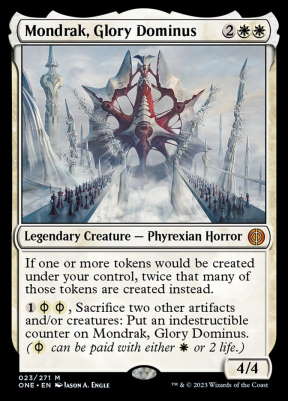
In: Divine Visitation[, Moraug, Fury of Akoum, Hero of Bladehold, Professional Face Breaker, Bennie, Bracks Zoologist, Mondrak, Glory Dominus
Out: Staff of the Storyteller, Prava of the Steel Legion, Mask of Memory, Cut a Deal, Mace of the Valiant, Vulshok Factory
The Brothers’ War
Mishra’s Burnished Banner
Primary Commander:
Mishra, Eminent OneColors:
Blue, Black, Red
Strength Out Of The Box:
This deck plays great from the box. The deck has amazing synergy and generates a lot of value for being aggressive with its artifact duplication and attacking. Making mana rocks or utility artifact tokens that are also creatures makes the deck extremely versatile.
For example, Mishra, Eminent One can make a copy of a Sol Ring and make it a 4/4. However, you don’t have to attack with it if you’d rather tap it for mana. This means every artifact in the deck can be a solid attacker or used for its original purpose.
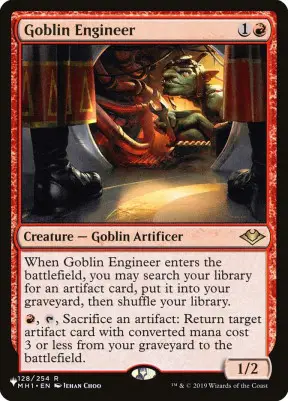
How The Deck Works:
Mishra, Eminent One lets you create a token copy of a non-creature artifact that is also a 4/4 each turn. However, the token copy has to be sacrificed at the end of the turn. This means the deck plays tons of mana-producing or utility artifacts that have good enter or exit the battlefield triggers.
Turning cards like Ichor Wellspring Servo Schematic or Mycosynth Wellspring into 4/4 allows you to generate tons of value and attack with a free 4/4 each turn. The deck also has a small sub-theme of reanimating artifacts from the graveyard and cards that reward you when you sacrifice an artifact and coping artifact abilities.
Notable Cards:
Pros And Cons:
| Pros | Cons |
| Very streamlined | Some cards are lackluster with commander out |
| Versatile | Prone to running out of gas |
| Generates value while creating attackers |
Upgrades:
The upgrades here may look a little strange. Let me elaborate on my choices. From playing the deck I find that given the deck wants to sacrifice its artifacts that I would like more ways to refuel my hand. So, cards like Black Market Connections can draw some extra cards, while also creating artifacts.
In: Determined Iteration, Arcum Dagsson, Goblin Engineer, Obeka, Brute Chronologist, Deadly Dispute, Black Market Connections
Out: Hellkite Igniter, Idol of Oblivion, Traxos, Scourge of Kroog, Mnemonic Sphere, Executioner’s Capsule, Glint Raker
Urza’s Iron Alliance
Primary Commander:
Urza, Chief ArtificerColors:
White, Blue, Black
Strength Out Of The Box:
I like a lot about this precon and a lot of the strength out-of-the-box comes from Urza, Chief Artificer, and the decks overall consistently. Urza cares about artifacts and can make artifacts himself. Next, he gives your artifacts evasion. Lastly, the deck is loaded with artifact creatures and cards that create them. This makes it highly consistent and fairly aggressive.
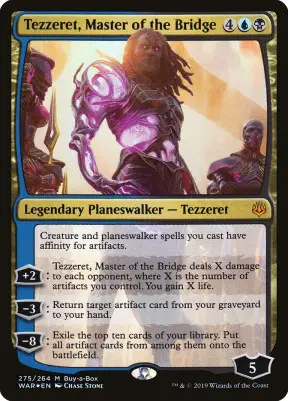
How The Deck Works:
Urza, Chief Artificer incentivizes a go-wide artifact strategy. The more artifacts you have, the less Urza will cost to cast and the bigger Golem Tokens he’ll make. There are a few ways the deck can make a
This is mainly done with Thopter Tokens with cards like Sai, Master Thopterist and Thopter Spy Network. However, there are plenty of other cards (Myr Battlesphere) that create Servo, Myr, Construct, or Golem tokens.
Once the deck has built a nice
Notable Cards:
Pros And Cons:
| Pros | Cons |
| Aggressive | Needs to keep a big |
| Streamlined | Struggles against |
| Commander gives evasion |
Upgrades:
As mentioned above, the deck is pretty focused. That said, there are some more efficient artifacts that could be included. So, I’ll be switching some of the weaker/overcosted cards more efficient options. This includes upgrades to creatures, boardwipes, and adding in more artifact protection to the deck.
In: Organic Extinction, Mirrodin Besieged, Tezzeret, Master of the Bridge, Padeem, Consul of Innovation, Phyrexian Metamorph, Shimmer Myr
Out: Angel of the Ruins, Urza’s Ruinous Blast, Ethersworn Adjudicator, Kayla’s Music Box, Etched Champion, Filigree Attendant
Starter Commander Decks
First Flight
Primary Commander:
Isperia, Supreme JudgeColors:
Blue, White
Strength Out Of The Box:
I’ve played a lot of flying tribal in commander and have picked up on the archetype’s strengths pretty well. Evasion on creatures is good and this deck is evasion tribal. There will be games where you will win simply because one or more opponents aren’t prepared to block flyers.
On the other hand, having so many creatures with flying can be a lifesaver on defense too. First, if flyers come your way you’ll always have blockers. That said, in my experience, players won’t even bother sending their flying threats your way because they know they won’t get through.
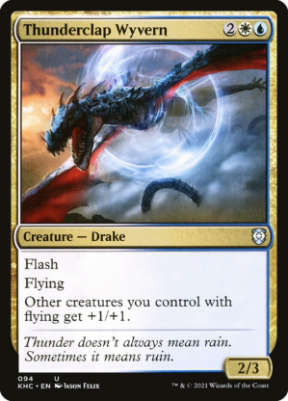
In summary, the deck generates value on top of being offensively and defensively sound. Lastly, almost every card in the deck works directly toward the game plan and this makes First Flight very focused and concise.
How The Deck Works:
This is a flying matters deck. So, it incentivizes playing creatures with flying, rewards you for doing so, and wants to win games attacking in the air. Some good examples of flying matters cards are Skycat Sovereign, Warden of Evos Isle, Jubilant Skybonder, Kangee, Sky Warden, and Thunderclap Wyvern.
Notable Cards:
Pros And Cons:
| Pros | Cons |
| Creatures have evasion | Commander is more of a support card |
| Good against opposing flyers | Needs multiple creatures to play well |
| Good on offense and defense |
Upgrades:
There won’t be any changes in strategy or massive overhauls here. My upgrades will simply be adding in powerful fliers and flying payoffs that weren’t included in the stock list.
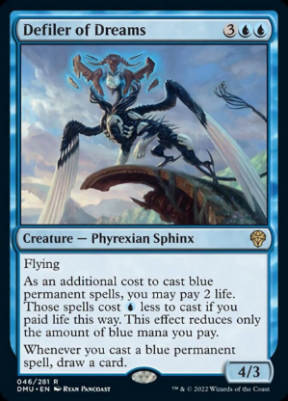
In: Defiler of Dreams, Dream Trawler, Azor, the Lawbringer, Watcher of the Spheres, Dovin’s Veto, Windborn Muse, Pteramander[/c]
Out: Skyscanner, Kangee’s Lieutenant, Soul Snare, Vow of Duty, Angler Turtle, Aven Gagglemaster, Gideon Jura
Grave Danger
Primary Commander:
Gisa and GeralfColors:
Blue, Black
Strength Out Of The Box:
Gisa and Geralf let you cast a zombie from your graveyard once on your turn. What i like about having them as the general for the deck is that it also gives you a way to put creatures into the graveyard as well. This means that you’ll never be stuck with one and not the other. This really helps to make the deck consistent and play smoothly.
Next, I like the Tribal and reanimation synergy here because essentially fuels itself simply by playing Magic. What I mean by this is – The deck plays nearly 30 Zombie creatures that will end up in the graveyard over the course of a game even without any special setup. Overall, the deck is very synergistic and its game plan doesn’t take much to get online and firing.
How The Deck Works:
Grave Danger is a Zombie Tribal deck with a focus on milling cards into the graveyard so they can be reanimated later. Cards like Geralf’s Mindcrusher, Liliana, Untouched by Death, and Gisa and Geralf are used to fill the graveyard. While Cruel Revival, Victimize, and Grimoire of the Dead are amongst the cards used to retrieve whatever you mill.
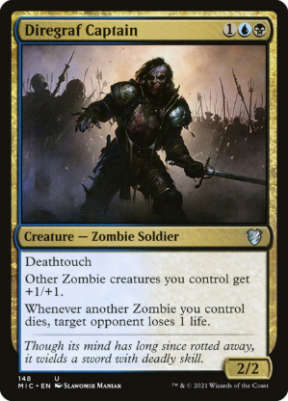
Lastly, the deck has tons of ways to create Zombie tokens and pump up its horde. Cards like Champion of the Perished, Cemetery Reaper, Grey Merchant of Asphodel, and Army of the Damned can all bolter or create Zombies that can close out games.
Notable Cards:
Pros And Cons:
| Pros | Cons |
| Strong tribal synergies | Commander can only reanimate single creatures |
| Casts spells from graveyard | |
| Commander is a payoff and enabler |
Upgrades:
The upgrades here are not huge ones – The deck is very well aware of what it wants to be doing and does a pretty solid job of it. That said, I will be switching out some of the over-costed and/or underperforming cards for better interaction, some more Tribal synergies, and a few powerful Zombies missing from the stock list.
In: Wilhelt, the Rotcleaver, Death Baron, Gravecrawler, Necroduality, Counterspell, Murderous Rider, Rooftop Storm, Stitcher’s Supplier, Black Market Connections
Out: Gravespawn Sovereign, Overseer of the Damned,Vela the Night-Clad, Withered Wretch, Undermine, Murder, Grimoire of the Dead, Chaos Incarnate, Vampiric Rites
Chaos Incarnate
Primary Commander:
Kardur, DoomscourgeColors:
Black, Red
Strength Out Of The Box:
There is a lot to like about Chaos Incarnate right out-of-the-box. First, I’ve found that forcing opponents to attack when they’d rather not to be quite disruptive to opposing game plans. Chaos is the name of the deck and the deck does it well.
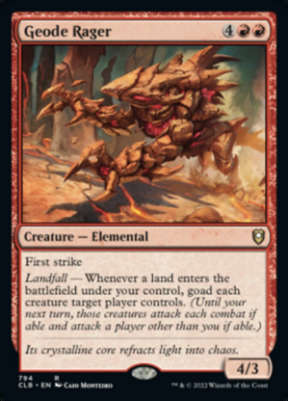
Secondly, the deck produces quite a bit of damage. It primarily does this by forcing opponents to attack one another but it also has a multitude of damage-dealing spells. Lastly, the deck has good removal and tons of cards that are powerful enough to be win-cons. The deck has very good raw power and a stellar threat density.
How The Deck Works:
The deck wants to create havoc by forcing opponents to attack and making sure those attacks are going toward opponents. Naturally, this pressing of the action means life totals will get low quickly. So, the next thing the deck wants to be doing is damaging opponents as often as possible with burn or drain spells. Then with everyone weakened it can come in a deliver the coups de grâce with one of its many threats.
Notable Cards:
Pros And Cons:
| Pros | Cons |
| Aggressive | Slow starter |
| Great Density | Needs commander to stay out |
| Disruptive to opponents gameplan |
Upgrades:
The upgrades here are focused on a few things. First, I wanted to add in a few more ways to goad opposing creatures into attacking. Ways to further reward players for pointing their attacks at other players and a few potent burn spells.
In: Blood for the Blood God!, Karazikar, the Eye Tyrant, Frenzied Saddlebrute, Varchild, Betrayer of Kjeldor, Conjurer’s Closet, Shiny Impetus
Out: Magmatic Force, Vampire Nighthawk, Explosion of Riches, Ob Nixilis Reignited, Kaervek the Merciless, Thermo-Alchemist
Draconic Destruction
Primary Commander:
Atarka, World RenderColors:
Red, Green
Strength Out Of The Box:
What makes Draconic Destruction good? Well, first of all Dragons are a usually very powerful as a tribe and many have evasion. This alone makes it play some pretty good Magic right from the box.
Next, is having Atarka, World Render as the commander. As I mentioned, Dragons are already powerful and she makes each one twice as powerful. She does cost a lot of mana but the deck is in great colors to ramp into her and even a single attack with her on the field can be game ending.
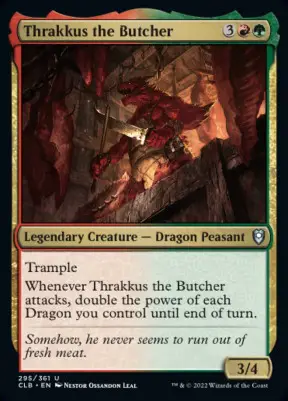
How The Deck Works:
This deck is about as simple as they come – And it is streamlined for it. It wants to ramp and play Dragon cost reduction spells like Dragonlord’s Servant early and cast big Dragons ahead of curve.
Once you’ve established any type of a
Notable Cards:
Pros And Cons:
| Pros | Cons |
| Powerful creatures | High CMC commander |
| Strong tribal payoffs | High CMC commander |
| Good ramp |
Upgrades:
The deck has most everything you’d want for a Dragon Tribal deck and not a lot you don’t. However, there are some changes to be made. First, I removed the few creatures that didn’t add much to the Dragon theme.
Next, I took out a few of the underpowered Dragons for some better ones. Lastly, I switched some of the more conditional removal for better stuff and added another way to give creatures haste.
In: Thrakkus the Butcher, Lathliss, Dragon Queen, Carnelian Orb of Dragonkind, Earthquake Dragon, Blasphemous Act, Rhythm of the Wild
Out: Provoke the Trolls, Loaming Shaman, Furnace Whelp, Mordant Dragon, Dragon Mage, Token Triumph
Primary Commander:
[c]Emmara, Soul of the Accord">Chain Reaction[/cToken Triumph
Primary Commander:
[c]Emmara, Soul of the AccordColors:
White, Green
Strength Out Of The Box:
Emmara, Soul of the Accord is a great go-wide commander for Token strategies. What I like about playing her as a commander (and a great strength out of the box) is how many clever ways there are to abuse the fact that Emmara’s ability to make a token regardless of why she’s tapped.
The best way to make use of this in the precon is convoke. Not only does it allow the deck to reduce the cost of its spells but it generates a token that can be used in the future. Lastly, things like this means that you don’t have to risk attacking with Emmara, Soul of the Accord to trigger her.
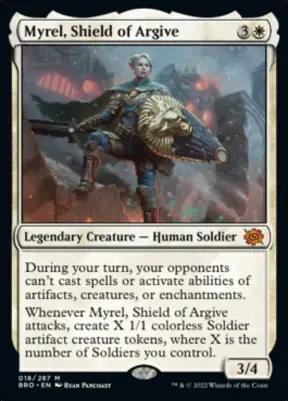
How The Deck Works:
The deck has a few simple things it wants to be doing. It wants to pump out tokens; Use those tokens to convoke out bigger, more powerful spells and pump up its token army and swing to victory with as many creatures as possible.
There is also a mild +1/+1 counter theme. While this isn’t super supported within the precon, the cards that are there will never be dead, as they can always throw counters on whatever tokens you may have.
Notable Cards:
Pros And Cons:
| Pros | Cons |
| Good synergy | Struggles against |
| Go-Wide | |
| Good ramp |
Upgrades:
For my upgrades I will be swapping out all of the non-token producing cards and many of the weak +1/+1 counter cards for more lords/anthem effects, card advantage pieces, more ways to tap Emmara down and some mana generation.
In: Tocasia’s Welcome, Myrel, Shield of Argive, Queen Allenal of Ruadach, King Darien XLVIII, Glare of Subdual, Skullclamp, Springleaf Drum
Out: Citanul Hierophants, Scavenging Ooze, Thunderfoot Baloth, Verdant Force, Great Oak Guardian, Idol of Oblivion, Slate of Ancestry
Warhammer 40k
The Ruinous Powers
Primary Commander:
Abaddon the DespoilerColors:
Blue, Black, Red
Strength Out Of The Box:
I have found the greatest strengths of the deck to be its ability to chain spells and effects to together and its ability to generate card advantage via its commander. Furthermore, considering it wants to be throwing around as much damage as possible, the deck manages to be fairly aggressive straight from the box.
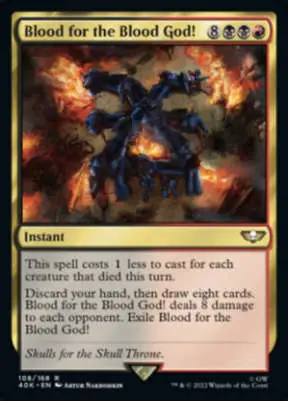
Considering the deck does have quite a few things it’s focused on, it plays cohesively and has a fair bit of support for each of the things the deck cares about.
How The Deck Works:
The Ruinous Powers has a main theme and a pretty well-supported sub-theme as well. The primary goal of the deck is to deal direct damage to opponents so that it can cascade into the biggest possible spells using the ability of Abadon the Dispoiler.
The secondary thing the deck cares about is casting creatures with the “Demon” creature type. This can be seen when looking at the secondary commander Be’lakor, the Dark Master, and support cards like Lord of Change, Great Unclean One, and Mortarion, Daemon Primarch.
My first thought when looking at the deck was that having these two separate strategies together would be pretty divisive for the deck’s resources and that neither one would get its full potential. However, after playing it I realize that I was wrong. Many of the Demons in the deck have ETB triggers that make them perfect to Cascade into using Abaddon the Dispoiler.
Notable Cards:
Pros And Cons:
| Pros | Cons |
| Aggressive | Not streamlined |
| Great removal/interaction | High CMC spells |
| Nonlinear strategies |
Upgrades:
There are quite a few ways that you could go with the upgrades for this one. For example, you could lean more into the Demon Tribal side of the deck with Be’lakor, the Dark Master. Or build more toward the direct damage portion of the deck and try to burn your opponents out of the game.
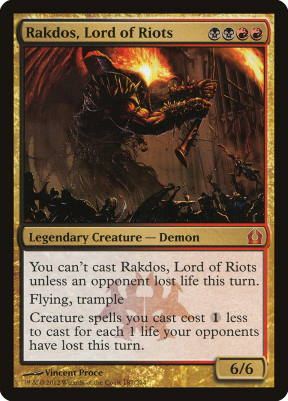
That said, I have chosen to show some love to each of these things. So, each of my upgrades will help cascade, casting things from exile, dealing damage, will be a Demon, or some combination of the four.
In: Prosper Tome-Bound, Loyal Subordinate, Profane Tutor, Ancestral Vision, Descent into Avernus, Rakdos, Lord of Riots
Out: Mortarion, Daemon Primarch, Khârn the Betrayer, Vemoncrawler, Assault Suit, Nurgle’s Conscription, Chaos Terminator Lord
Tyranid Swarm
Colors:
Green, Blue, Red
Primary Commander:
The SwarmlordStrength Out Of The Box:
There are a few things that make Tyranid Swarm a good deck. First, it can turn even its smallest creatures into legitimate threats via +1/+1 counters. Nearly, all the cards can scale into bigger and bigger threats as the game goes on. As a result, the deck has a good early game and great inevidability.
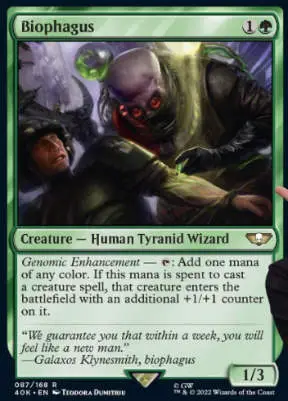
Next, the 99 cards of the deck function quite well even without The Swarmlord in play. This is a nice asset since he does cost 6 mana. On this topic though, the deck does want to be casting him several times per game and has a great ramp package right from the box to make sure that happens.
How The Deck Works:
The deck wants to swarm the
Once the deck has established a
Keeping on theme with agumenting its creatures, the deck also has an “x” spell subtheme with its Ravenous abiliy. However, unlike other x spells to come before it, you can choose to ignore the x cost all together and cast the card for its base cost. Not only does this give the deck some nice versatility it also gives you a lot of ways to trigger the deck’s secondary commander Magus Lucea Kane.
Notable Cards:
Pros And Cons:
| Pros | Cons |
| Not overly dependant on commander | Needs to maintain a boardstate |
| Good early and late game | Commander is high cmc |
| Great ramp |
Upgrades:
The upgrades for Tyranid Swarm fall into two categories – Cards that give us extra counters and cards that care about counters. On the flipside, cardsthat don’t contribute much to the counter strategy are the one’s I’ll be removing to make room for new cards.
In: Kodama of the West Tree, Animar, Soul of Elements, The Ozolith, Metallic Mimic, Rhythm of the Wild, Karn’s Bastion
Out: Genestealer Patriarch, Nexos, Goliath Truck, Ghyrson Starn, Kelermorph, Deathleaper, Terror Weapon, Genestealer Locus
Forces of the Imperium
Colors:
White, Blue, Black
Primary Commander:
Inquisitor Greyfax
Strength Out Of The Box:
The deck plays pretty well as a stock list and the primary commander at the helm allows the deck to play great offense and defense. For example, Vigilance allows all your attackers to be blockers on subsequent turns and the ability to tap down opposing creatures helps limit attacks coming your way and also get rid of would-be blockers.
With that said, I have found the same thing as many others who have played with the deck and that is – Marneus Calgar is the creature you want in the commander zone. With Marneus, each of the deck’s 22 token makers will also become card draw. He is also capable of churning out tokens himself that will trigger his ability.
How The Deck Works:
The deck wants to make tokens and go wide. Then pump those tokens up and swing its way to victory. That said, the deck has quite a few token makers, cards that care about tokens being created (Marneus Calgar being amongst the best), “attacks matter” cards, and anthem effects to get the job done.
The deck also features some aristocrat (creature-sacrificing) synergies, ways to gain life while draining opponents’ and many controlling cards as well.
Notable Cards:
Pros And Cons:
| Pros | Cons |
| Good on offense and defense | Struggles against |
| Good interaction | Primary commander is underwhelming |
| Streamlined strategy | |
| Both commanders offer card draw |
Upgrades:
As mentioned above, I think Marneus Calgar is the superior commander for the deck. That said, my upgrades will be tweaking the deck toward his play style. This will be done by adding more repeatable ways to create tokens and trigger Marneus as many times as possible.
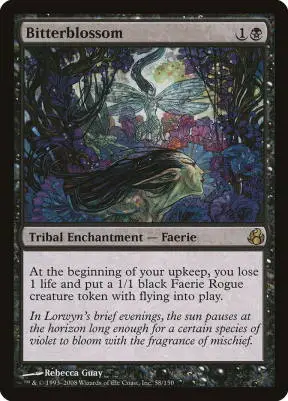
To make room for new cards I’ll be cutting the cards that don’t support the deck’s main strategy – Including cards geared towards things without much support like gaining life or reanimating creatures.
In: Felidar Retreat, Ashnod’s Altar, Monastery Mentor, Bitter Blossom, Nadir Kraken, Smothering Tithe, Grim hireling, Intangible Virtue
Out: Celestine, the Living Saint, Triumph of Saint Katherine, Assault Intercessor, Neyam Shai Murad, Exterminatus, Sanguinary Priest, Grey Knight Paragon, The Flesh Is Weak
It is worth mentioning that there is a combo among the cards I added. Marneus Calgar along with Nadir Kraken and Ashnod’s Altar creates a situation where with all cards on the battlefield you can draw your entire library. Here’s how it works:
- Have all permanents on the battlefield and draw a card with one mana available.
- When you draw a card Nadir Kraken triggers allowing you to pay one mana and create a 1/1 token.
- The token entering the battlefield triggers Marneus Calgar.
- With the Marneus Calgar trigger on the stack, hold priority and sacrifice the 1/1 token to Ashnod’s Altar for two mana.
- The Marneus Calgar trigger resolves, causing you to draw a card. This is then repeated from step two.
This loop gives you infinite card draw, infinite +1/+1 counters on Nadir Kraken, limitless colorless mana, and enter/exit the battlefield triggers.
Having explained the combo, I added the cards to the deck for how well they worked individually, not for the combo. So, if you don’t want a combo in the deck simply leave Ashnod’s Altar out of the upgrades. If you’d like to fully embrace the combo, you can add Thassa’s Oracle to make it game-winning.
Necron Dynasties
Colors:
Black
Primary Commander:
Szarekh, the Silent King
Strength Out Of The Box:
Necro Dynasties is resilient and highly synergistic. Nearly every card in the deck works toward the deck’s artifact reanimation goals. Around 20% of the deck is artifact creatures that can be milled with Szarekh, the Silent King.
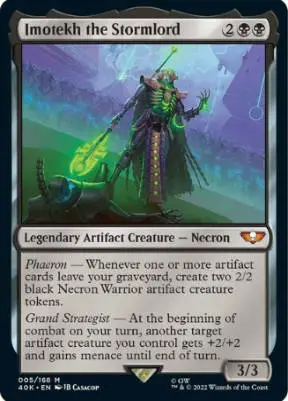
In my experience, the deck being so cohesive is its greatest strength. For example, even the deck’s mana rocks (Hedron Archive, Mind Stone, and Commander’s Sphere) all have ways of getting themselves into the graveyard if need be. Overall, the deck is as streamlined and hard to keep down as the Necrons themselves.
How The Deck Works:
Out-of-the-box the deck’s goal is to fill the graveyard with powerful artifact threats and then reanimate them. There are a plethora of ways the deck generates value from cards leaving your graveyard as well. Sometimes they go to your hand, generating card advantage. Other times you’ll generate tokens whenever an artifact leaves your graveyard.
Reanimation is the name of the game for the deck and it works hand in hand with the deck’s sub-strategy of “Unearthing” its creatures. Canoptek Tomb SentineRoyal Warden and Skorpekh Lord a few of my favorite cards with unearth from the precon.
Notable Cards:
Pros And Cons:
| Pros | Cons |
| Highly synergistic | Commander relies on a certain level of luck |
| Streamlined strategy | High mana curve |
| Great Ramp |
Upgrades:
As mentioned above, the deck is pretty focused even without upgrades. That said, there isn’t a ton of cards I found a need to switch out. However, there were a few. I swapped some of the higher CMC spells that I found to be slow or underwhelming out for cards that more directly helped the gameplan. Here’s what I changed:
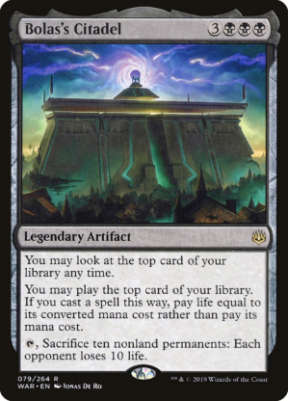
In: Krark-Clan Ironworks, Cabal Coffers, Disciple of the Vault, Marionette Master, Phyrexian Scriptures, Reanimate, Bolas’s Citadel
Out: The War In Heaven, Gilded Lotus, Endless Atlas, Swamp, Their Name Is Legion, Darkness, Sceptre of Eternal Glory
Dominaria United
Painbow
Primary Commander:
Jared CarthalionColors:
White, Blue, Black, Red, Green
Strength Out Of The Box:
The out-of-the-box strength of the precon is its strong multi-color synergy. The deck wants to cast spells of many colors, and reap rewards for it and the deck is very well aware and well built to this identity. Nearly all of the cards in the deck directly work toward the deck’s game plan without much filler.
Furthermore, while the deck is far from simple, there are many times when the deck rewarded me for simply casting spells. In other words, this precon knows what it wants to be doing and is geared toward it and it shows, right from the box.
Lastly, being a 5-color deck means it has access to the best elements of each color and it makes very good use of them. For example, I noticed in many games that the deck has excellent ramp spells, thanks to being in green. And a great variety of
How The Deck Works:
The deck works by casting multi-color spells and being rewarded for it. For example, cards such as Jenson Carthalion, Druid Exile, Jared Carthalion, Fallaji Wayfarer, and Faeburrow Elder all give you some value for playing multi-colored spells.
While cards like Transguild Courier, Fallaji Wayfarer, and lots of WUBRG spells make the things above easy to trigger. Overall, the deck is very appropriately named. It embraces every color in MTG, accrues value for it, and sees opponents life totals hit zero as a result.
Notable Cards:
Pros And Cons:
| Pros | Cons |
| Highly synergistic | Weaker early-game |
| Good ramp | Slow starter |
| Strong late-game | |
| Access to all colors |
Upgrades:
Overall painbow is pretty well fleshed out for a stock list. With that said, we won’t be changing any of the core strategies or doing any big overhauls. Instead, we’ll simply add in some greater payoffs for being in five colors, adding in a few must-have WUBRG spells that weren’t included, and optimizing the mana base a bit.
In: Bloom Tender, Garth One-Eye, Dragon Arch, Chromatic Lantern, Indatha Triome, Raugrin Triome, Zagoth Triome, Savai Triome, Ketria’s Triome, Jetmir’s Garden, Ziatora’s Proving Ground, Xander’s Lounge, Raffine’s Tower, Spara’s Headquarters.
Out: Primeval Spawn, Fusion Elemental, Fusion Elemental, Prophetic Prism, Illuna, Apex of Wishes, Arcane Sanctum, Crumbling Necropolis, Frontier Bivoua, Jungle Shrine, Mystic Monastery, Nomad Outpost, Opulent Palace, Sandsteppe Citadel, Savage Lands,Seaside Citadel.
Legends’ Legacy
Primary Commander:
Dihada, Binder of WillsColors:
Red, White, Black
Strength Out Of The Box:
The first thing I noticed when playing the deck is that Dihada, Binder of Wills is an all-star. Game after game, she proved herself to be the deck’s greatest asset with her versatility. Many times her +2 granting Indestrucble until my next turn saved my most valuable Legend from removal spells.
The combination of Lifelink, Vigilance, and Indestructible all are great abilities on offense and defense. Being able to swing at an opponent, gain some life and then still have an Indestructible blocker thanks to Vigilance is hard to come beat.
Next is her -3. Either way you spin this you’re getting a great deal – Card draw or ramp. In my experience, this seemed to work out to around two legends and two treasures per activation. However, in the later game, or when my hand/board was full of Legends, I did get a couple of 1/3 and 0/4 activations in favor of treasures. And it was still amazing.
In many of my games, Dihada was the deck’s greatest strength. I never got to use her ultimate and she still managed to be the driving force behind most of my wins. With that said, the games I lost were when I couldn’t keep her on the
How The Deck Works:
The deck is a “Legends’ Matter” deck. So, almost everything in the deck revolves around Legendary spell or is a Legendary spell. With that said, the deck ultimately wants to be attacking for the win but I found myself able to play defense quite well too.
In many games, I was able to build up my
The deck has a ton of ways to build its creatures into formidable, game-winning attackers. I had the most success with Arvad the Cursed, Day of Destiny, Blackblade Reforged, Heroes’ Podium, Hero’s Blade, and Shanid, Sleepers’ Scourge. Along with Dihada, Binder of Wills and Odric, Lunarch Marshal to provide and share keyword abilities.
Notable Cards:
- Alesha, Who Smiles at Death
- Neheb, Dreadhorde Champion
- Drana, Liberator of Malakir
- Etali, Primal Strorm
- Krenko, Tin Street Kingpin
Pros And Cons:
| Pros | Cons |
| Very focused | Needs commander out to function well |
| Good on offense and defense | |
| Commander has card advantage, ramp, and protection |
Upgrades:
The upgrades here are meant to achieve a few goals. First, will be taking out some of the weaker Legends and adding in more impactful cards. Next, we’ll be adding a few more ways to take advantage of playing all Legends – Including more Urza’s Ruinous Blast effects.
And for the record, I’m adding in Heartless Hidetsugu just to give him Lifelink because it is just too good to pass up.
In: Heartless Hidetsugu, Piru, the Volatile, Kalain, Reclusive Painter, Magda, Brazzen outlaw, Athroes, Shroud-Veiled, Chainer, Nightmare Adept, Ratadrabik of Urborg
Out: Adrina, Captain of the Guard, Tajic, Blade of the Legion, Verrak, Warped Sengir, Josu Vess, Lich Knight, Anafenza, Kin-Tree Spirit, Kari Zev, Skyship Raider, [c]Neheb, Dreadhorde Champion
Commander Legends: Battle For Baldur’s Gate
Party Time
Primary Commander:
Nalia de’ Arnise
Colors:
Black, White
Strength Out Of The Box:
There are quite a few factors that lend to this deck’s power. First, the commander Nalia de’ Arnise is an enabler and a payoff for her own abilities. In other words, she is very efficient at fueling the strategy without things like extra mana or having to attack.
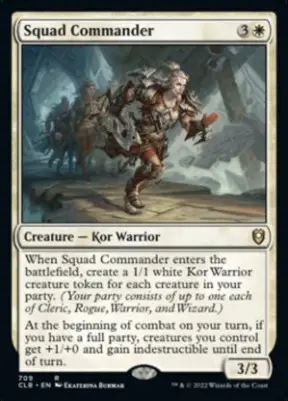
Secondly, she offers quite a bit of card advantage to the deck, again just by sitting on the battlefield. Lastly, once her needs are met she becomes quite a threat to opposing life totals. The deck is built around her and it is built around her well. She gives the deck access to everything it needs to run smoothly and win games.
Furthermore, the deck includes a healthy amount of ways to protect its
How The Deck works:
The deck is built around assembling a “full party” (Cleric, Rogue, Warrior, and Wizard and then being rewarded for it with things like Archpriest of Iona and Nalia de’ Arnise. Naturally, the deck plays all the strongest creatures for each creature type as well as changelings like Mirror Entity. Once your party is assembled there are several ways to close out games from there.
Notable Cards:
Pros And Cons:
| Pros | Cons |
| Self-sufficient Commander | Needs a full party to function well |
| Focused Strategy | Struggles against removal heavy decks |
| Good win-con density |
Upgrades:
This is one of the more streamlined precons I’ve played. With that said, there aren’t many must-have pieces that aren’t included. However, there are always some improvements to be made. Most of these changes will be replacing higher mana value spells with more cost-efficient things, that are easier to cast off of the top of the library.
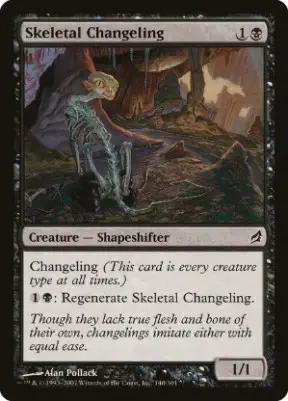
In: Graveshifter, Coveted Prize, Skeletal Changeling, Universal Automaton, Swarmyard
Out: Valiant Changeling, Aven Mindcensor, Butcher of Malakir, Pontiff of Blight, Windbrisk Heights
Mind Flayarrrs
Primary Commander:
Captain N’ghathrod
Colors:
Blue, Black
Strength Out Of The Box:
The out-of-the-box power lies in the decks synergy and all-star commander. The mill plan works in tandem with reanimating opposing threats. The versatility of being able to reanimate artifacts in addition to creatures is great as well.
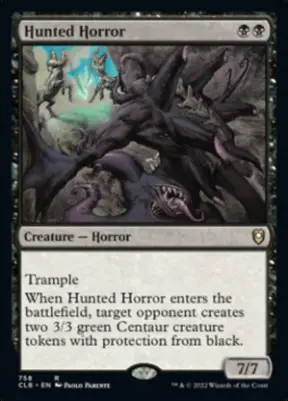
Next, Captain N’ghathrod does everything you would expect him to do. He himself is a horror, meaning he can always trigger his own ability. Then, he improves his own abilities by making it easier to deal damage with your horrors via menace. Lastly, he gives you the massive upside of reanimating opposing threats directly to the battlefield.
How The Deck Works:
The deck has a pretty straightforward but very powerful game plan. It wants to build up a
Notable Cards:
Pros And Cons:
| Pros | Cons |
| Powerful reanimation strategy | Can struggle without commander out |
| Great synergy | Struggles against excessive chump blockers |
| Commander is a payoff and enabler for the deck |
Upgrades:
The upgrades for this dimir deck are centered around increasing the potency of the stand-alone mill cards. As well as adding some horrors that mill cards or offer other upsides, to generate extra value. The horror theme, the milling, and the reanimation feed so well off of each other that a few changes increase the power level quite a bit. Let’s take a look.
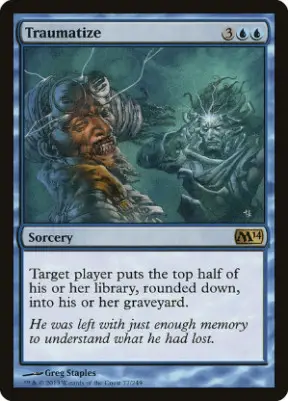
In: Maddening Cacophony, Mind Grind, Thing In The Ice, Bruvac the Grandiloquent, Cut Your Losses, Traumatize
Out: Leyline of Anticipation, Dark Hatchling, Plague Spitter, Hex, Psychosis Crawler, Pull From Tomorrow
Draconic Dissent
Primary Commander:
Firkraag, Cunning Instigator
Colors:
Blue, Red
Strength Out Of The Box:
From playing the deck, I think the decks greatest strength comes from its ability to generate value from having opponents attack each other. Not only does goading opposing creatures force them to attack each other, but it also keeps them from swinging at you. Furthermore, Firkraag, Cunning Instigator can draw cards for it as well. So, the deck can accrue quite a bit of upside by simply playing commander.
How The Deck Works:
The deck seeks to win by forcing opponents to attack each other and gaining value from it. The deck has several ways of pitting opposing creatures against one another and several ways to benefit from it. The main way the deck looks to goad things is with its commander’s first ability, therefore, there is also a strong Dragon tribal theme.
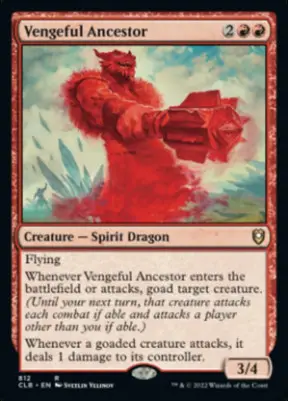
With each opponent weakening the other, while Draconic Dissent saves its resources, it can swing in with its Dragon hoard to perform the coup-de-grace on its diminished adversaries.
Notable Cards:
Pros And Cons:
| Pros | Cons |
| Good at protecting itself | Slow starter |
| Commander can draw cards | Needs to attack to trigger commander |
| Disruptive to opposing gameplans |
Upgrades:
There aren’t a ton of goad pieces in print that are missing from the stock list. Furthermore, goad decks don’t want too many cards that goad. So, we will be bolstering the strategy by increasing the payoffs for forcing opponents to attack one another. As well as adding in some things that bolter the Dragon tribal portion of the deck.
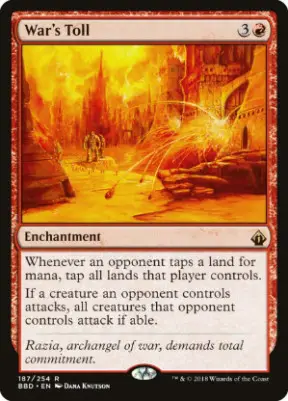
In: Rite of the Raging Storm, Grenzo, Havoc Raiser, Hunted Dragon, War’s Toll, Herald’s Horn, Goldspan Dragon, Terror of the Peaks
Out: The Akroan War, Brash Taunter, Stuffy Doll, Keiga, the Tide Star, Reins of Power, Kazuul, Tyrant of the Cliffs, Clan Crafter
Exit From Exile
Primary Commander:
Faldorn, Dread Wolf HeraldColors:
Red, Green
Strength Out Of The Box:
Exit From Exile is very powerful right from the box. Its strength comes from its ability to generate value and massive card advantage with its commander. Furthermore, the stock list is extremely focused. There are 34 spells in the deck that can exile and/or play cards from exile. This makes the powerful strategy very consistent and streamlined right from the package.
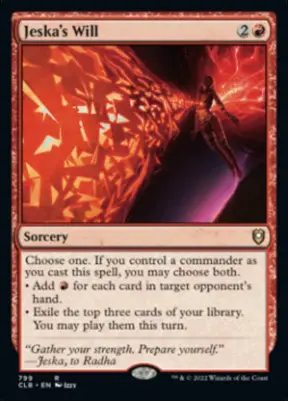
How Does The Deck Work:
The deck has a very simple, yet very powerful approach to victory. It wants to exile and cast cards from the top of its library. Doing so gives the deck a massive card advantage and triggers the deck’s commander, who then makes a 2/2 token. Once this engine is online the can wants to out-value and overrun opponents with an army of wolf tokens.
Notable Cards:
Upgrades:
The upgrades here will focus on swapping out the few off strategy cards for things of more use. As well as swapping a few high mana value spells for cheaper ones, so it’s easier to cast things from exile.
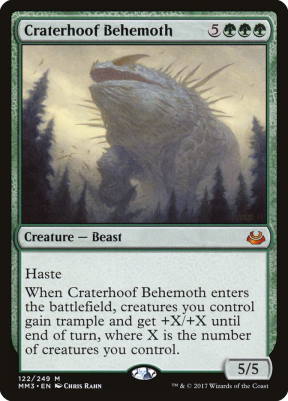
In: Commune with Lava, Valakut Exploration, Craterhoof Behemoth, Urabrask, Heretic Praetor, Blasphemous Act, Chandra, Torch of Defiance, You Find Some Prisoners
Out: Grumgully, the Generous, Arasta of the Endless Web, Hornet Queen, End-Raze Forerunners, Mizzium Mortars, Primeval Bounty, Ezuri’s Predation
Streets Of New Capenna
Obscura Operation
Primary Commander:
Kamiz, Obscura Oculus
Colors:
White, Blue, Black
Strength Out Of The Box:
The main strength of Obscura Operation lies in its ability to create favorable attacks with even its smallest creatures. Furthermore, the deck can generate some massive value and draw cards by dealing combat damage. This allows the deck to put most of its resources on its primary focus, (attacking) and not have to worry about running out of gas. The deck does a great job of fueling itself so that you can keep your foot on the gas and your hand full of threats.
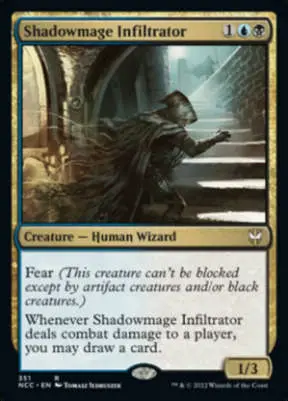
How Does The Deck Work:
The deck is centered around attacking with elusive creatures and generating value when they deal combat damage. Kamiz, Obscura Oculus helps in both regards, as he makes a creature unblockable and allows you to double up on combat damage triggers via double strike. The deck pairs these hard-to-block creatures with powerful ninjutsu creatures like Silent-Blade Oni to get strong effects and attackers into play early. There is also a strong theme of casting opponents’ spells when you deal them damage.
Notable Cards:
Pros And Cons:
| Pros | Cons |
| Generates card advantage by attacking | Needs a strong |
| Good threat density | Has to attack to generate value |
| Good removal and interaction |
Upgrades:
Like most precons, there are a few ways you could go with the upgrades. For example, you could choose to really lean into casting opponents’ spells or reanimation. With that said, I am choosing to keep the strategy and sub-strategies intact and simply upgrade their efficiency. While also adding in a few more things that benefit from discarding cards with Kamiz.
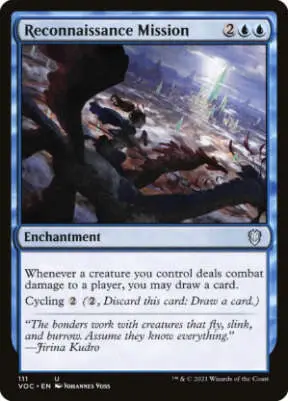
In: Grim Hireling, Bone Miser, Reconnaissance Mission, Ingenious Infiltrator, Mask of Memory, Changeling Outcast, Herald of Secret streams
Out: Stolen Identity, Daring Saboteur, Mask of Riddles, Whirler Rogue, Archon of Coronation, Looter il-Kor, Writ of Return
Riveteers Rampage
Primary Commander:
Henzie “Toolbox” Torre
Colors:
Black, Red, Green
Strength Out Of The Box:
Like many commander decks, Riveteers Rampage generates much of its power from its commander. Henzie “Toolbox” Torre has a lot to offer the deck. With that said, his main strength is his ability to cheapen large creatures as well as draw cards.
Furthermore, he gives you these things for very little other than simply playing magic. For example, casting your commander from the commander zone or having your creatures die is something all decks do. However, this deck offers you pseudo-ramp and card draw when they happen.
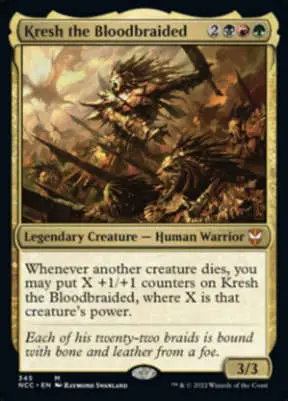
How Does The Deck Work:
Henzie “Toolbox” Torre gives your creatures blitz as long as they have a mana value of 4 or higher. So, the deck will want to cast its commander, then play creatures with a CMC of 4 or higher and use his ability to cheapen them.
The deck also has a strong aristocrats theme, as you sacrifice the creatures at the end of the turn and draw a card. There are several avenues to victory for Riveteers Rampage, including a beatdown creature strategy and a value-based aristocrats/reanimation theme as well.
Notable Cards:
Pros And Cons:
| Pros | Cons |
| Good ramp | Lacks removal |
| Multifaceted but cohesive strategies | High mana value spells/high “curve” |
| Good early & late game | Needs commander out to fire |
| Powerful creatures |
Upgrades:
Considering the commander rewards the deck for playing creatures of a certain mana value, we’ll add in a few other cards that do as well. As well as some high mana value powerhouses that we can reduce the cost of. There is also a benefit in adding more aristocrats’ payoffs that double as removal.
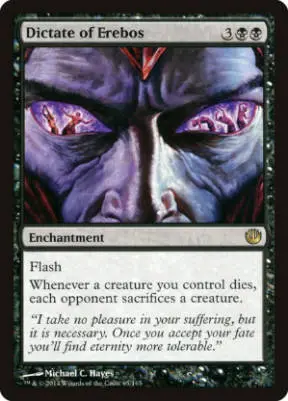
In: Ashnod’s Altar, The Great Henge, Korvold, Fae-Cursed King, Skullclamp, Butcher of Malakir, Dictate of Erebos, Garruk’s Packleader
Out: Temur Sabertooth, Aether Snap, Bellowing Mauler, Wave of Rats, Grime Gorger, Overgrown Battlement, Indrik Stomphowler
Bedecked Brokers
Primary Commander:
Perrie, the Pulverizer
Colors:
Green, White, Blue
Strength Out Of The Box:
The out-of-the-box strength comes from its versatility and self-sufficiency. The deck can enable its strategy in a variety of ways. Its reliance on different types of counters means that Perrie, the Pulverizer can turn a plethora of different resources into damage for the deck. All the while still reaping the intrinsic benefits of the permanent with the counters.
For example, Gavel of the Righteous, Wall of Roots, and Oblivion Stone all serve purposes aside from counter diversity. This ability to turn good permanents into better permanents and ultimately a win-con is the deck’s greatest asset.
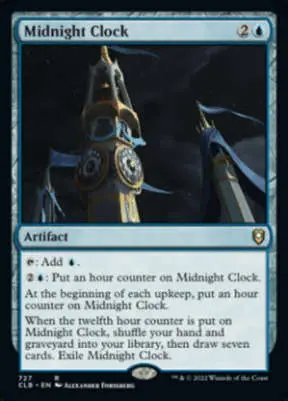
How Does The Deck Work:
Bedecked Brokers seeks to achieve victory by having different types of counters on its permanents. Then, turning them into damage with Perrie, the Pulverizer. It even has its own new counter called a “shield counter.” This offers some good protection for the deck. Once the deck has its
Notable Cards:
Pros And Cons:
| Pros | Cons |
| Makes great use of already good permanent | Relies heavily on the commander’s ability |
| Can win via commander damage | Needs lots of counters to function well |
| Shield counters offer the deck resilience |
Upgrades:
With the deck so focused on counters the upgrades are pretty straightforward. We want to add powerful pieces that also care about counters or further diversify our counter types. Things like Vivien, Monsters’ Advocate check those boxes while also working well with proliferate.
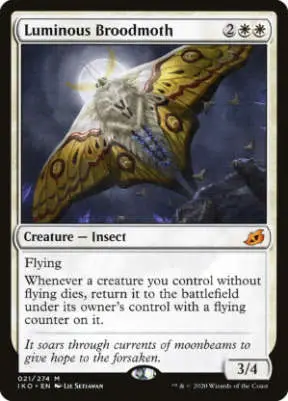
In: Blast Zone, Ominous Seas, The Ozolith, Luminous Broodmoth, Vivien, Monsters’ Advocate, Hardened Scales
Out: Vivid Grove, Wingspan Mentor, Bant Charm, Wickerbough Elder, Aven Courier, Planar Outburst
Cabaretti Cacophony
Primary Commander:
Kitt Kanto, Mayhem Diva
Colors:
Red, Green, White
Strength Out Of The Box:
The main strength of this mtg commander precon comes from its overall synergy. It has a wide variety of ways to, well “go wide.” Furthermore, Kitt Kanto, Mayhem Diveis a good enabler and payoff for the deck. She creates the two requisite creatures needed to activate her ability when she enters the battlefield.
This works very well to ensure that she isn’t stuck on
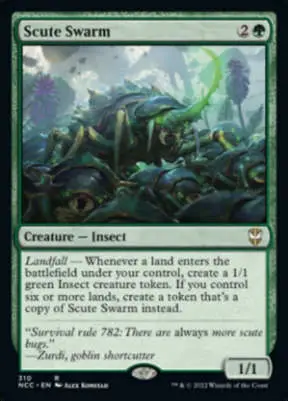
How Does The Deck Work:
Using Kitt Kanto, Mayhem Diva ability, the deck wants to pump out as many creatures as possible. Then tap two on each turn to pump up a creature and goad it. This means your opponents will be forced to attack each other with their bolstered threats.
Of course, this can be used on your turn to pump your tokens into bigger threats as well. The deck hopes to have opponents chip each other down, while it diverts attacks from itself. Then, swing in with an army of tokens and finish off whoever remains.
Notable Cards:
- Indulge // Excess
- Beastmaster Ascension
- Path to Exile
- Awakening Zone
- Bess, Soul Nourisher
- Scute Swarm
Pros And Cons:
| Pros | Cons |
| Good “go wide” synergy | Weak against |
| Good ramp and card draw | Needs creatures out to function |
| Self-sufficient commander |
Upgrades:
The upgrades for the deck come from a few angles. We will add a few things to make our token production more powerful. As well as some cards that help untap our permanents, to get more activations from Kitt. To make room for new spells we will remove some of the weaker token producers, a few goad cards, and things that give opponents a bit too many options.
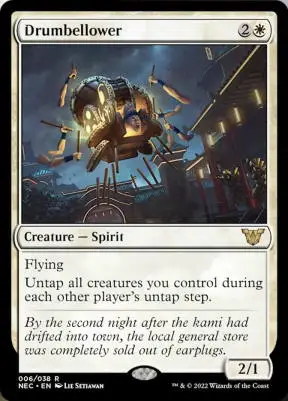
In: Parallel Lives, Divine Visitation, Drumbellower, Halo Fountain, Stonybrook Schoolmaster, Emmara, Soul of the Accord
Out: Selvala, Explorer Returned, Zurzoth, Chaos Rider, Agitator Ant, Orzhov Advokist, Bloodthirsty Blade, Sandwurm Convergence
Maestros Massacre
Primary Commander:
Anhelo, the Painter
Colors:
Blue, Black, Red
Strength Out Of The Box:
The out-of-the-box power for this particular precon comes from its commander, Anhelo, the Painter. His ability lets copy the first instant or sorcery spell you cast each turn if you sacrifice a creature with power two or greater.
Right out of the box every creature in the deck has power two or greater, except Anhelo himself. This makes it a breeze to get the deck firing and coping spells. With that said, the deck has a solid mix of early-game instants and sorceries that can generate value early and late-game bombs that can close out games.
How Does The Deck Work:
The deck wants to establish a
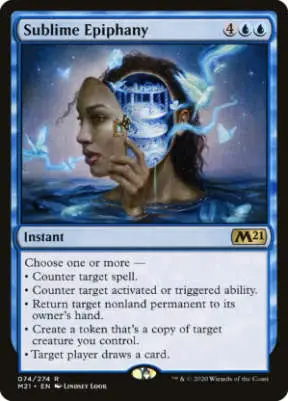
Notable Cards:
Pros And Cons:
| Pros | Cons |
| Powerful strategy | Needs lots of sacrifice fodder |
| Easy to get commander set up | Lacks ramp |
| Good interaction |
Upgrades:
Upgrades here could be done in quite a few different ways. However, I am going to keep the deck’s core strategy as is overall. I will be removing some over-costed removal and some weaker reanimation pieces. They will be replaced with some improved sacrifice fodder and powerful instants and sorceries. As well as some ramp spells and payoff cards for instants and sorceries.
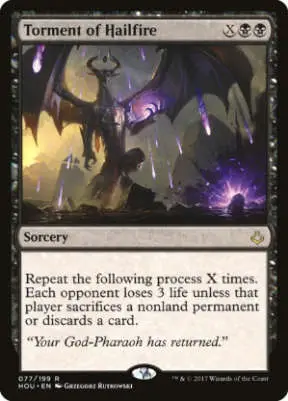
In: Archmage Emeritus, Storm-Kiln Artist, Torment of Hailfire, Jeska’s Will, Baral, Chief of Compliance, Deflecting Swat, Jadar, Ghoulcaller of Nephalia
Out: Squee, the Immortal, Syrix, Carrier of the Flame, Puppeteer Clique, Hex, Smuggler’s Buggy, Dread Summons, Sever the Blodline
Kamigawa: Neon Dynasty
Upgrades Unleashed
Primary Commander:
Chishiro, the Shattered Blade
Colors:
Red, Green
Strength out of the box:
The out-of-the-box strength for upgrades unleashed stems from its commander being self-sufficient. Many equipment and aura-based commander decks run into a common issue. That is, having a handful of cards to go on creatures but no creatures to put them on. Or vice-versa. Upgrades unleased doesn’t have that problem thanks to Chishiro. Each time an aura or equipment enters the battlefield on your side, he creates a 3/2 token with menace.
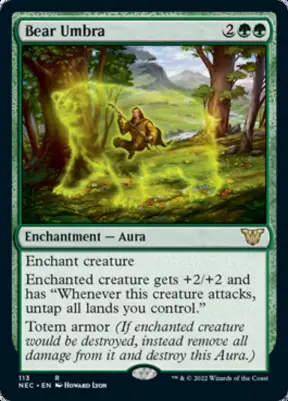
As a result, you will rarely ever get stuck with a handful of dead cards, waiting to draw a creature with upgrades unleashed. This ability makes the deck very consistent and is its greatest asset out of the box.
How Does The Deck Work:
The deck plays a pretty typical strategy for its colors. Go wide and then pump the team up to swing for victory. First, the deck wants to modify its creatures in some way. This can be done by equipping them with equipment, enchanting them with auras, or giving them some form of counter. Then, the deck seeks to use its commander’s ability to turn its ranks of creatures into augmented game-winning threats.
Notable Cards:
Related: The Best Neon Dynasty Cards: Our Early Picks
Pros And Cons:
| Pros | Cons |
| Commander is self-sufficient | Needs creatures and a way to modify them |
| Strong synergy | May struggle against |
| Aggressive |
Upgrades:
As mentioned above, the deck has some great advantages out of the box. For the upgrades, we will add some cards to further take advantage of the deck’s strengths. As well as some must-play aura, equipment, and +1/+1 counter synergy cards.
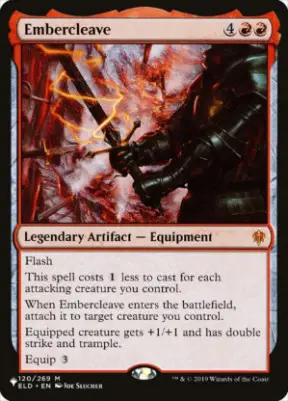
In: Rancor, Animation Module, Hardened Scales, The Ozolith, Avenger of Zendikar, Embercleave
Out: Ulasht, the Hate Seed, Soul’s Majesty, Primeval Protector, Goblin Razerunners, Kaima, the Fractured Calm, Bonehoard
Buckle up
Primary Commander:
Kotori, Pilot Prodigy
Colors:
Blue, White
Strength Out Of The Box:
The deck’s strengths come from its synergistic strategy. The deck cares about vehicles and artifacts and is packed with them. The deck being chalked-full of its enablers and payoffs makes it function quite well. Furthermore, a deck full of vehicles that aren’t creatures on your opponent’s turns means that your
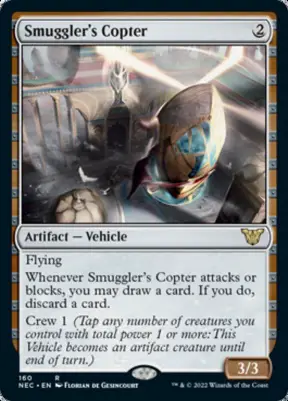
How Does The Deck Work:
The deck wants to use its commander to reduce its crew costs. With all its vehicles having crew 2 the deck wants to power out and man, high impact vehicles ahead of curve. While also giving them vigilance and lifelink on each of your combats. The deck wants to use this combination of cost reduction and keyword ability enhancement to overrun opponents with its deadly fleet.
Notable Cards:
Pros And Cons:
| Pros | Cons |
| Very good against sorcery speed removal/board wipes | Commander is more of a support card than an enabler |
| Can turn small creatures into bigger threats | Lacks mass removal |
| Great synergy | Weak against artifact removal |
Upgrades:
The upgrades here are focused on taking out some of the high mana value spells and spells that require tapping your artifacts to cheapen their cost. While the cards added include some card advantage pieces, as well as tutors and some ways to untap artifacts.
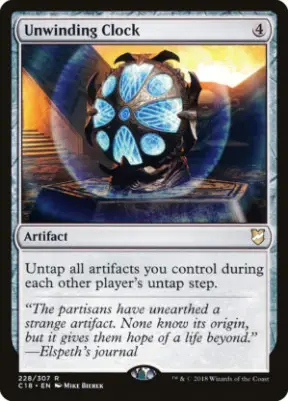
In: Austere Command, Deadeye Quartermaster, Rebbec, Architect of Ascension, Unwinding Clock, Padeem, Consul of Innovation, Cosima, God of the Voyage
Out: Jace, Architect of Thought, Myrsmith, Access Denied, Universal Surveillance, Arcanist Owl, Kappa Cannonerer
Innistrad: Crimson Vow
Spirit Squadron
Primary Commander:
Millicent, Restless Revenant
Colors:
Blue, White
Strengths Out Of The Box:
Spirit squadron has a few things that make it strong right out of the box. Its commander can be cast for a reduced cost. With enough spirits, she can be cast for 2 mana even through commander tax. Her ability to make spirit tokens when other spirits die makes for easy rebuilding after
How The Deck Works:
The deck is a spirit tribal deck. So, many things in the deck, including Millicent, Restless Revenant benefit from playing spirits. The deck aims to control and tempo out opponents while it builds and overwhelms with a spirit army.
The deck manages to both be controlling and aggressive as it uses “flash” and ETB triggers to tempo out opponents while advancing its
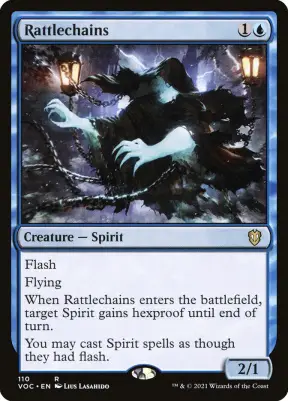
Furthermore, the deck makes combat hard for opposing creature decks. This is true for several reasons. First, creatures with flash can make any “open mana” a potential blocker. Secondly, Millicent’s ability to make spirits when your spirits die makes blocking easy for the deck.
Put another way, the deck can trade with opponents in combat and come out ahead because of the spirit tokens. Lastly, cards like Ghostly Prison and Windborn Muse make it so you can attack without having to leave up many blockers.
Notable Cards:
Pros And Cons:
| Pros | Cons |
| Strong tribal synergy | Commander is expensive without reduction |
| Aggressive and disruptive | Relies heavily on spirits for value |
| Good vs other creature decks | Not great against non-creature decks |
Upgrades:
Most of these upgrades are pretty simple. Mainly switching less impactful, non-spirit creatures for some powerful spirits. Aside from that, we also swap a few cards that don’t exactly synergize with the game plan for powerful card advantage engines.
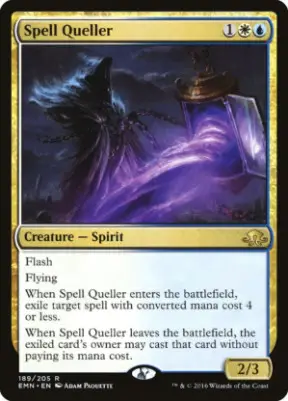
In: Kami of false hope, Selfless Spirit Spell Queller, Skullclamp, Reconnaissance mission
Out: Custodi Squire, Dovin, Grand Arbiter, Disorder In The Court, Custodi Soulbinders, Verity Circle
Vampiric Bloodline
Primary Commander:
Strefan, Maurer Progenitor
Colors:
Black, Red
Strength Out Of The Box:
The deck can cheat large creatures out quickly without much other than Strefan. This is because he is both an enabler (makes blood tokens) and a payoff (gives you a way to use them) for his abilities. If he can stay alive and attacking, he can create a great value engine almost all by himself. Vampiric Bloodline is a value-based tribal deck, that is on the long list of strong commander precons.
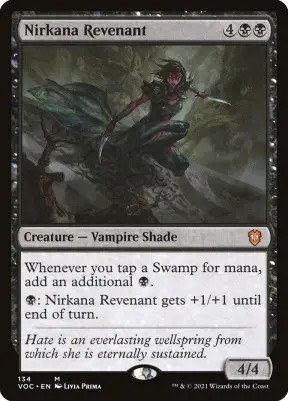
How Does The Deck Work:
The deck is a vampire tribal deck. However, it differs from other vampire commander decks because its primary focus is creating blood tokens. Then, sacrificing them to cheat out high-impact vampires. To make the most out of Strefan’s first ability the deck wants to ensure that the maximum number of players possible lose life each turn.
With that said, once you have a
Notable Cards:
Pros And Cons:
| Pros | Cons |
| Can cheat out powerful creatures fast | Relies heavily on the commander to function |
| Strong tribal synergy | Needs vampires in hand and strefan on the field to thrive |
| Commander is payoff and enabler |
Upgrades:
Most of the upgrades here are pretty straightforward. Taking out lower impact vampires and non-vampire creatures in favor of things that appeal more to our overall gameplan. For example, cards that refill our hand with things that we can cheat out. Or, cards to ensure that players lose life every turn so that we get full value from both our commander’s abilities.
Additionally, some changes are for cards with similar effects but more upside for our deck. As an example, swapping Unclaimed territory for Voldaren Estate and Vampire Nighthawk for Nighthawk Scavenger.
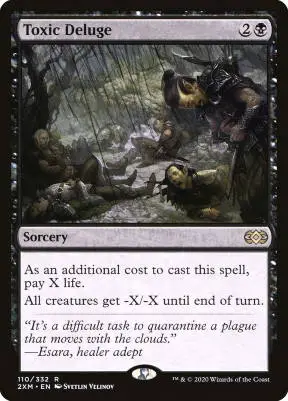
In: Voldaren Estate, Castle Locthwain, Toxic Deluge, Phyrexian Arena, Vicious Conquistador, Nighthawk Scavenger
Out: Unclaimed Territory, Dark Imposter, Shadowgrange Archfiend, Rakish Heir, Swamp (For Castle Locthwain), Urge To Feed
Innistrad: Midnight Hunt
Coven Counters
Primary Commander:
Leinore, Autumn Sovereign
Colors:
White, Green
Strength Out Of The Box:
First off, Leinore can allow you to draw cards. This is always very powerful on a commander. The next strength lies in the fact that her coven ability can put counters on herself, even if she is on the
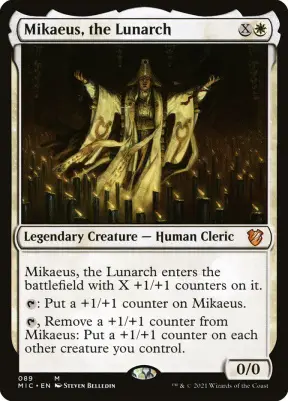
How Does The Deck Work:
Coven counters seek to use the “coven” ability introduced in Midnight Hunt to splash counters on its
Notable Cards:
Related: MTG Commander: The Ultimate Guide
Pros And Cons:
| Pros | Cons |
| Commander can draw cards | Needs multiple creatures on |
| Deck is very versatile | Vulnerable to creature removal |
| Doesn’t rely on a single strategy | Needs to have commander out |
Upgrades:
The upgrades here switch a few simple lands out for utility lands that are great for the strategy. As well as a few over-costed or underpowered creatures for relevant humans. While things like Hardened Scales and The Ozilith are simply more powerful than Kessig Cagebreakers and Curse Of Clinging Webs so the changes there are somewhat simple.
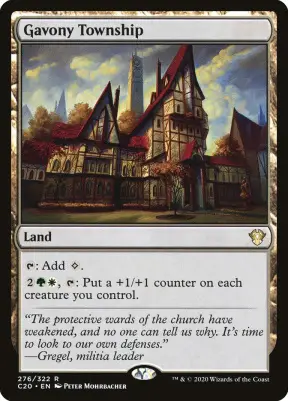
In: Hardened Scales, Odric, Lunarch Marshal, The Ozolith, Castle Ardenvale, Thalia’s Lieutenant, Gavony Township
Out: Enduring Scalelord, Plains, Biogenic Upgrade, Kessig Cagebreakers, Rogue’s Passage, Curse Of Clinging Webs
Undead Unleased
Primary Commander:
Wilhelt, the Rotcleaver
Colors:
Blue, Black
Strength Out Of The Box:
This Zombie tribal deck is amongst the most popular precons released recently. The commander, Wilhelt, has several upsides that make the deck formidable right out of the box. First, he can draw you cards.
Secondly, he is an enabler and a payoff as he is capable of both creating zombies and giving you something to do with them. This allows the deck to be aggressive and have the resources to wage a war of attrition. Furthermore, being in blue and black means the deck has lots of answers to opposing threats.
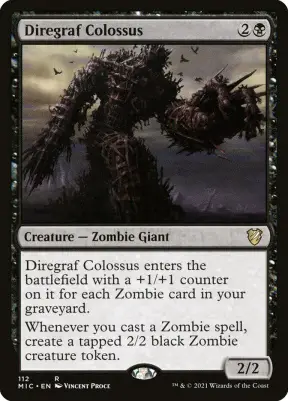
How Does The Deck Work:
The deck seeks to win by generating value out of its zombie horde. Wilhelt does so by making a zombie token with decayed whenever your zombies die. This means each zombie is not only an attacker in life but is likewise an avenue for value in death. This undead value engine can easily churn out card advantage and an unending barrage of attackers.
Notable Cards:
Pros And Cons:
| Pros | Cons |
| Powerful card advantage | Weak to graveyard hate |
| Strong tribal benefits | Weak to things that stop death triggers (exile effects} |
| Good removal and disruption |
Upgrades:
The upgrades for this deck focus on strict power increases and ways to squeeze maximum potential out of death triggers. The power upgrades come from cards like Champion Of The Perished and Plague Belcher. While our synergy is increased by cutting expensive non-zombie cards for things like Murderous Rider and Bastion of Remembrance.
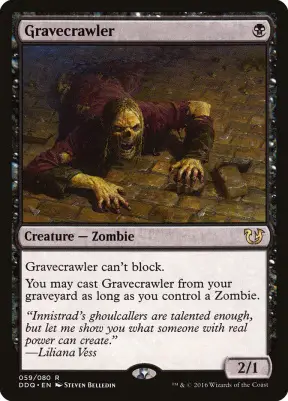
In: Champion of the Perished, Murderous Rider, Plague Belcher, Skull Clamp, Bastion of Remembrance, Gravecrawler
Out: Eater of Hope, Go For The Throat, Liliana’s Devotee, Eater of Hope, Hour of Eternity, Spark Reaper
Adventures in the Forgotten Realms
Planar Portal
Primary Commander:
Prosper, Tome-Bound
Colors:
Black, Red
Strengths Out Of The Box:
This deck has very potent built-in card advantage. It allows you to exile and play cards from the top of your library. Furthermore, it rewards you with ramp, in the form of treasure tokens whenever you cast a spell from exile.
One of the greatest strengths is that you can cast the cards until the end of your next turn. This means you can play lands exiled as your land drop on your next turn. Additionally, instants exiled on your end step can be held up as threats throughout other players’ turns.
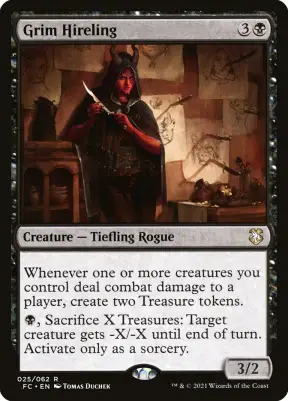
How Does The Deck Work:
The deck works by giving you access to lots of resources from the top of your library. Then, rewarding you with treasures for casting them. These treasures are both ramp and potential win conditions. Furthermore, the deck can exile and cast cards from opponent’s libraries. This not only keeps potent threats from opposing hands, but it also lets you steal them and make treasures in the process.
Related: How Do Partner Commanders Work In MTG?
Notable Cards:
Pros And Cons:
| Pros | Cons |
| Commander offers massive card advantage | Mana base can struggle without upgrades or treasures |
| Treasure tokens can be an alternate win-con | Can get stuck with non-castable cards in exile |
| Can cast opponent’s spells |
Upgrades:
The upgrades for planar portal are mainly focused on increasing the synergy of the deck. This is achieved by taking out creatures without much value and adding ones that further the deck’s game plan. Additionally, we will add some ways to further make use of our treasures. Including some ways to win the game via treasure tokens.
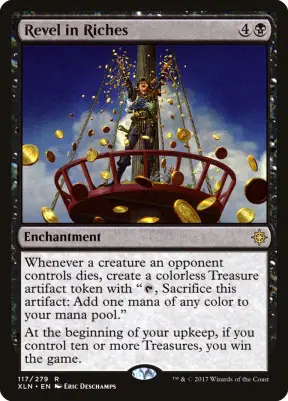
In: Revel in Riches, Blasphemous Act, Murderous Rider, Dream Devourer, Jeska’s will, Birgi, God Of Storytelling
Out: Ebony Fly, Chittering Witch, Fiend of The Shadows, Hex, Danse Macabre, Ogre Slumlord
Aura Of Courage
Primary Commander:
Galea, Kindler of Hope
Colors:
Green, White, Blue
Strength Out Of The Box:
Galea offers her deck many benefits straight out of the box. Allowing you to not only look at the top of your library but cast it if it is an aura or equipment. Furthermore, when you cast a spell this way you may attach it to a creature you control. This grants you not only card advantage but the ability to forgo equip costs. Galea being a 4/4 with vigilance herself is a huge asset because she can enchant/equip herself and attack while still being available to block. Winning by commander damage with this deck is highly possible.
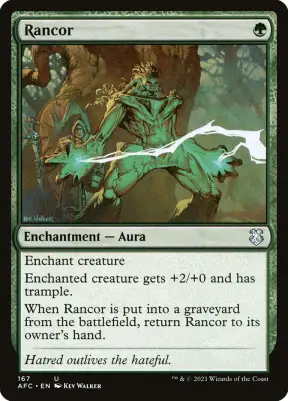
How The Deck Works:
This deck revolves around cheating equipment and Aura spells off the top of your library and directly onto creatures. This “directly onto creatures” means the deck can get some huge buffs way ahead of curve.
Galea ultimately hopes to augment herself enough to swing at opponents for lethal damage personally. With that said, the deck plays a plethora of other creature cards that benefit from enchantments or equipment; So that the deck remains in the game even without the general deployed.
Notable Cards:
Pros And Cons:
| Pros | Cons |
| Powerful draw engine | Requires creatures as well as enchantments/equipment to function |
| Has combo play style at times | Greatly relies on the commander being on the field |
| Can cast spells from the top of its library |
Upgrades:
The upgrades for Aura Of Courage are pretty straightforward. We are removing creatures that do not progress the strategy above for ones that do. We are also improving some of the stock equipment spells, so we get full value for cheating them onto creatures. We’re also trimming a few draw spells in favor of more removal.
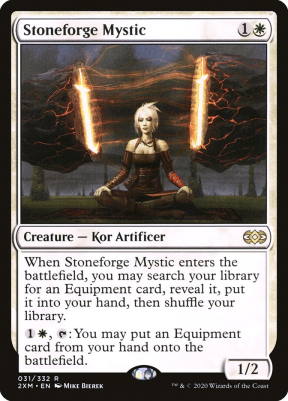
In: Swords To Plowshares, Sigarda’s Aid, Colossus Hammer, Blackblade Reforged, Sythis, Harvest’s Hand.Kor Spiritdancer, Beast Within, Stoneforge Mystic
Out: Clay Golem, Catti-brei Of Mithral Hall, Angel Of Finality, Storvald, Frost Giant Jarl, Moonsilver Spear, Ebony Fly, Ride The Avalanche, Brainstorm
Draconic Rage
Primary Commander:
Vrondiss, Rage of Ancients
Colors:
Red, Green
Strength Out Of The Box:
Vrondiss is a strong commander because he rewards for you something that is going to happen throughout the game regardless. He will take damage even aside from us damaging him ourselves. This creates a situation where you often get dragon tokens for doing nothing more than blocking. Aside from the commander, the deck has a strong ramp package. As well as some very powerful creatures. All these things together make it one of the more solid out-of-the-box precons.
How Does The Deck Work:
While the deck is built around Vrondiss’ abilities, it is at heart a dragon tribal deck. The commander simply has a very unique way of producing dragon tokens. As a result, the deck seeks to damage its commander for these tokens.
This is done in several ways, including his dice-rolling ability. Aside from the commander, the deck has a simple but effective game plan of ramping its way toward very large dragon spells. Like any good tribal deck, it also plays several cards that reward you for having dragons.
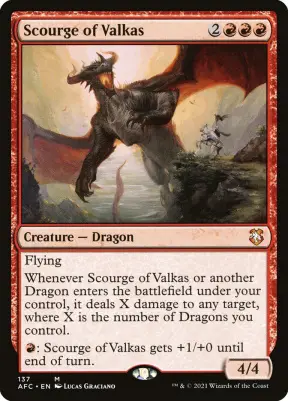
Notable Cards:
Pros And Cons:
| Pros | Cons |
| Tribal Synergy | High mana value spells |
| Self-Sufficient Commander | Slow Starter |
| Good late game |
Upgrades:
The deck has very solid creatures overall. However, some creatures don’t fit the overall strategy that can be swapped for more powerful ones. Aside from that, some lower-power non-creature spells are replaced with removal and protection spells.
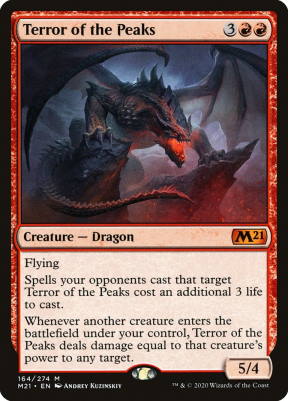
In: Terror Of The Peaks, Ulvenwald Tracker, Domri, Anarch of Bolas, Rhythm Of The Wild, Heroic Intervention, Beast Within
Out: Indomitable might, Sword Of Hours, Maddening Hex, Dragon Tempest, Orb Of Dragonlord, Masked Vandal
Dungeons Of Death
Primary Commander:
Sefris of the Hidden Ways
Colors:
White, Blue, Black
Strength Out Of The Box:
Sefris of the Hidden Ways is an esper commander that is both a payoff and an enabler for the venture mechanic. Giving you both ways to venture into dungeons each turn and rewarding you for doing so. One of the deck’s biggest strengths is its ability to trigger itself in several different ways.
This includes your creatures dying in combat, discarding cards, sacing creatures, and milling cards from your library. Such versatility means the deck rarely has trouble finding a way to progress its game plan.
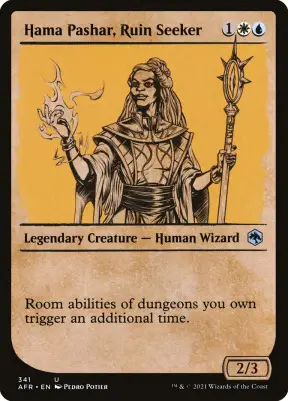
How Does The Deck Work:
The deck works off of Sefrif’s abilities to create a reanimation engine. It does this by having creatures put into the graveyard on each turn. Then, using these triggers to complete dungeons as quickly as possible and then reanimate powerful creatures from the graveyard. The deck attempts to get around the “only once per turn” clause by venturing into dungeons at instant speed on opponents’ turns.
Notable Cards:
Pros And Cons:
| Pros | Cons |
| Versatile strategy can be triggered in multiple ways | Poor mana ramp |
| Focused Strategy | Slow starter |
| Reanimation engine | High mana value creatures |
Upgrades:
Most of the upgrades for Dungeons of Death are focused on making the mana base more consistent. While also trimming some of the high mana creatures for more impactful low mana spells. Furthermore, we will remove some of the slower non-creature spells and add some interactive ways to slow our opponent’s gameplans down.
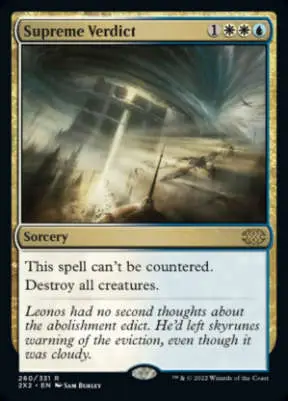
In: Syr Konrad, the Grim, Viscera Seer, Acererak the Archlich, Godless Shrine, Glacial Fortress, Supreme Verdict, Drown In The Loch.
Out: Clay Golem, Nihiloor, Necrotic Sliver, Glacial Fortress, Terramorphic Expanse, Minimus Containment, Immovable Rod.
Strixhaven: School Of Mages
Lorehold Legacies
Primary Commander:
Osgir, the Reconstructor
Colors:
White, Red
Strength Out Of The Box:
Lorehold Legacies is fairly powerful straight from the box. This is largely because it has very high synergy, having tons of artifacts to pair with our artifacts matter commander. Additionally, the deck has amazing potential to recur powerful threats by copying them from your graveyard. It can also gain incremental advantage from many spells you would play regardless of the commander.
How Does The Deck Work:
The deck works by sacrificing artifacts. Both for raw value and as a way to buff your creatures in combat. While his secondary ability allows you to reanimate them by, exiling an artifact in your graveyard to make two token copies of it.
The first ability works well to turn early artifacts that have served their purpose into extra combat damage. While the second can be a game-winner when making two copies of some of the extremely powerful artifacts. These can be discarded or cycled into the graveyard to be copied later.
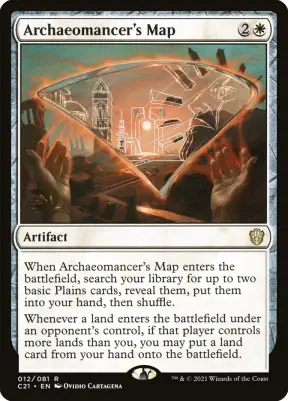
Notable Cards:
Pros And Cons:
| Pros | Cons |
| Highly Synergistic | Trouble drawing cards |
| Streamlined game plan | Weak to graveyard hate |
| Consistent |
Upgrades:
While the deck is very strong untouched, there is room for some improvements. Mainly replacing some overpriced and less useful cards with some artifact-driven card advantage and tutor spells.
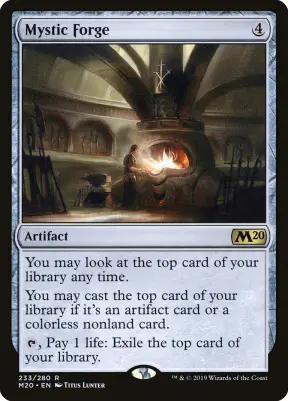
In: Ruin Grinder, Goblin Engineer, Mystic Forge, Skullclamp, Mishra’s Bauble
Out: Return To Dust, Sanctum Gargoyle, Thopter Engineer, Bosh, Iron Golem, Unstable Obelisk
Witherbloom Witchcraft
Primary Commander:
Willowdusk, Essence Seer
Colors:
Black, Green
Strength Out Of The Box:
Our commander doesn’t have the most threatening stats in the game. However, it does have the ability to turn all our other creatures into potent attackers. This makes the deck consistent right out of the box. As well as making it so it has very few dead draws. Furthermore, the deck accrues value while it drains and gains its opponents into lethal attack range.
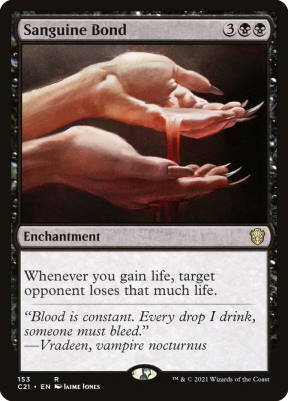
How Does The Deck Work:
The deck works by gaining and paying life to buff up its creatures. Willowdusk lets you bolster creatures if you gain life or lose life. The deck seeks to pad its life total or pay chunks of life to gain advantage and create threats all at once. These abilities lend themselves well to spells that drain all player’s life equally, as we reap benefits from it and other players don’t.
Notable Cards:
Pros And Cons:
| Pros | Cons |
| Good vs aggro | Needs ways to protect creatures |
| Strong midrange game | Not great vs |
| Commander is a payoff and enabler |
Upgrades:
The upgrades here are centered around adding in more ways to drain opponent’s life totals and ways for us to protect our commander and creatures. The cards we will be taking out are some of the more stock precon cards that the deck won’t miss.
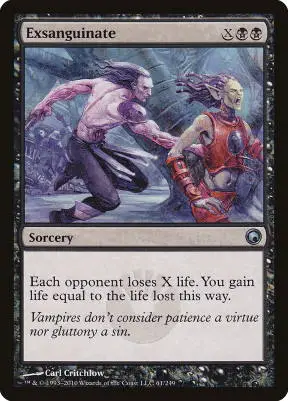
In: War Room, Vito, Thorn of the Dusk Rose, Murderous Rider, Heroic Intervention, Lightning Greaves, Exsanguinate
Out: Sangromancer, Feed The Swarm, Reckless Spite, Sun Droplet, Druidic Satchel, Bloodthirsty Aerialist
Prismari Performance
Primary Commander:
Zaffai, Thunder Conductor
Colors:
Blue, Red
Strength Out Of The Box:
One of the greatest strengths of the deck is its pacing. Having a commander whose abilities scale with the mana value of our spells is a great advantage for the deck. Furthermore, having several x spells means the deck has plays in the early game that can be finishers in the late game. This makes the mana curve of the deck smooth right out of the box.
How Does The Deck Work:
Zaffai is a commander that wants you to cast instants and sorceries. The higher the mana value of the spells you cast the stronger your commander’s ability becomes. With that said, the deck plays many x spells that can be pumped full of mana in the late game. Zaffai’s magecraft ability also triggers when you copy spells. So, copying opponent’s spells is also a theme of the deck.
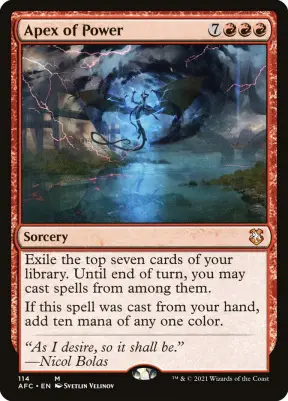
Notable Cards:
Pros And Cons:
| Pros | Cons |
| X spells scale with the game (can be small early and big late) | Deck needs lots of mana |
| Good mana curve | May struggle vs Aggro |
| Has many ways to use excess mana |
Upgrades:
Most of the upgrades here are taking out some of the more general creatures. Then, filling the open spots with low mana value creatures that benefit the strategy more. We simply increase the power level for non-creature spells and add more x spells.
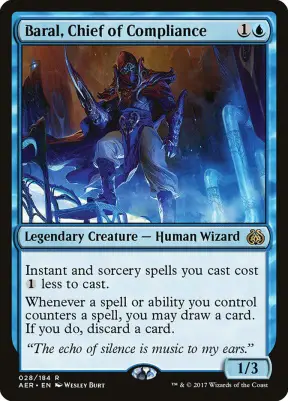
In: Goblin Electromancer, Baral, Chief of Compliance, Young Pyromancer, Blistercoil Weird, Narset’s Reversal, Expansion // Explosion, Banefire, Finale Of Promise
Out: Rionya, Fire Dancer, Etali, Primal Storm, Pyromancer’s Goggles, Erratic Cyclops, Naru Meha, Master Wizard, Living Lore, Sly Instigator.
Silverquill Statement
Primary Commander
Breena, the DemagogueColors:
White, Black
Strength Out Of The Box:
This group hug style deck’s strength lies in the fact that it pits opponents against one another. This means the deck not only has its cards to use as threats but the strength of others players as well. Often times making games lopsided in its favor very early on and saving its powerful spells for the late game.
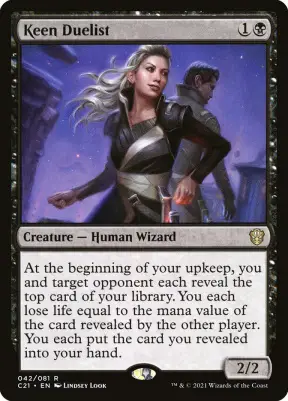
How Does The Deck Work:
The deck functions by turning other players against each other and furthering its game in the process. Incentivizing opponents to attack one another instead of attacking the Breena pilot. Causing opponents to drain each other’s life and recourses to a point where Breena can easily deal remaining players their coup de grâce and claim victory.
Notable Cards:
Pros And Cons:
| Pros | Cons |
| Strong late game | Slow starter |
| Resilient | Lacks mana ramp |
| Good removal | Can help opponents |
Upgrades:
The upgrades here focus on adding creatures that give us even more political options and non-creature spells that help protect us from attacks. While some of our higher mana value spells can be swapped for cheap removal.
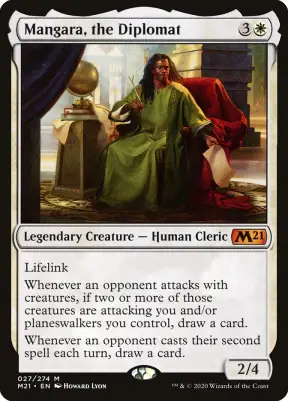
In: Mangara, The Diplomat, Baneslayer Angel, Selfless Glyphweaver, Kaya the Inexorable, Merciless Eviction, Path to Exile
Out: Bloodthirsty Blade, Zetalpa, Primal Dawn, Necropolis Regent, Deathbringer Liege, Tragic Arrogance, Citadel Siege
Quantum Quandrix
Primary Commander:
Adrix and Nev, TwincastersColors:
Blue, Green
Strength Out Of The Box:
The out-of-the-box power of the deck comes from the commander in two ways. First, she can protect herself with the “ward” ability. A commander with built-in protection makes life much harder for opponents. Secondly, her static ability makes all token producers in the deck twice as good. This is a very powerful effect to have in the command zone.
How Does The Deck Work:
The deck has a powerful but simple game plan. It wants to keep its commander on the battlefield and cast spells that create tokens. The deck is capable of making x/x fractal tokens that can be deployed in the early game for value or saved until the late game to be a huge bomb.
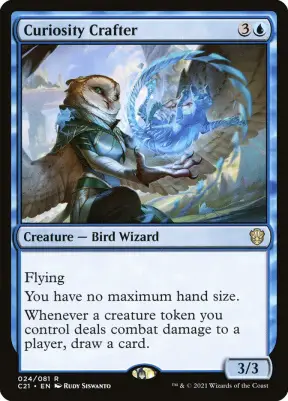
Notable Cards:
Pros And Cons:
| Pros | Cons |
| Commander can protect herself | Weak against |
| Very synergistic | Slow starter |
| Aggressive token strategy |
Upgrades:
While the deck is very solid there are a few ways to make it better. First, we swap out some of the expensive token producers for cheaper spells. As well as adding some ways to create tokens every turn. Second, we will replace some of the low-impact high mana value spells with ways to protect our
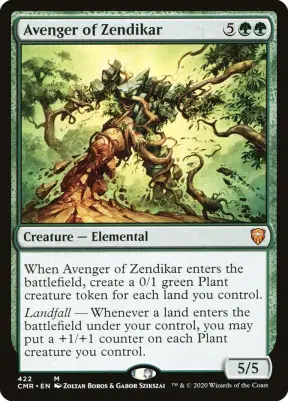
In: Master Of Waves, Avenger Of Zendikar, Heroic Intervention, Scute Swarm, Body Of Research, Nissa, Voice of Zendikar, Panharmonicon
Out: Spawning Kraken, Arashi, The Sky Asunder, Ruxa, Patient Professor, Garruk, Primal Hunter, Terastodon, Incubation // Incongruity, Curse of the Swine
Kaldheim
Elven Empire
Primary Commander:
Lathril, Blade of the ElvesColors:
Blue, Green
Strength Out Of The Box:
Much of the deck’s power comes from its dual-threat style. Lathril can churn out more tokens the bigger she gets. This gives the deck the ability to play a good “go tall” and “go wide” game. Furthermore, Lathril’s tap ability can be used at instant speed making it a great response to mass removal. Giving the deck a much-needed boon against
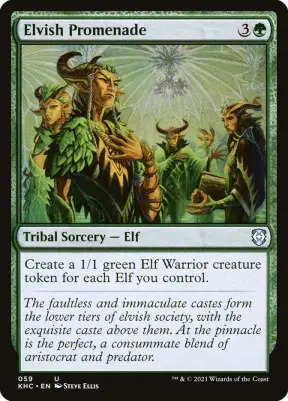
How Does The Deck Work:
The game plan for the deck is simple but effective. The plan is to generate a massive number of elves and swarm the
Related: The Best Green Ramp MTG Cards for EDH
Notable Cards:
Pros And Cons:
| Pros | Cons |
| Strong tribal/Token synergy | High mana curve |
| Good ramp | Slow starter |
Upgrades:
The upgrades for the deck are mainly going to be lowering the curve. This will be done by taking out high mana value cards for things that can be cast quicker. As well as adding in a bit more ramp and removal for the deck.
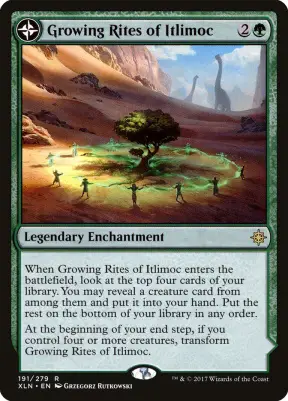
In: Realmwalker, Elvish Visionary, Ezuri, Renegade Leader, Assassin’s Trophy, Growing Rites Of Itlimoc
Out: Elderfang Venom, Cultivator Of Blades, Elderfang Ritualist, Eyeblight Cullers, Masked Admirers
Phantom Premonition
Primary Commander:
Ranar the Ever-WatchfulColors:
Blue, White
Strength Out Of The Box:
One of the greatest strengths of the deck is how well it plays to its colors. By this I mean, adding a blink and flying sub-theme to a foretell deck. Foretell is a very new mechanic, so having two of Blue/Whites’ strengths makes the deck very solid. Furthermore, many of the spells have strong enter/exit the battlefield triggers. This means most cards can generate value just by being cast or even if they get removed.
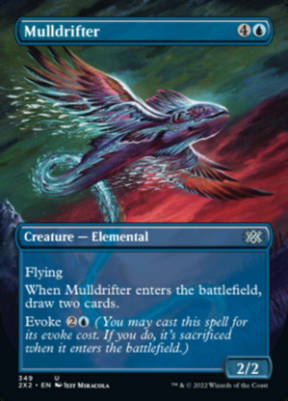
How Does The Deck Work:
The deck seeks to create an army of fliers to achieve victory through the air. Ranar creates a 1/1 flyer whenever you exile a card. So, the deck takes advantage of his ability to foretell for free. While also featuring many ways to blink creatures to exile and back to the battlefield. This not only floods the
Notable Cards:
Pros And Cons:
| Pros | Cons |
| Controls the game well | Slow starter |
| Keeps opponents off balance | Needs lots of mana |
| Strong late game |
Upgrades:
The upgrades for the deck are all pretty simple. We will be adding strong flyers that have good ETB triggers. This will upgrade the flying portion of the deck as well as the blink subtheme. While also making it easier to trigger our commander.
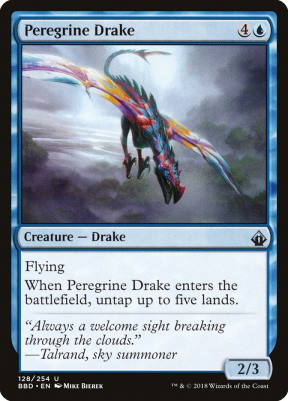
In: Cloudkin Seer, Yorion, Sky Nomad, Charming Prince, Ephemerate, Peregrine Drake,
Out: Evangel Of Heliod, Goldnight Commander, Meteor Golem , Surtland Elementalist, Mist Raven
Commander Legends
Arm For Battle
Primary Commander:
Wyleth, Soul of SteelColors:
White, Red
Strength Out Of The Box:
The main power-point of the deck right out of the box is the commander’s ability to draw cards. While other commanders can draw cards, Wyleth allows you to do it for only attacking. This is a huge advantage over cards that require you to deal combat damage to trigger an ability. Furthermore, he can maintain card advantage while he does exactly what Voltron strategies want to do.
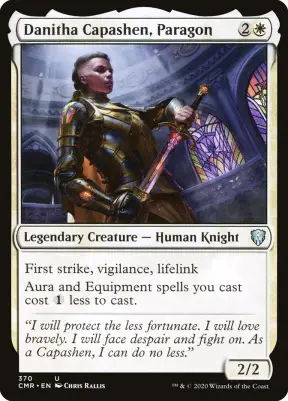
How Does The Deck Work:
The deck works by piling auras and equipment onto its creatures. Once they are suited up, the deck wants to swing all out for as much damage as possible. Wyleth’s ability allows the deck to constantly have fuel to add to the fire, thanks to his built-in card draw. While red and white give the deck plenty of things to slow opponent’s game plans down and stay alive.
Related: Building An Eldrazi Commander Deck: An Ultimate Guide
Notable Cards:
Pros And Cons:
| Pros | Cons |
| Card advantage on commander | Lacks ramp |
| Focused strategy | Trouble closing out games |
| Aggressive |
Upgrades:
Most of the upgrades here are strict power upgrades. This will help the deck push through for those last few points of difficult damage. This is achieved by taking out a few underwhelming or over-costed cards and adding in potent equipment and spells that benefit from them. As well as a few cards to add some much-needed ramp to the deck.
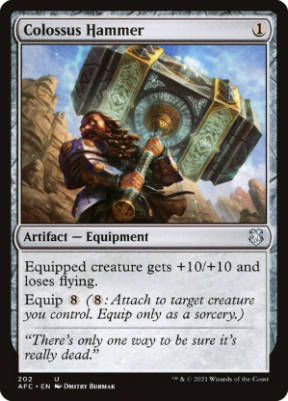
In: Sword Of The Animist, Puresteel Paladin, Umezawa’s Jitte, Colossus Hammer, Batterskull
Out: Unquestioned Authority, Word of Seizing, Return To Dust, Dualcaster Mage, Flickerwisp
Reap The Tides
Primary Commander:
Aesi, Tyrant of Gyre StraitColor:
Blue, Green
Strength Out Of The Box:
Reap the tides is one of the stronger out-of-the-box decks. It has very good stock ramp and card draw. Furthermore, both are stapled directly onto the deck’s commander. With the deck’s access to strong mana ramp, it can get its commander out quickly and snowball powerful creatures from there. The simic color combination also has plenty of cards to help protect its
How Does The Deck Work:
The deck has a simple but powerful game plan. It seeks to ramp into its commander early. Then control the
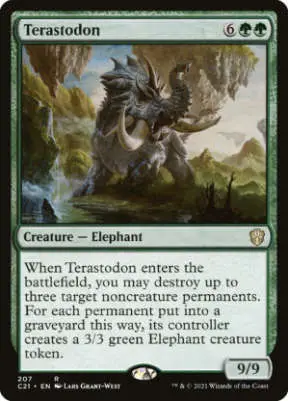
Notable Cards:
Pros and Cons:
| Pros | Cons |
| Ramp and card draw on commander | Commander is expensive to cast |
| Commander is a payoff and enabler for deck | Lacks support for sea-creature subtheme |
| Good interaction |
Upgrades:
The deck places much emphasis on playing lands every turn. So, we will swap out more lands from this deck than some others. Taking out tap lands for some faster ones will help the deck get up to its commander as soon as possible. With that said, I would take out some of the weaker sea creatures for more powerful landfall spells.
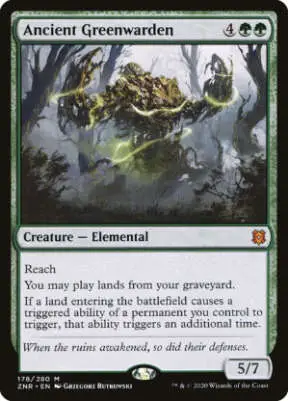
In: Zendikar’s Roil. Risen Reef, Blast Zone, Castle Vantress, Ancient Greenwarden, Castle Garenbrig, Master Of Waves
Out: Elder Deep-Fiend, Meteor Golem, Blighted Woodland, Shipbreaker Kraken, Slinn Voda, The Rising Deep, Evolving Wilds, Simic Guildgate
Zendikar Rising
Land’s Wrath
Primary Commander:
Obuun, Mul Daya AncestorColors:
Red, Green, White
Strength Out Of The Box:
This is a very cool and fairly powerful stock list. First, the deck has a few routes to victory. It can win with powerful landfall triggers. Including pumping its commander big enough to win via commander damage. Secondly, the deck can produce massive land creatures with trample that can dominate the
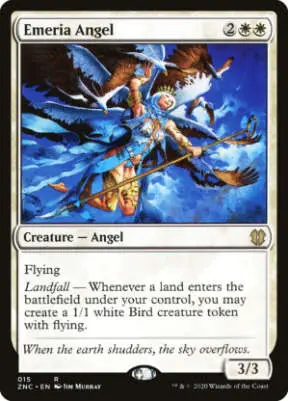
How Does The Deck Work:
The deck is a landfall deck at heart. So, it seeks to put as many lands as possible onto the battlefield per turn. However, unlike other landfall commanders, Obuun turns a land into a creature at the beginning of combat on your turn. The land creatures’ size is based upon Obuun power. So, the landfall ability on the commander is a great way to pump out large tokens each turn and also gives the deck a counters subtheme.
Notable Cards:
Pros And Cons:
| Pros | Cons |
| Versatile win strategies | Lacks overall synergy |
| Good even without commander on the field | Not good vs non-creature matchups |
Upgrades:
While the counter subtheme lends the deck a nice backup plan, some of the weaker counter cards will be switched out to enhance the landfall side of the deck. As with the other land-themed decks on the list, we will switch out a few of the weaker lands in favor of some more utility.
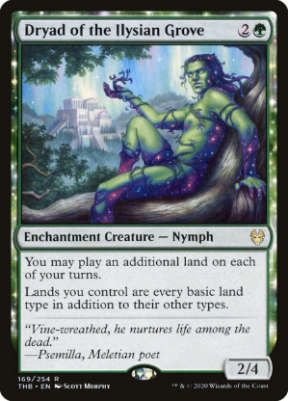
In: Avenger Of Zendikar, Sakura-Tribe Elder, Scute Swarm, Valakut, The Molten Pinnacle, Nissa, Who Shakes The World, Felidar Retreat, Field of the Dead, Dryad of the Ilysian Grove
Out: Armorcraft Judge, Tuskguard Captain, Sandstone Oracle, Scaretiller, Crush Contraband, Needle Spires, Boros Garrison, Living Twister
Sneak Attack
Primary Commander:
Anowon, the Ruin ThiefColors:
Blue, Black
Strength Out Of The Box:
The strength of this deck out of the box comes from a few different things. First, it has a fairly focused tribal theme. This makes it easy to be streamlined in its approach to victory. However, it is not a one-trick pony, as it also has a strong mill subtheme. Furthermore, having the ability to draw cards on your commander is always nice.
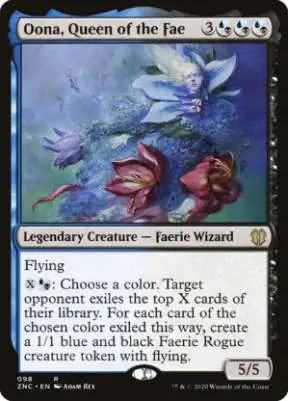
How The Deck Works:
The game plan of the deck is to saturate the
Notable Cards:
Pros And Cons:
| Pros | Cons |
| Evasive creatures | Mediocre mill plan |
| Good disruption / Interaction | Fills opponent’s graveyards for them |
| Tribal synergy |
Updates:
The upgrades for this deck could go a few ways. You could choose to upgrade the Rouge plan at the expense of the mill plan or vice versa. Or keep things somewhere in the middle. While I do like having mill in the deck, I think there are better commanders out there for blue/black mill. With that said, I will be upgrading more towards better rouges and tempo plays than anything else.
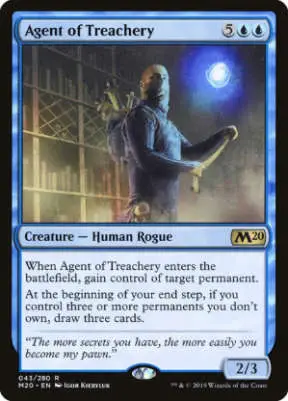
In: Inkfathom witch, Agent of Treachery, Thieving Skydiver, Nighthawk Scavenger, Drown In The Loch, Visions Of Beyond
Out: Spinal Embrace, Scourge of Fleets, Extract From Darkness, Nighthowler, Ogre Slumlord, Cytheclaw
Ikoria: Lair Of Behemoths
Timeless Wisdom
Primary Commander:
Gavi, Nest WardenColors:
Blue, Red, White
Strength Of The Box:
This Jeskia mtg commander precon has a few things going for it. First, it lets you completely forgo paying for the first card you cycle per turn. Doing anything for free in a format like EDH can be very big. Second, her ability to pump out cat tokens can easily be triggered most turns. This includes drawing cards at instant speed on other players’ turns. Being able to create bodies for doing something you would do anyway is a big upside.
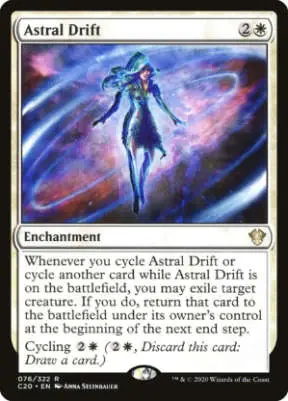
How Does The Deck Work:
The deck wants to get a lot of its value from drawing at least two cards per turn. The deck can achieve this when Gavi is out by cycling a card for free once per turn. This makes Gavi an enabler and a payoff for her ability. Once the deck is in a position to draw a second card each turn it seeks to trigger cards like Gavi, Niv-Mizzet, the Firemind, and the The Locust God to threaten opponent’s life totals.
Related: The Best Magic The Gathering Art
Notable Cards:
Pros And Cons:
| Pros | Cons |
| Strong late game | Relies heavily on commander being out |
| Good Interaction | Slow starter |
| Highly synergistic | High mana value spells |
Upgrades:
The upgrades here are pretty straightforward. We will be buffing up the already present cycling theme and removing some cards that don’t fit the strategy. Making the deck more consistent and upping the power level a bit as well.
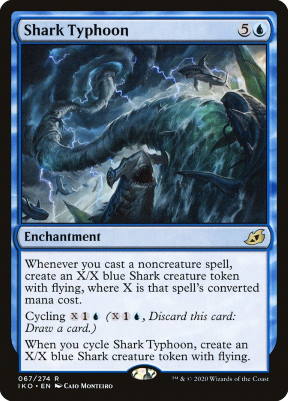
In: Chasm Skulker, Hollow One, Yidaro, Wandering Monster, Shark Typhoon, Improbable Alliance
Out: Agitator Ant, Ethereal Forger, Isperia, Supreme Judge, Psychic Impetus, Shiny Impetus
Arcane Maelstrom
Primary Commander:
Kalamax, the StormsireColors:
Green, Blue, Red
Strength Out Of The Box:
Instants and sorceries are often very powerful in EDH and having an easy way to dual cast things is very strong all by itself. In addition to being a spell slinger deck, the deck gets to add counters to its commander. This is a huge strength, as the deck still gets to commit power to the
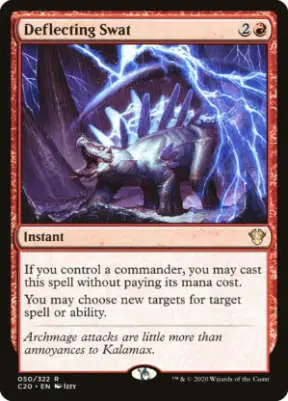
How Does The Deck Work:
The deck functions pretty simply. The deck looks to make the most out of Kalamax’s ability by frequently casting instants and sorceries. If he is tapped when these are cast, then he will copy the spell and give himself a +1/+1 counter. This means the deck wants him to be big enough to attack through opponent’s creatures or find a creative way to tap him down.
Notable Cards:
Pros And Cons:
| Pros | Cons |
| Synergistic | Relies heavily on commander |
| Combo potential | High mana value cards |
Upgrades:
The upgrades for the deck are mainly removing some high mana value spells and adding in some more enables for our instants and sorceries.
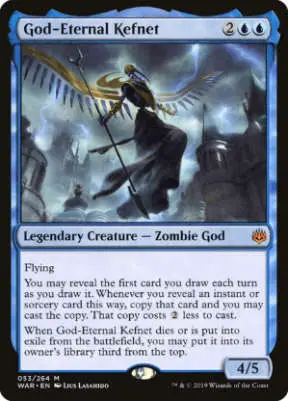
In: Goblin Electromancer, Baral, Chief Of Compliance, Young Pyromancer, God-Eternal Kefnet, Mystic Confluence, Pull From Tomorrow
Out: Shiny Impetus, Psychic Impetus, Predatory Impetus, Pako, Arcane Retriever, Wort, The Raidmother, Glademuse
Enhanced Evolution
Primary Commander:
Otrimi, the Ever-PlayfulColors:
Black, Green, Blue
Strength Out Of The Box:
Mutate is a mechanic that lets you essentially combine one create with another. Having the body of the creature on top with the abilities of the creature on the bottom. This allows the deck to be very versatile. Allowing the player to cast and morph whatever creatures together that will be needed for any given situation.
Related: MTG Mutate: How It Works
How Does The Deck Work:
The deck is built around the mutate mechanic. The deck aims to use mutate to give large creatures evasive abilities. Otrimi gives you a large aggressive body, along with a way to reanimate mutate creatures. So, the game plan is to mutate your commander with abilities that help him deal combat damage.
Then with him suited up to deal combat damage, attack and recur threats from the graveyard time and time again. The deck also has an x theme; ramping out large hydra’s to be mutate targets.
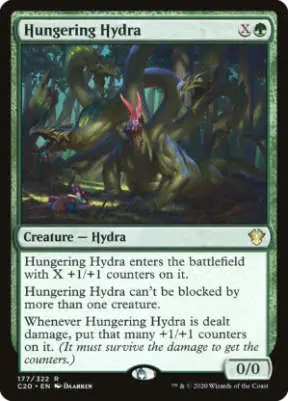
Notable Cards:
Pros And Cons:
| Pros | Cons |
| Good ramp | Vulnerable to removal |
| Versatile strategy | Needs multiple creatures out to work well |
| Commander can be cast for mutate cost from command zone |
Upgrades:
The upgrades come down to removing a few of the x spells. As well as some creatures that don’t have to mutate and aren’t good mutate targets. The creature spots will be used mainly for creatures that are good mutate bases. After that, we will just remove a few of the non-synergistic non-creature spells. These non-creature spots will be filled with some extra ramp, card draw reanimation spells.
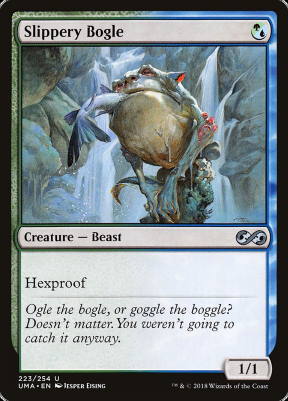
In: Return of the Wildspeaker, Back For More, Rampant Growth, Rishkar’s Expertise, Gladecover Scout, Slippery Bogle, Brokkos, Apex of Forever
Out: Genesis Hydra, Vastwood Hydra, Hungering Hydra, Parasitic Impetus, Predatory Impetus, Psychic Impetus, Gaze Of Granite
Symbiotic Swarm
Primary Commander:
Kathril, Aspect WarperColors:
White, Black, Green
Strength Out Of The Box:
The commander for the deck rewards you for having creatures with keyword abilities in your graveyard. The strength of the deck lies in this ability. This is because you often get value out of your cards simply by playing them out onto the field. This is true even if they quickly get removed or die blocking, they still serve a purpose for the deck. The deck doesn’t need to do anything but play magic to start to get ahead.
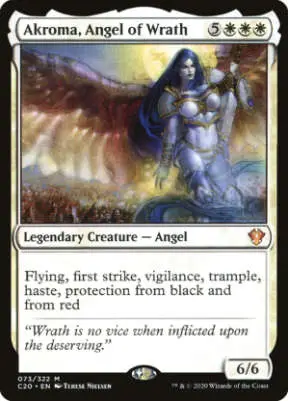
How Does The Deck Work:
The deck revolves around getting creatures with multiple keyword abilities into your graveyard. Then, Kathril can give creatures in play each of the abilities of creatures in the graveyard. Furthermore, he gets a +1/+1 counter for each ability he can bestow. The deck has several ways to stock its graveyard with powerful abilities and then bolster its entire
Notable Cards:
Pro And Cons:
| Pros | Cons |
| Good against removal | Weak against graveyard hate |
| Strong offense and defense | Reliant on commander |
Upgrades:
The creature upgrades for the deck will center on adding creatures with powerful keyword abilities. Creatures with abilities that can also fill the graveyard for the deck are particularly prioritized. For non-creature spells. We will remove some filler and add a reanimation package as well as a few power counter synergies for Kathril.
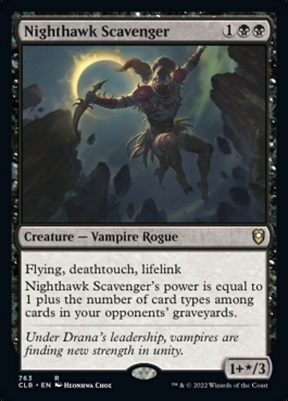
In: Stinkweed Imp, Sylvan Caryatid, Nighthawk Scavenger, Stitcher’s Supplier, Hardened Scales, Reanimate, Animate Dead
Out: Blood Curdle, Predatory Impetus, Parasitic Impetus, Kalemne’s Captain, Reveillark, Sunblast Angel, Tayum, Luminous Enigma
Ruthless Regiment
Primary Commander:
Jirina KudroColors:
Red, White, Black
Strength Out Of The Box:
The strength of this deck out of the box comes from its streamlined game plan. Ruthless regiment is one of the more focused precons. The commander is simple but extremely effective. Jirina being a powerful lord for the deck that gets better the more she is cast from the command zone makes the deck very consistent and aggressive.
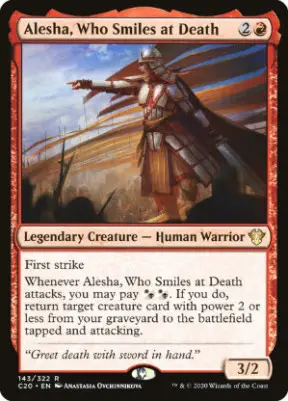
How Does The Deck Work:
The deck functions like most other tribal decks in commander. The deck wants to play out creatures of its tribe, which in this case is humans. Once the
Each time Jirina has been cast from the command zone she will create more and more human tokens each time she enters the battlefield. So, the deck wants to cast her from the command zone as many times as possible. Turning her into a one-card creature factory and powerful lord.
Notable Cards:
Pros And Cons:
| Pros | Cons |
| Strong tribal synergy | One dimensional strategy |
| Commander is enabler and payoff | Higher mana value commander |
| Aggressive |
Upgrades:
The upgrades for the deck are pretty simple. We will be swapping out some of the stock humans and adding more powerful ones. As well as some utility cards and tribal payoffs.
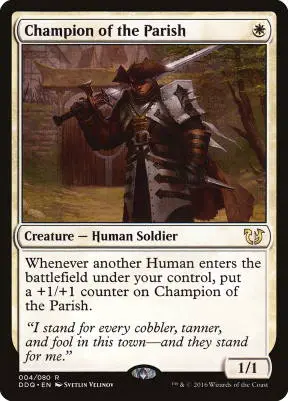
In: Champion Of The Parish, Syr Konrad, the Grim, Fiendslayer Paladin, Thalia, Heretic Cathar, Unbreakable Formation, Glorious Anthem
Out: Martial Impetus, Parasitic Impetus, Shiny Impetus, Magus Of The Wheel, Magus Of The Disk, Humble Defector
Commander 2019
Faceless Menace
Primary Commander:
Kadena, Slinking SorcererColors:
Black, Green, Blue
Strength Out Of The Box:
The strength of the deck lies in its ability to be disruptive to opponents. Laying traps to be sprung at the perfect time and forcing opponents to play around cards they can’t see. Kadena allowing you to cast the spells for a reduced price and rewarding you with cards makes her an enabler and a payoff for the deck’s game plan. The hidden information and Sultai colors mean the deck can play very proactively both on offense and defense.
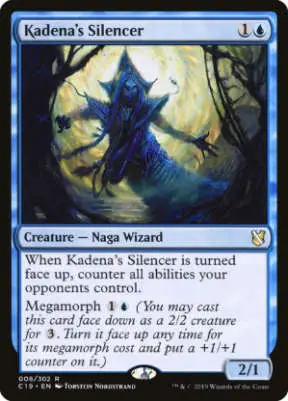
How Does The Deck Work:
The deck’s game plan is to morph and manifest the top cards of its library and hand. Keeping opponents guessing and playing around what cards you have facedown. Then using Kadena to cast them at the most effective time for a reduced price. The deck can keep this engine of faceless foes going strong with Kadena’s ability to draw a card whenever a face-down creature enters the battlefield.
Notable Cards:
Pros And Cons:
| Pros | Cons |
| Commander is payoff and enabler | Slow starter |
| Good interaction | Needs commander out to play well |
| Strong offense and defense |
Upgrades:
The upgrades for the deck try to home in on the deck’s main strategy of casting facedown spells. This will be done by adding higher power manifest and morph cards. As well as some foretell spells. To free up a few spots we will cut some of the flash creatures that don’t have much synergy.
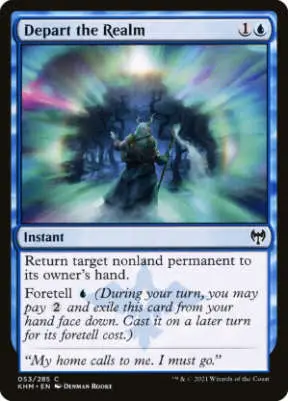
In: Dream Devourer, Battle Mammoth, Whisperwood Elemental, Temur Sabertooth, Ugin, the Ineffable, Depart The Realm, Doomskar
Out: Echoing Truth, Urban Evolution, Mire In Misery, Thought Sponge, Scaretiller, Voice Of Many, Great Oak Guardian
Mystic Intellect
Primary Commander:
Sevinne, the ChronoclasmColors:
Blue, Red, White
Related: The Best Blue Tutors In MTG
Strength Out Of The Box:
Some of the strength of the deck comes from having a commander that is immune to combat damage. While this is not her main focus for the deck it is an invaluable way to soak up damage throughout a game.
Furthermore, the ability to copy instant and sorcery spells cast from your graveyard gives the deck several advantages. First, this gives the deck an enormous opportunity for card advantage and selection. Second, it lends the deck the chance to copy its most powerful spells.
How Does The Deck Work:
This is a spell slinger deck at heart. This means that the deck wants to be casting instants and sorceries early and often. Sevinne’s ability to copy instants and sorceries you cast means that the deck gets extra value out of most of its spells.
Furthermore, choosing new copies for these copies means that the deck can affect multiple opponents with a single spell. The deck also has several other ways to copy spells. So, with Sevinne in play, the deck is capable of chaining several spells together and riding these instants and sorceries to victory.
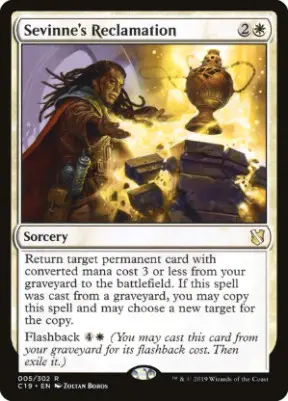
Notable Cards:
Pros And Cons:
| Pros | Cons |
| Strong late game | Slow in early game |
| Has good value engine | Lacks ramp |
| Good interaction | Needs commander out to function well |
Upgrades:
The upgrades for this spell-slinging Izzet deck are pretty simple. We remove a few stock creatures and artifacts that don’t further the strategy. Swapping them out for staple creatures and spells for the archetype.
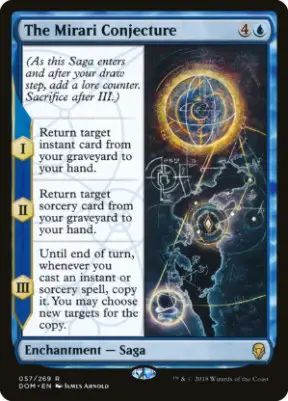
In: Baral, Chief of Compliance, Goblin Electromancer, Past In Flames. The Mirari Conjecture, God-Eternal Kefnet
Out: Bloodthirsty Blade, Azorius Locket, Scaretiller, Wall Of Stolen Identity, Pristine Angel
Merciless Rage
Primary Commander:
Anje FalkenrathColors:
Black, Red
Strength Out Of The Box:
The strength of the deck comes from Anje herself and how well she enables the rest of the deck. She can generate extra value from almost any spell in the deck. Additionally, her ability to loot can filter things like unwanted lands or dead cards into gas.
Furthermore, her low mana value allows her to be cast early while having haste means she can be activated the turn she comes into play. This low-to-the-ground strategy and synergy can put out threats and generate enormous value at the same time.
How Does The Deck Work:
The deck’s game plan is to discard and then cast spells for their madness cost. Allowing your commander to untap herself and draw you a card. Furthermore, the deck looks to chain multiple spells together per turn. Merciless Rage wants to be casting spells for a reduced cost by discarding them and refilling its hand in the process. All the while using the discards to load the graveyard with reanimation targets.
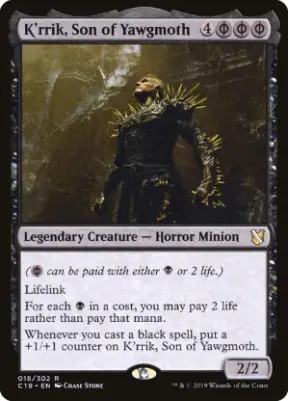
Notable Cards:
Pros And Cons:
| Pros | Cons |
| Highly synergistic | Slow mana base |
| Aggressive / Low mana value commander | Relies on commander to function |
| Good card advantage | Low number of madness cards in print |
Upgrades:
The upgrades for the deck are mainly removing some of the filler cards from the precon and adding in things that have more synergy. For example, new madness cards and some utility creatures. As well as some tutors and premium removal.
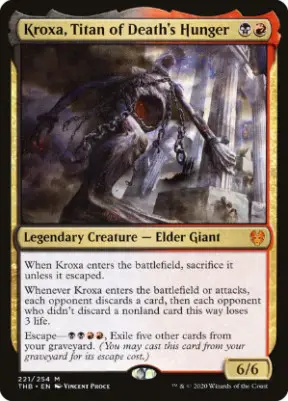
In: Anger, Kroxa, Titan Of Death’s Hunger, Gamble, Toxic Deluge, Terminal Agony, Archfiend Of Ifnir
Out: Aeon Engine, Bloodthirsty Blade, Hate Mirage, Skyfire Phoenix, Hedonist’s Trove, Scaretiller, Wildfire Devils
Primal Genesis
Primary Commander:
Ghired, Conclave ExileColors:
Red, Green, White
Strength Out Of The Box:
Ghired’s abilities are the driving points for most of the decks out of the box power. First, he creates a decent-sized token with trample any time he enters the battlefield. This gives you value the turn he comes into play.
Second, whenever he attacks, he populates, creating a copy of the best token on your side of the table. The combination of his abilities makes him a relatively self-sufficient commander. When Ghired is left unchecked, he can flood the
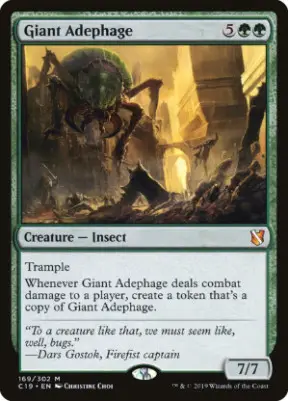
How Does The Deck Work:
The deck looks to create strong tokens and then populate them. Creating a massive army of powerful tokens to trample their way to victory. Ghired himself is a token producer and a populator when he attacks. So, the deck looks to set up opportunities for favorable attacks with its commander.
Notable Cards:
Pros And Cons:
| Pros | Cons |
| Aggressive Creatures | High mana value commander |
| Good ramp | Commander has to attack to trigger ability |
| Self-sufficient commander |
Upgrades:
Most of the cards being replaced are creature cards that don’t serve the overall game plan well. They will be replaced with strong token producers or cards that populate. While some of the stock non-creature spells will be subbed for ways to protect Ghired.
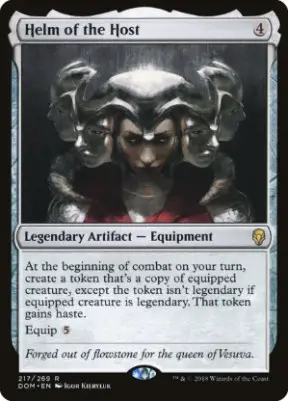
In: Crashing Footfalls, Adorned Pouncer, Honored Hydra, God-Eternal Oketra, Helm Of The Host, Swiftfoot Boots, Heroic Intervention
Out: Commander’s Insignia, Naya Charm, Colossal Majesty, Scaretiller, Roc Egg, Cliffside Rescuer, Tectonic Hellion
Commander 2018
Nature’s Vengeance
Primary Commander:
Lord WindgraceColors:
Black, Red, Green
Strength Out Of The Box:
Nature’s Vengeance is perhaps the strongest precons of recent years. Lord Windgrace excels in some of the most important areas for EDH decks. He offers card advantage, mana ramp, and a possible win condition on a single card. Furthermore, the deck offers numerous ways to put these abilities to great use. For example, using Windgraces’ -3 ability in conjunction with powerful landfall cards. While it uses his +2 for card selection and to fill the graveyard with reanimation targets.
Related: MTG Dual Lands: All Your Questions Answered
How Does The Deck Work:
The deck’s game plan starts with getting Lord Windgrace onto the field. Then the deck can use his first ability to discard lands for card advantage. Once the graveyard is stocked with lands they can be brought directly to the battlefield. This ramp is used to power out massive spells. As well as trigger the deck’s multitude of landfall spells multiple times each turn. Producing an engine of relentless ramp and unbridled power.
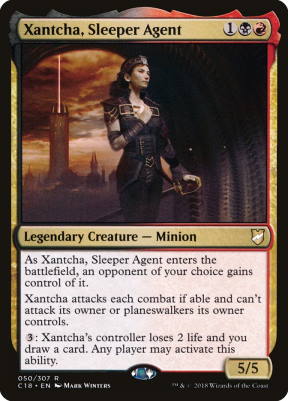
Notable Cards:
Pros And Cons:
| Pros | Cons |
| High-power commander | Relies heavily on commander |
| Strong land ramp | Slow starter |
| Trouble protecting commander |
Upgrades:
The upgrades for Nature’s Wrath are primarily adding more powerful “lands matter” cards. While taking out some of the cards that are off-strategy or underpowered.
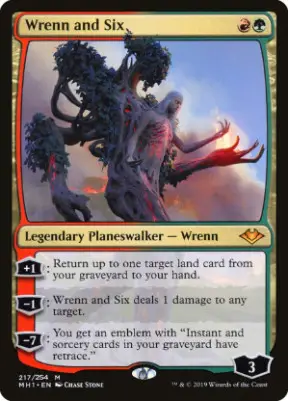
In: The Gitrog Monster, Multani, Yavimaya’s Avatar, Ramunap Excavator, Wrenn And Six, Scute Swarm, Mina And Denn, Wildborn
Out: Bloodtracker, Loyal Apprentice, Loyal Subordinate, Reality Scramble, Emissary Of Grudges, Borderland Explorer
Adaptive Enchantment
Primary Commander:
Estrid, The MaskedColors:
Green, White, Blue
Strength Out Of The Box:
Out of the deck, the deck functions extremely well as a midrange strategy. This is because Estrid is a jack of all trade commander for the deck. Providing the deck with ramp and utility. As well as a built-in way to protect the deck’s most important card type, enchantments. Enchantress builds are popular in commander and Estrid makes the archetype play smoothly right out of the box.
How Does The Deck Work:
This bant enchantress deck plays a very “go tall” strategy. There are a few other subthemes with mild support. However, the deck mainly wants to suit creatures up with Aura’s that make them both formidable threats and hard to remove. Then, swing to victory with a few powerful augmented threats.
Notable Cards:
Pros And Cons:
| Pros | Cons |
| Good long game | Lacks removal |
| Strong ramp | Slow starter |
| Lots of protection against removal | Trouble dealing with opposing creatures |
Upgrades:
Overall, the deck is very well built to its strengths. Most of the changes I would make would be cutting some of the clunkiest spells to add more targeted removal and interaction.
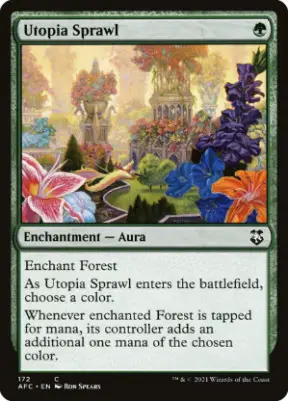
In: Swords To Plowshares, Darksteel Mutation, Imprisoned in the Moon, Utopia Sprawl, Abundant Growth, Verduran Enchantress
Out: Celestial Archon, Ajani’s Chosen, Loyal Unicorn, Bant Charm, Silent Sentinel, Spawning Grounds
Subjective Reality
Primary Commander:
Aminatou, the FateshifterColors:
White, Black, Blue
Strength Out Of The Box:
Commanders that can draw cards are usually very strong. Aminatou can draw cards. At the same time, she also gives you card selection and a way to manipulate the top card of your library. Furthermore, she can -1 to blink a permanent that you control. Given the strength of top deck manipulation and ETB triggers in commander, exploiting these abilities is the deck’s greatest asset out of the box.
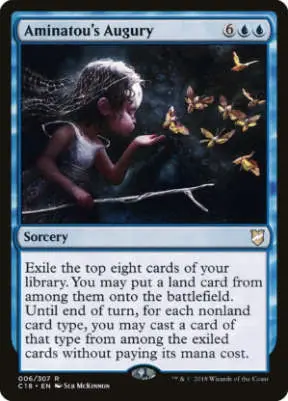
How Does The Deck Work:
This deck has one of the more unique strategies of recent precons. The deck plays like a control deck but seeks to manipulate the top cards of its library for value and powerful effects. Some examples of this “knowledge is power” style would be Yuriko, the Tiger’s Shadow, Devastation Tide, and Entreat the Angels. Cards such as these can act as win-cons for the deck and are its main payoffs. However, such great power over what cards the deck will draw next allows it to play a very solid control game in general.
Notable Cards:
Pros And Cons:
| Pros | Cons |
| Explosive | Slow starter |
| Good card advantage | Weak against mill |
| Well costed commander |
Upgrades:
Like with most of the mtg commander precons, there are a few different ways you could make the upgrades. First, I would add some cards to better take advantage of aminatou’s -1 ability. So, things with some really powerful ETB triggers. The second would be some spells to take advantage of the fact that our commander is a planeswalker.
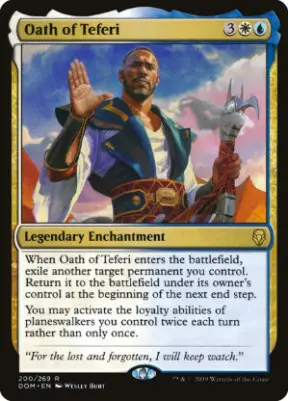
In: Cloudblazer, Felidar Guardian, Oath of Teferi, Peregrine Drake, Soulherder
Out: Loyal Subordinate, Loyal Unicorn, Sigiled Starfish, Skul Storm, Return To Dust
Exquisite Invention
Primary Commander:
Saheeli, the GiftedColors:
Blue, Red
Strength Out Of The Box:
Exquisite Invention is extremely focused and one of the more synergistic precons. This cohesiveness and Saheeli’s ability to make use of it is the deck’s greatest strength out of the box. The deck is an artifact matters deck and it is fully aware of its identity, as the deck plays a total of 41 artifacts. This streamlined strategy makes the deck play very smoothly and consistently right from the box.
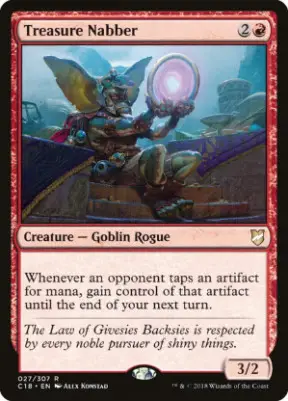
How Does The Deck Work:
Exquisite invention is fairly straightforward in terms of strategy. First, it wants to fill the
Notable Cards:
Pros And Cons:
| Pros | Cons |
| Well costed commander | Weak against mass artifact destruction |
| Extremely focused | High mana value spells |
| Good win con density | Slow starter |
Upgrades:
Considering the deck is pretty focused my upgrades will be to assist the deck to do what it already does so well. This will be achieved by adding in some protection against removal. As well as some more synergistic card draw.
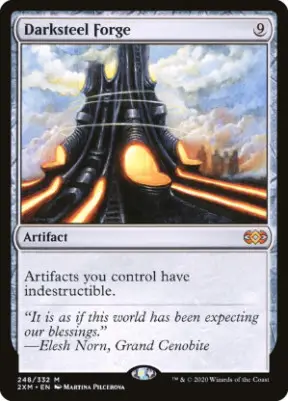
In: Padeem, Consul of Innovation, Daretti, Scrap Savant, Tezzeret, Artifice Master, Jhoira, Weatherlight Captain, Skullclamp, Darksteel Forge
Out: Loyal Drake, Loyal Apprentice, Steel Hellkite, Psychosis Crawler, Enchanter’s Bane, Varchild, Betrayer of Kjeldor
Commander 2017
Feline Ferocity
Primary Commander:
Arahbo, Roar of the WorldColors:
White, Green
Strength Out Of The Box:
The strength of the deck comes from the eminence ability. Having a commander that gives you benefits for your deck every turn without even having to be cast is huge. It makes the deck very consistent, always having access to one component of the deck even from the command zone.
Related: The 10 Best MTG White Board Wipes
How Does The Deck Work:
The strategy of this deck is “go tall” cat tribal. The deck wants to put cats into play. Then, pump them all up and swing in for piles of damage. The deck has a voltron feel but instead of pumping up its commander, it uses it as a pump spell.
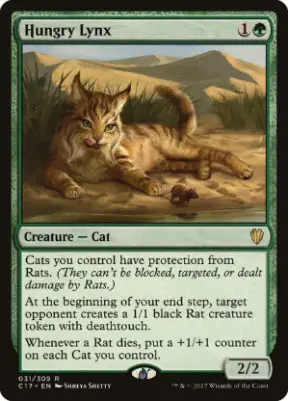
Notable Cards:
Pros And Cons:
| Pros | Cons |
| Strong tribal synergy | Slow starter |
| Commander has value from command zone | Very mana intensive |
Upgrades:
The deck has strong tribal synergy already. While we will upgrade some cats, we will mainly be upgrading the ramp and protection for the deck.
In: Kodama’s Reach, Explosive Vegetation, Brimaz, King Of Oreskos, Adorned Pouncer, Skyhunter Skirmisher
Out: Hedron Archive, Dreamstone Hedron, Phantom Nishoba, Jareth, Leonine Titan, White Sun’s Zenith
Draconic Domination
Primary Commander:
Colors:
White, Blue, Black, Red, Green
Related: The MTG Color Wheel
Strength Out Of The Box:
The Ur-Dragon is a very powerful commander. He can single-handedly enable a dragon tribal strategy. His ability to cheapen all your dragon spells even from the command zone is huge for the archetype. Furthermore, he refills your hand for attacking and then allows you to put your largest dragons right onto the field.
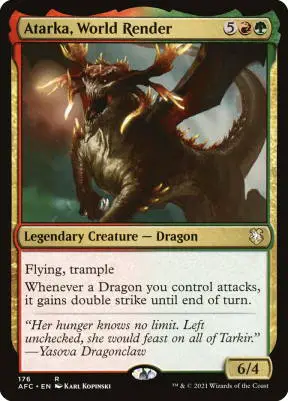
How Does The Deck Work:
This 5-color dragon tribal deck is built around its commanders’ ability to cheapen dragon spells from the command zone. This allows the deck to cast fierce dragons ahead of curve and build up a menacing
Notable Cards:
Pros And Cons:
| Pros | Cons |
| Strong tribal synergy | Slow starter |
| Card draw engine on commander | Poor mana base |
| Raw power | Commander is expensive to cast |
Upgrades:
The upgrades for the deck are to make it more focused and improve the mana base. To do this, we will remove some weaker non-dragon creatures and overpriced spells, and slow lands. In place of them, we will be adding, potent dragons, non-creature dragon payoffs, and lands that help fix our mana.
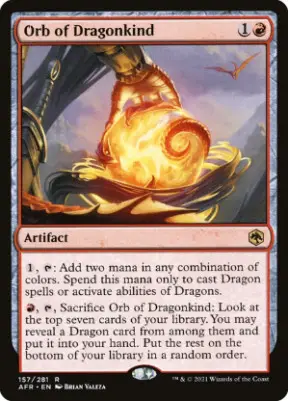
In: Lathliss, Dragon Queen, Dragon’s Hoard, Tiamat, Temur Ascendancy, Sarkhan Unbroken, Orb of Dragonkind, Temple of the Dragon Queen, Unclaimed Territory, Exotic Orchard
Out: Curse of Bounty, Curse Of Verbosity, Nihil Spellbomb, Orator of Ojutai, Fortunate Few, Dreamstone Hedron, Vivid Creek, Vivid Meadow, Vivid Marsh
Arcane Wizardry
Primary Commander:
Inalla, Archmage RitualistColors:
Blue, Black, Red
Strength Out Of The Box:
Like the other decks from C17, the strength out of the box lies in the commander’s eminence ability. Inalla’s ability to make a token copy of any wizard you cast gives the deck a great engine for aggression, as well as defensiveness. Letting it double up on the ETB triggers of all its wizards for only one mana. Not only can the deck churn out value and tokens but can close out games fast by tapping 5 untapped wizards and causing a big loss of life.
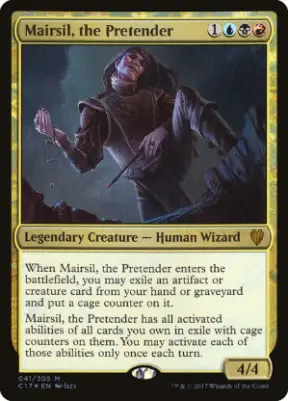
How Does The Deck Work:
The deck keys to victory lay largely on the back of its commanders ability to make token copies of its wizards. However, that is just an upside for playing wizards. Their powerful ETB triggers allow them to function well even when you don’t have the mana to make a copy.
With that said, the deck can be aggressive thanks to the extra attackers and defensive thanks to the disruptive ETB triggers. This allows the deck to chip away at opponents while ensuring it lives long enough to build up to 5 wizards and to turn them into 7 damage.
Notable Cards:
- Glen Elendra Archmage
- Cyclonic Rift
- Marchesa, the Black Rose
- Adaptive Automaton
- Purphoros, God of the Forge
Pros And Cons:
| Pros | Cons |
| Good interaction and card draw | Lacks ramp |
| Aggressive while being disruptive | Needs multiple cards at a time to function |
Upgrades:
The upgrades for the deck are removing some of the weaker tribal pieces and replacing them with things to double our triggers up even more. As well as some strong wizards that weren’t included in the stock list.
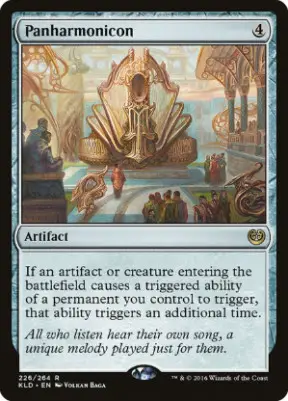
In: Leyline Of Anticipation, Venser, Shaper Savant, Patron Wizard, Panharmonicon, Imprisoned In The Moon
Out: Ogre Battledriver, Sea Gate Oracle, Viashino Pyromancer, Increasing Ambition, Go For The Throat
Vampiric Bloodlust
Primary Commander:
Edgar MarkovColors:
Red, White, Black
Strength Out Of The Box:
The Edgar Markov precon plays pretty well out of the box. This is mainly due to Edgar Markov himself being at the helm of the deck. He can put extra bodies onto the battlefield for every vampire you play. This gives the deck some good acceleration as well as recoverability after
How Does The Deck Work:
The deck wants to cast vampire creatures as frequently as possible. So that Edgar Markov can create a token whenever you do. With a
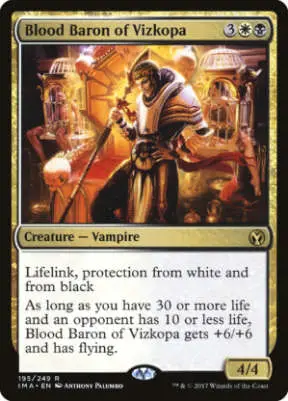
Notable Cards:
Pros And Cons:
| Pros | Cons |
| Effective “go wide” strategy | Needs many creatures for some cards to work well |
| Good pacing | Poor against non-creature matchups |
| Strong tribal synergy |
Upgrades:
The upgrades for this vampire tribal deck focus on homing in on the “go wide” strategy. This is done by cutting out the cards that support more of a go tall strategy. Additionally, some cards in the lifelink subtheme are swapped out for lifelink creatures that are better for the overall game plan.
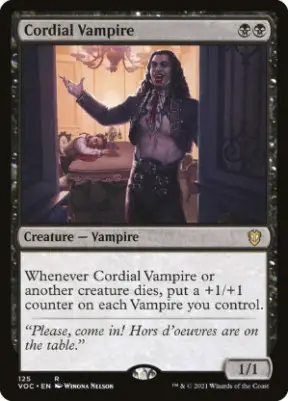
In: Mirror Entity, Sorin, Lord Of Innistrd, Bloodline Keeper, Mavren Fein, Dusk Apostle, Cordial Vampire, Knight Of The Ebon Legion.
Out: Sanguine Bond, Bloodsworn Steward, Skeletal Vampire, Curse of Vitality, Curse of Disturbance, Blade of the Bloodchief
Commander 2016
Open Hostility
Primary Commander:
Saskia the UnyieldingColors:
Black, Red, Green, White
Strength Out Of The Box:
The strength out of the box for this deck is its aggression. That, and its resource management. The deck achieves this by allowing you to deal damage to 2 players by attacking 1. This is a great asset for a deck looking to be as aggressive as possible and win through combat damage.
How Does The Deck Work:
The deck is looking to be as aggressive as it can. As a result, it plays the best attackers in all 4 of its colors. It then aims to have them deal damage to multiple opponents with each attack. This is achieved with Saskai’s ability. When she enters the battlefield, you choose one player to deal damage to whenever you damage any other player.
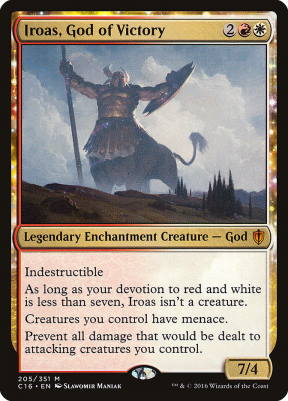
As an example, let’s say you choose “player B” when you cast your commander. While Saskai remains on the battlefield any combat damage you deal to players C or D, will also be dealt to player B. Furthermore, a new player can be chosen each time the commander is cast. This lets the deck be selective of its targets and helps the deck to close out games.
Notable Cards:
Pros And Cons:
| Pros | Cons |
| Aggressive | Relies heavily on commander |
| Good ramp and removal | Can struggle against lots of removal |
| Closes out games well |
Upgrades:
The ramp and removal is pretty solid out of the box. So, the upgrades here are adding cards that intensify our aggressive strategy. This includes good attackers as well as creatures and spells that let us deal damage to multiple opponents. These will replace some of the more stock and less powerful creatures and spells.
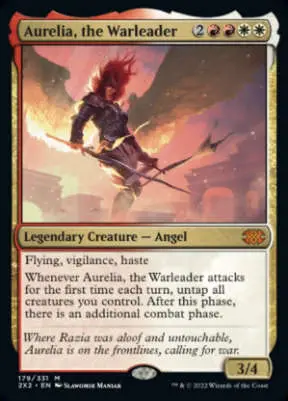
In: Gisela, Blade Of Goldnight, Aurelia, The Warleader, Elesh Norn, Grand Cenobite, Gahiji, Honored One, Dictate Of The Twin Gods, Aggravated Assault,
Out: Den Protector, Korozda Guildmage, Thelonite Hermit, Clan Defiance, Lavalanche, Charging Cinderhorn
Breed Lethality
Primary Commander:
Atraxa, Praetors’ VoiceColors:
Green, White, Blue, Black
Strength Out Of The Box:
Breed Lethality has a powerful gameplan, that is well-built around. Furthermore, Atraxa not only supports the game plan very well but is a potent threat herself. The deck is appropriately named and can grow even small creatures to be potent threats. This includes Atraxa herself, as she has a good stat line and a pile of valuable keyword abilities.
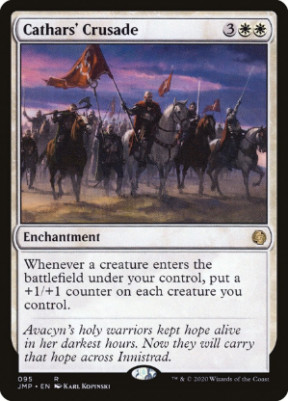
How Does The Deck Work:
The deck goes about achieving victory by putting counters onto its creatures. Then using the proliferate mechanic to grow them into an insurmountable attacking force. Atraxa gives each permanent with a counter another of that type, so not only will she grow your
Notable Cards:
Pros And Cons:
| Pros: | Cons |
| Multiple ways to victory | Color intensive commander |
| Good on offense and defense | Slow starter |
| Solid removal |
Upgrades:
The upgrades for the deck are simple but significant. The cards we will be adding are cards that will push the +1/+1 to be even more effective. While the cards we trim will be the ones that help the strategy the least.
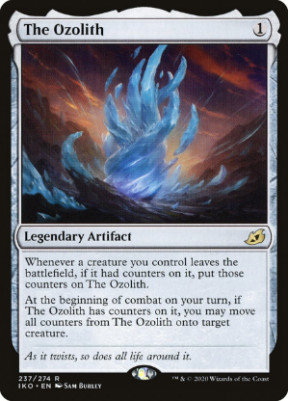
In: Doubling season, Ezuri, Claw Of Progress, The Ozolith, Odric, Lunarch Marshal, Ajani Steadfast, Contagion Clasp
Out: Grip of Phyresis, Migratory Route, Bane of the Living, Reveillark, Manifold Insights, Ancient Excavation
Entropic Uprising
Primary Commander:
Yidris, Maelstrom WielderColors:
Blue, Black, Red, Green
Strength Out Of The Box:
Entropic Uprising is a deck that feeds on the unknown. This disorder is one of the deck’s greatest strengths. The deck has several ways to evoke chaos. With that said, it is built to thrive in the maelstrom of this mayhem, while the opponents aren’t. The deck can sabotage other decks gameplans quite easily. All the while creating high-risk, high-reward situations for itself.
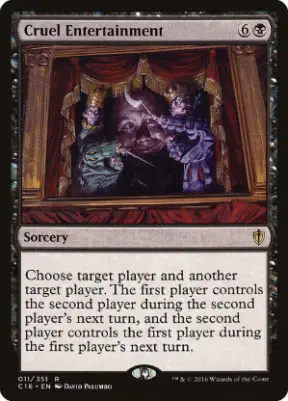
How Does The Deck Work:
Whenever Yidris deals combat damage to an opponent, spells you cast from your hand gain cascade. This does a lot more for the deck than card advantage. It creates volatile situations where no player is sure what is going to happen next. The deck also achieves this with wheel effects. Having each player discard all their cards and redraw, then taking advantage of the mayhem and full graveyards.
Related: MTG Cascade: How Does it Work?
Notable Cards:
Pros And Cons:
| Pros | Cons |
| Creates high-risk/high-reward situations | Your cards can work against you |
| Very disruptive to opposing game plans | Commander has to deal damage to cascade |
Upgrades:
There are tons of different ways to upgrade this deck as it is one of the more complex mtg commander precons. I will be staying with the wheel plan for my upgrades. So, most of the upgrades will be increasing the consistency of the deck. While also adding things like suspend spells to further abuse cascade triggers.
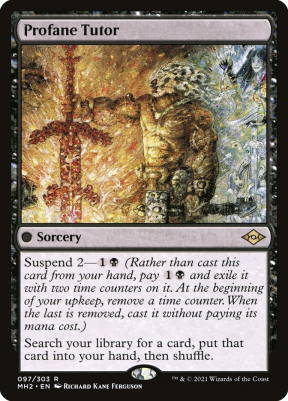
In: Averna, the Chaos Bloom, Sakura-Tribe Elder, Shardless Agent, Profane Tutor
Out: Worm Harvest, Academy Elite, Goblin Spymaster, Spellheart Chimera
Stalwart Unity
Primary Commander:
Kynaios and Tiro of MeletisColors:
Red, Green, White, Blue
Strength Out Of The Box:
This deck could be described as having a group hug strategy. Everyone will get to draw cards or drop out extra lands. However, you get to do both. The strength out of the box is the deck’s pillow-fort capabilities. This ensures that all those extra resources that your opponents get go towards each other instead of you.
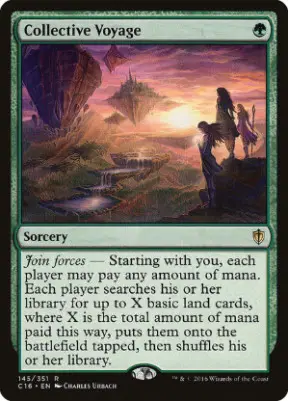
How Does The Deck Work:
As mentioned above, the deck uses cards that offer all players extra resources. This includes things like card draw and land drops. This will accelerate everyone at the table’s game plan. However, the deck plays lots of cards that keep the heat off of you. This not only serves to protect you, but it ensures that your opponent’s use their extra cards to weaken each other.
Notable Cards:
Pros And Cons:
| Pros | Cons |
| Good card draw | Can help opponents |
| Good ramp | Needs protection cards to survive |
| Pillow-fort strategy |
Upgrades:
The deck plays pretty well out of the box. However, there are some areas that can be made better. I would start with adding more universal card draw. Not only is it great for us but it is also on theme for the deck. With so much card draw we will also add in a few simple cards to abolish our hand size. It’s also worth adding in a few cards to hinder our opponent’s ability to use their extra resources effectively.
In: Prosperity, Dictate Of Kruphix, Thought Vessel, Grand Abolisher, Reliquary Tower, Thalia, Heretic Cathar
Out: Forest, Island, Akroan Horse, Rubblehulk, Assault Suit, Keening Stone
Invent Superiority
Primary Commander:
Breya, Etherium ShaperColors:
White, Blue, Black, Red
Strength Out Of The Box:
This precons strength from the box is its consistency. This consistency comes for commander’s ability to enable the rest of the deck. She has 3 pretty versatile abilities that you can choose from by sacrificing 2 artifacts.
Where the deck shines is that the commander makes 2 artifact tokens when she enters the battlefield. Furthermore, she has a way to sacrifice the artifacts she makes as well. This makes her capable of getting the deck firing without any other cards if necessary.
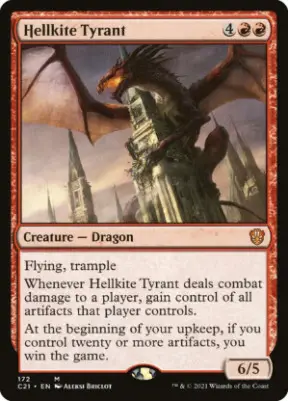
How Does The Deck Work:
This is one of the more strategically diverse mtg commander precons. Each of its 4 colors is well represented within the deck. This includes the reanimation of large artifacts, which is a common theme for black. As well as “go wide” token strategies, mass pump effects, and equipment synergies that are common in blue, white, and red. Whether it’s 1 large artifact or ten small ones the deck wants to make artifacts and turn them sideways to get wins.
Notable Cards:
Upgrades:
The deck’s diversity makes it upgradable in a plethora of different ways. Regardless of how you choose to upgrade though, there are some staples that you could include regardless of your play style.
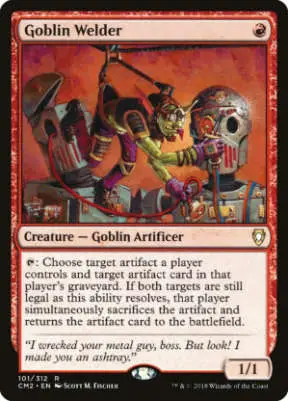
In: Daretti, Ingenious Iconoclast, Enlightened Tutor, Reshape, Goblin Welder, Phyrexian Metamorph, Wurmcoil Engine, Blightsteel Colossus, Ashnod’s Altar
Out: Migratory Route, Vedalken Engineer, Filigree Angel, Hellkite Igniter, Magus of the Will, Ethersworn Adjudicator, Grave Upheaval, Parting Thoughts
Commander 2015
Seize Control
Primary Commander:
Mizzix of the IzmagnusColors:
Blue, Red
Strength Out Of The Box:
Seize control is a deck that cares about casting instant and sorcery spells. The deck’s strength lies in its commander’s ability to reduce the cost of your spells. The longer the game goes and the bigger the spells you cast are, the more of a reduction you get. This gives the deck some great inevitability and late-game power.
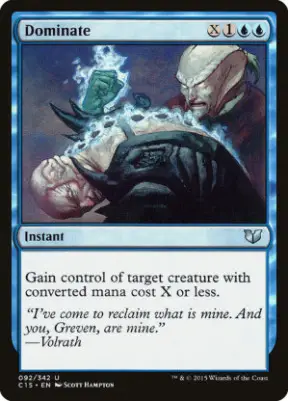
How Does The Deck Work:
This spell slinger deck plays pretty simply. Mizzix reduces the cost of your instant and sorcery spells. So, he wants to see you cast as many of these card types as possible. Playing higher and higher mana value instants and sorceries gives you the chance for even greater cost reduction. This means that as the game goes on the deck stands to play out massive game-ending spells for a fraction of their actual cost.
Related: The Best Red Tutors In MTG
Notable Cards:
Pros And Cons:
| Pros | Cons |
| Good late game | Poor mana ramp |
| Can cast large spells ahead of curve | High mana value spells |
| Good card draw | Slow starter |
Upgrades:
There are not too many bad cards in the stock version. However, there are certainly some powerful instants and sorceries we can play over some of the weaker ones. We will also add in a few tutors and dig spells to help us hit specific spells and up our consistency.
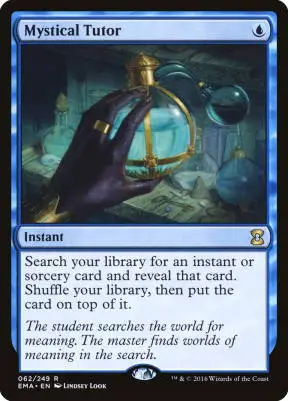
In: Braingeyser, Invoke the firemind, Mystical Tutor, Collected Conjuring, Reiterate
Out: Chain Reaction, Awaken the Sky Tyrant, Dragon Mage, Illusory Ambusher, Psychosis Crawler
Plunder The Graves
Primary Commander:
Meren Of Clan Nel TothColors:
Black, Green
Strength Out Of The Box:
The main upside out of the box for this deck is how well its main and sub-strategies work together. First and foremost is the reanimator portion of the game plan. Maren allows you to reanimate something once per turn. The size of the target depends on how many experience counters you have. This is where the second portion of the deck comes into play.
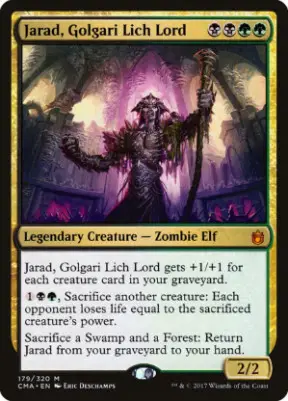
Maren collects these counters every time one of your creatures die. So, the deck also features a heavy aristocrat’s theme. The deck has an extremely efficient “Sack something for counters and then reanimate it later” engine with these 2 abilities.
How Does The Deck Work:
This reanimator/aristocrats deck plays how you might imagine it would. It wants to lose creatures. This includes in combat, to removal, or sacrificing them for value. The more creatures that die the bigger of threats can be reanimated later. So, the deck wants to fill its graveyard fast, lose creatures and bring spells right back to the field, creating an undying army of minions to erode opponents’ life to 0.
Notable Cards:
Pros And Cons:
| Pros | Cons |
| Good removal | Weak against graveyard hate |
| Gets stronger as the game goes on | Heavily relies on commander |
| Card advantage engine | Takes time to set up winning structure |
Upgrades:
The upgrades for the deck revolve around making sure the deck has reanimation spells aside from its commander. As well as, adding some good sac fodder, things to make our opponents sacrifice things and sacrifice outlets.

In: Plaguecrafter, Smallpox, Bitterblossom, Viscera seer, Reanimate, Animate dead
Out: Spider Spawning, Bonehoard, Phyrexian Rager, Viridian Emissary, Champion of Stray Souls, Sever the Bloodline
Swell The Host
Primary Commander:
Ezuri, Claw Of Progress
Colors:
Blue, Green
Strength Out Of The Box:
The strength of this simic deck is its ability to grow early creatures into threats. This strategy lets the deck be active in the early game while slowly developing its
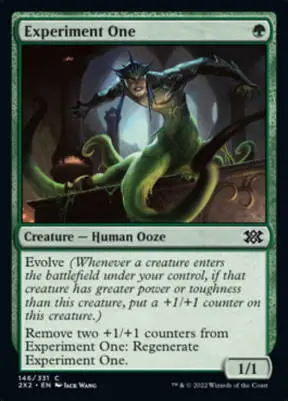
How Does The Deck Work:
The primary game plan is to play creatures with power 2 or less, that are a good base for counters later in the game. Each time you cast a requisite creature, Ezuri will give you an experience counter. Then, at the start of combat on your turn, give a creature you control +1/+1 counters equal to your experience counters. Therefore, the deck wants to cast as many of these small creatures as possible, building up a
Related: The Top 10 MTG Blue Board Wipes
Notable Cards:
Pros And Cons:
| Pros | Cons |
| Good early and late game | Hard time surviving lots of removal |
| Strong interaction | Needs to protect commander to function well |
Upgrades:
The cards being added here are to better focus the +1/+1 counter synergy for the deck. Making it more consistent and upping the finishing power of the deck. The cards being removed are some less focused cards that don’t advance the main strategy.
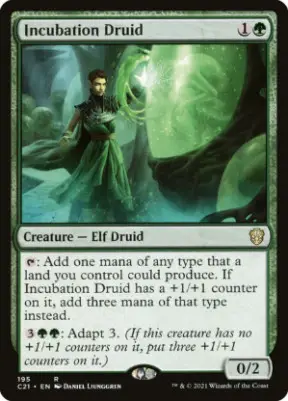
In: Pteramander, The Ozolith, Incubation Druid, Hadana’s Climb, Hydroid Krasis, Herald of secret streams
Out: Snakeform, Mirror Match, Biomantic Mastery, Orochi Hatchery, Scytheclaw, Noble Quarry
Wade Into Battle
Primary Commander:
Kalemne, Disciple Of IroasColors:
Red, White
Strength Out Of The Box:
This giant tribal deck has a few things going for it. One of its biggest assets is raw power. The deck plays some of the biggest creatures red and white has to offer and has many payoffs for playing creature spells with mana value 5 higher. This gives the deck a great late game and rewards the deck with extra value for playing powerful creatures.
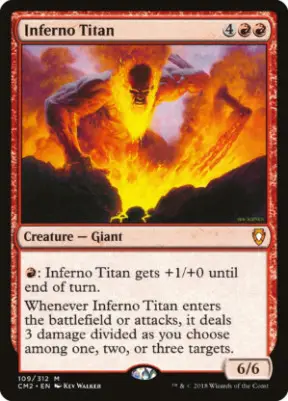
How Does The Deck Work:
The deck wants to cast large creatures and get value for doing it. Particularly creature spells with a mana value of 5 or greater. Each time the deck does so with its commander out, it gains an experience counter. Then turns each of those experience counters into +1/+1 counters for its commander. While the 4 mana 3/3 may not seem overly aggressive, the counters add up quickly and double strike makes each attack ferocious.
Notable Cards:
- Fiery Confluence
- Rite of the Raging Storm
- Blade of Selves
- Urza’s Incubator
- Gisela, Blade of Goldnight
Pros And Cons:
| Pros | Cons |
| Powerful creatures | Slow starter |
| Strong late game | High mana value spells |
| Good vs other creature decks |
Upgrades:
The deck cares about large creatures in general. However, the deck features 2 tribal sub-themes as well. One being angel creatures and the other being giants. Cutting one of these tribes out, for the most part, will make the deck more synergistic and streamlined.
For my upgrades, I have chosen to upgrade the giant portion of the deck. The ones listed below are ones I thought had utility in addition to being giants. There are many more that could be added.
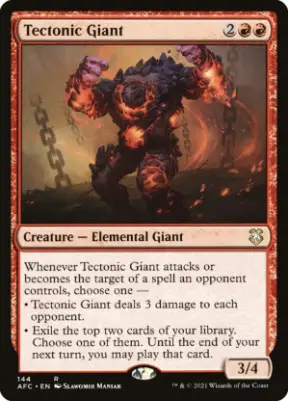
In: Realm-cloaked Giant, Calamity Bearer Quakebringer, Surtland Flinger, Tectonic Giant
Out: Dream Pillager, Dawnglare Invoker, Herald of the Host, Earthquake, Faith’s Fetters
Call The Spirits
Primary Commander:
Daxos the ReturnedColors:
White, Black
Strength Out Of The Box:
Enchantments are a powerful card type in commander. The strength of the deck out of the box is its commander’s ability to turn this powerful permanent into creatures later in the game. This means every enchantment is a threat to opponent’s life totals in addition to whatever else it may do. Daxos’ activated ability is also an amazing mana sink late in the game and can be a win condition for the deck.
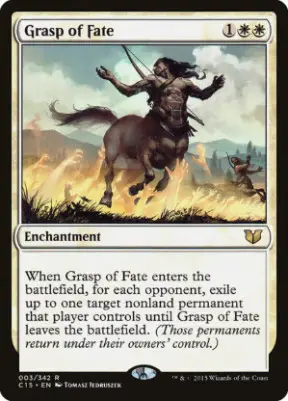
How Does The Deck Work:
The deck seeks to play enchantments that will get it ahead of its rivals. Once these powerful permanents have pulled the deck into a position of opulence, Daxos’ ability can be used to create large creature tokens. This can even be activated several times per turn when the deck has excess mana. There are also several ways for the deck to gain life, ensuring it makes it to the late game.
Notable Cards:
| Pros | Cons |
| Low mana value commander | Slow starter |
| Good removal and disruption | Mana intensive commander ability |
| Resilient | Weak against enchantment hate |
Upgrades:
Like with most decks, there are a few different ways you could choose to do upgrades. I am going to upgrade more towards the enchantment portion of the deck by swapping out some underpowered or non-synergistic cards for more powerful ones. While also adding in some enchantment-based removal.
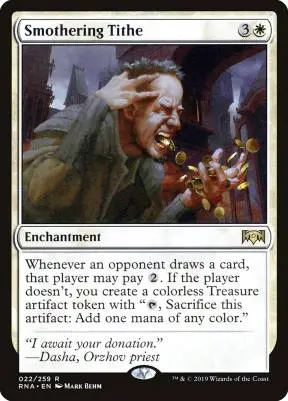
In: Hallowed Haunting, Sphere Of Safety, Starfield Mystic, Extinguish All Hope, Darksteel Mutation, Smothering Tithe, Enlightened Tutor
Out: Death Grasp, Return to Dust, Thief of Blood, Sandstone Oracle, Monk Idealist, Kor Sanctifiers, Herald of the Host
Commander 2014
Peer Through Time
Primary Commander:
Teferi, Temporal ArchmageColors:
Blue
Strength Out Of The Box:
The strength of this mono-blue precon is its ability to be controlling. That, and Teferi’s -1 ability. The controlling nature of the deck ensures the deck gets to the late game where it can deploy its threats. As mentioned, Teferi’s -1 ability is a huge asset for the deck. Allowing it to untap lands and mana rocks for ramp, or to leave up mana for countermagic. Or simply untap creatures after combat, helping the deck to be offensive while still protecting itself.
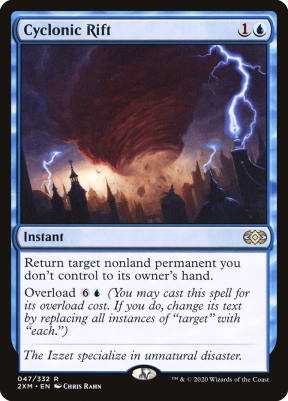
How Does The Deck Work:
The deck plays somewhat like a typical control-style deck. It looks to be defensive in the early turns of the game, managing its resources and life total while gaining control of the game. It achieves this with card draw, cheap but effective interaction, and disruptive creatures. Once in the late game, it can deploy its threats while opponents struggle to refill their hands or rebuild their boards.
Notable Cards:
Pros And Cons:
| Pros | Cons |
| Good Interaction | High mana value commander |
| Strong late game | Slow starter |
| Resilient |
Upgrades:
The upgrades for the deck could go several ways. I am going to upgrade to better fit Teferi as the commander. This will be done by adding more planewsalkers to benefit from his powerful ultimate. In addition, I am going to cut a few of the more vanilla creatures and add more control pieces.
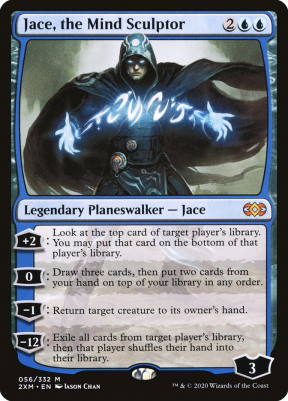
In: Jace, the Mind Sculptor, Karn Liberated, Tamiyo, the Moon Sage, Fierce Guardianship, Counterspell, Capsize, Cryptic Command
Out: Brine Elemental, Scourge of Fleets, Stormtide Leviathan, Jace, the Living Guildpact, Fool’s Demise, Reduce to Dreams, Dismiss
Built from Scratch
Primary Commander:
Daretti, Scrap SavantColors:
Red
Strength Out Of The Box:
The strength out of the box for this mono-red artifact strategy is its consistency. The deck is packed with artifacts, which is exactly what the deck needs. Furthermore, Daretti gives the deck 2 pieces of the puzzle needed for success all by himself. Namely, a way to get strong artifacts into the graveyard and a way to reanimate them.
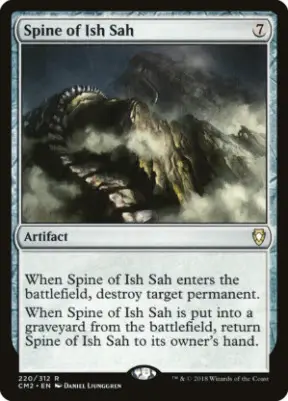
How Does The Deck Work:
The game plan for the deck is overall pretty straightforward. The deck wants to fill its
Notable Cards:
Pros And Cons:
| Pros | Cons |
| Very synergistic | Weak against graveyard hate |
| Well costed commander | Has trouble coming back if it falls behind |
| Commander is enabler and payoff |
Upgrades:
There are tons of different directions upgrades for this could go. I am going to keep the general strategy the same and simply upgrade the power of some of the artifacts. As well as a few things to help the consistency even more.
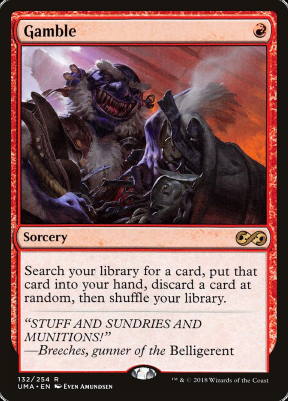
In: Memory Jar, Gamble, Krark-clan Ironworks, Goblin Engineer, Mindslaver, Blightsteel Colossus
Out: Dreamstone Hedron, Jalum Tome, Beetleback Chief, Flametongue Kavu, Spitebellows, Word of Seizing
Guided By Nature
Primary Commander:
Freyalise, Llanowar’s FuryColors:
Green
Strength Out Of The Box:
Overall, the strength of the deck lies in its strong elf tribal synergy. The deck is low to the ground and can churn out elves that can be aggressive as well as have utility for many situations and game states. The deck also has several different win cons right out of the box.
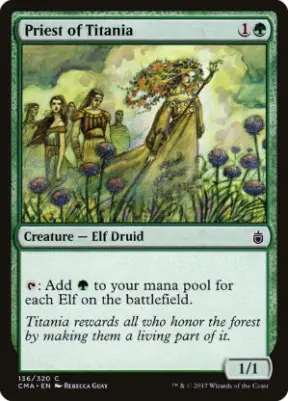
How Does The Deck Work:
The strategy works largely the same as other elf tribal or “go wide” game plans. It wants to accelerate into casting as many elves as possible. Once the
Related: The Best MTG Green Tutors
Notable Cards:
Pros And Cons:
| Pros | Cons |
| Great synergy | Commander is more support card than synergy |
| Solid ramp | Can struggle against removal heavy decks |
| Multiple win conditions |
Upgrades:
The upgrades here are pretty straightforward. We will keep with the Elf tribal theme and add in the best elves and support cards that aren’t in the deck already. We will make room for new spells by simply cutting out some of the less synergistic cards.
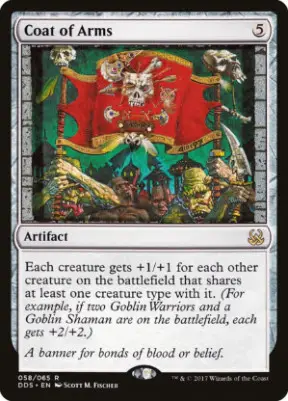
In: Elvish Champion, Wirewood Channeler, Coat of Arms, Obelisk of Urd, Marwyn, the Nurturer, Realmwalker
Out: Hornet Queen, Rampaging Baloths, Silklash Spider, Thornweald Archer, Predator, Flagship, Loreseeker’s Stone
Forged In Stone
Primary Commander:
Nahiri, the LithomancerColors:
White
Strength Out Of The Box:
The strength out of the box lies in the deck’s ability to generate a massive
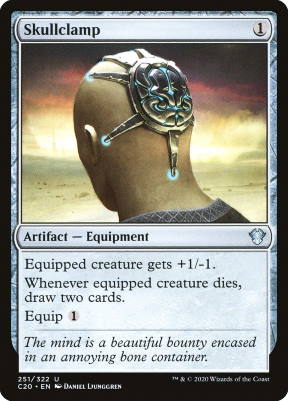
Nahiri’s first ability helps make the deck very consistent by creating creatures for equipment to go on as well as letting you attach it for free. As well as offering a way to protect herself. Furthermore, her second ability lets you recur equipment you have lost. This combination of abilities makes her effective regardless of your
How Does The Deck Work:
The deck has 2 main components in its plan for victory. Create lots of tokens and then make them bigger. First, it wants to generate a lot of tokens and establish a nice wide
Notable Cards:
Pros And Cons:
| Pros | Cons |
| Commander is good in any | Can get stuck with only creature or equipment |
| Explosive | Struggles against |
| Good against other creature decks |
Upgrades:
The upgrades for the deck are going to be geared a little bit toward improving the equipment side of the deck as opposed to the token portion.
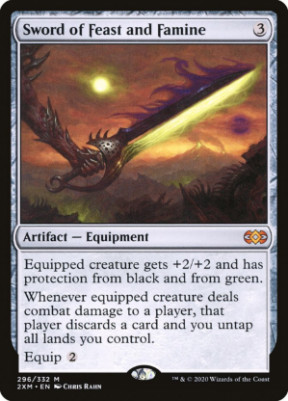
In: Batterskull, Sword Of Feast and Famine, Umezawa’s Jitte, Stoneforge Mystic, Steelshaper’s Gift, Puresteel Paladin, Colossus Hammer
Out: Strata Scythe, Assault Suit, Loreseeker’s Stone, Return To Dust, Serra Avatar, Sacred Mesa, Whitemane Lion
Sworn To Darkness
Primary Commander:
Ob Nixilis of the Black OathColors:
Black
Strength Out Of The Box:
This mono-black precon has quite a few strengths right of the box and is one of the stronger precons of its era. Perhaps the deck’s main strength is its ability to gain incremental value in almost everything it does. This can be seen when activating its commander to drain and gain or sacrificing creatures to get its cheap “morbid” removal online. In typical black fashion, the deck uses everything as a resource and reaps advantage from it.
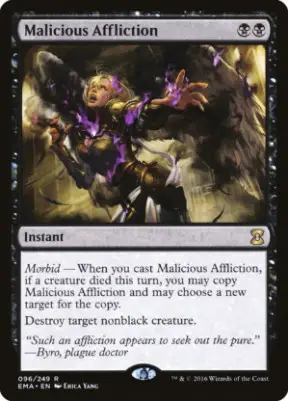
How Does The Deck Work:
The deck has many strategies melded together and working to achieve its goals. These themes include aristocrat-style sacrificing of creatures, drain and gain of life, and reanimation. The common thread that weaves them all together is generating value from whatever it’s doing. As an example, the deck might sacrifice a creature to draw cards, which will put “morbid” online for things like Tragic Slip by doing so. While additionally, now have another reanimation target in the graveyard.
Notable Cards:
Pros And Cons:
| Pros | Cons |
| Versatile strategies | Not super focused |
| Good creature removal | Trouble answering artifacts and enchantments well |
| Generates value well |
Upgrades:
The upgrades here will leave the multifaceted value engines. However, we will try and focus the deck’s core strategies a bit. Mainly through adding some tutors and strengthening each area in general. As far as cuts we will just trim some of the oddball cards.
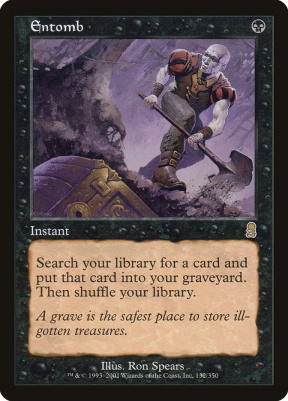
In: Diabolic Intent, Living Death, Grave Pact, Entomb, Buried Alive
Out: Pestilence Demon, Liliana’s Reaver, Butcher of Malakir, Drana, Kalastria Bloodchief, Morkrut Banshee
Commander 2013
Mind Seize
Primary Commander:
Jeleva, Nephalia’s ScourgeColors:
Blue, Black, Red
Strength Out Of The Box:
The strength of this precon comes from its commander’s versatility and ability to scale in value as the game goes on. The more she is cast from the command zone the more powerful her ability becomes. This gives the deck some great built-in inevitability. Furthermore, she is very good on the battlefield as well as from the command zone. Meaning she has an ever-present effect on the game.
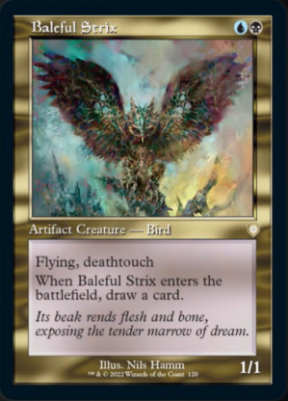
How Does The Deck Work:
The deck is built to operate around its commander’s ability to cast instants and sorceries without paying their mana cost. So naturally, the deck plays all the deadliest high mana value spells in its colors. It seeks to cast its commander from the command zone as many times as possible; exiling more and more cards each time. Then attacking and casting huge game-winning spells from exile.
Notable Cards:
Pros And Cons:
| Pros | Cons |
| Can cost large spells for free | One dimensional strategy |
| Multiple win cons | Slow starter |
| Commander is good on battlefield and in command zone |
Upgrades:
This is another precon that has several ways it could be upgraded. My upgrade path will stick to maximizing the effectiveness of the commanders’ abilities. This primarily means adding the most impactful instants and sorceries possible in its colors.
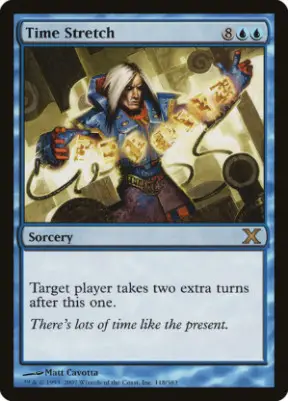
In: Omniscience, Blatant Thievery, Obliterate, Promise of Power, Baral, Chief of Compliance, Time Stretch
Out: Crosis’s Charm, Fissure Vent, Curse of Chaos, Curse of Inertia, Curse of Shallow Graves, Price of Knowledge
Eternal Bargain
Primary Commander:
Colors:
White, Blue, Black
Strength Out Of The Box:
Oloro’s ability to enable not only his deck, but himself as well is one of the deck’s key strengths. As an example, he gains you life both on the field and in the command zone and gives you a way to use that life. Furthermore, the way he utilizes life gain is by turning it into card advantage. With that said, card draw and slowing the pace of the game with life gain makes for a perfect control shell in Esper.

How Does The Deck Work:
The deck plays a slow, methodical, control-based strategy. It focuses most of its creatures and win cons around life gain triggers. The deck looks to hide behind the life its amassing each turn and its good interaction package to stabilize itself to the late game. Then win the game with cards like Sanguine Bond, Serra Avatar and Cradle Of Vitality.
Notable Cards:
Pros And Cons:
| Pros | Cons |
| Commander is good from battlefield and command zone | Expensive commander to cast |
| Controlling strategy | Commander needs protection |
| Good removal | Slow starter |
Upgrades:
The upgrades for this life-gaining esper build are pretty straightforward. We will be swapping out cards that aren’t very synergistic, for cards with strong life gain payoffs. As well as cards to further support some of the thopter cards in the deck. This will make the deck more powerful and synergistic.
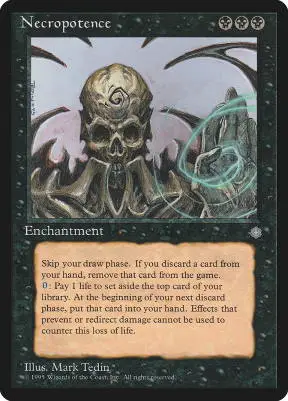
In: Vincer’s Journal, Necropotence, Sword of the meek, Serra Ascendant, Blood Baron of Vizkopa
Out: Nihil Spellbomb, Sun Droplet, Hooded Horror, Marrow Bats, Serene Master
Evasive Maneuvers
Primary Commander:
Derevi, Empyrial TacticianColors:
Green, White, Blue
Strength Out Of The Box:
This deck features one of the more powerful commanders to come from the commander precons. Derevi herself is one of the deck’s biggest strengths out of the box. This is because she can forgo commander tax and be put directly into play for 4 mana.
This is a massive advantage for the deck. Furthermore, her ability to tap and untap permanents are extremely versatile for the deck. As an example, it can be used to generate mana by untapping things like Gaea’s Cradle or Simic Growth Chamber. Or be used in combat to tap opposing blockers or untap creatures post-combat.
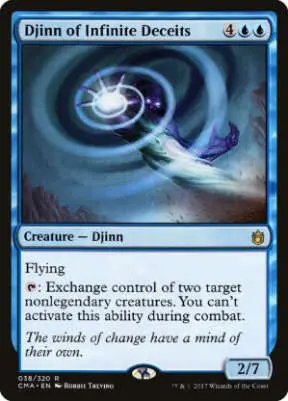
How Does The Deck Work:
Like most EDH deck, Evasive Maneuvers works towards victory using its commander’s abilities. In this case, that means using Derevi’s ability to tap and untap permanents. This allows the deck to be defensive by tapping down opposing threats.
While giving it options to move its own plans forward by untapping its lands, creatures or mana rocks. Furthermore, the deck uses evasive creatures that can easily chip in for damage while also activating Derevi. There is also strong blink synergies in the deck to make the most out of its commander and other creatures powerful ETB triggers.
Notable Cards:
Pros And Cons:
| Pros | Cons |
| Versatile game plan | Needs creatures to deal combat damage |
| Commander can be cast for reduced cost | Not streamlined |
| Multiple routes to victory |
Upgrades:
The upgrades for the deck are some of the more generic power upgrades. Simply replacing some weaker cards with ones that have a similar but more powerful effect. This will increase the power of the deck and make our commander’s abilities more valuable. The overall goal is to be able to close out games easier.
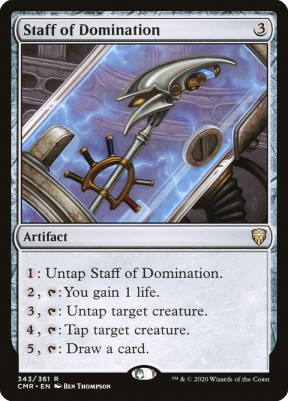
In: Twilight Shepherd, Staff of Dominance, Woodfall Primus, Sower of Temptation, Deadeye Navigator
Out: Acidic Slime, Dungeon Geist, Surveyor’s Scope, Diviner Spirit, Hada Spy Patrol,
Nature Of The Beast
Primary Commander:
Marath, Will Of the wildColors:
Red, Green, White
Strength Out Of The Box:
The strength out of the box comes from Marath’s abilities being so versatile. Not only do they give you options, but the power level of the abilities scale with how many times you have cast Marath from the command zone. If you have creatures out, he can make them bigger.
If you don’t, he can create creature tokens for you. Additionally, he can potentially remove an opponent’s creature by dealing it damage. The fact that he has game no matter the
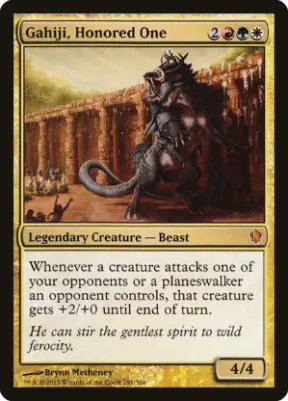
How Does The Deck Work:
The deck has multiple avenues to victory. It usually wants to cast its commander a few times, using its different abilities as the situation warrants. Depending on how things go, the deck is capable of executing a very good “go wide” or “go tall” strategy. It also has many well-costed, large creatures that can be given evasion and act as win cons. Additionally, the deck is capable of producing quite a bit of tokens that can overwhelm opponents.
Notable Cards:
Pros And Cons:
| Pros | Cons |
| Extremely versitile | Mana intensive |
| Commander gets stronger in late game | Not streamlined |
| Multiple routes to victory | Slow starter |
Upgrades:
This deck could be upgraded in a lot of different ways. With that said, I am going to focus my upgrades on being broad and effective for all the main strategies. This includes things that could help produce more counters for Marath and his abilities. As well as things that get more value out of the deck’s tokens.
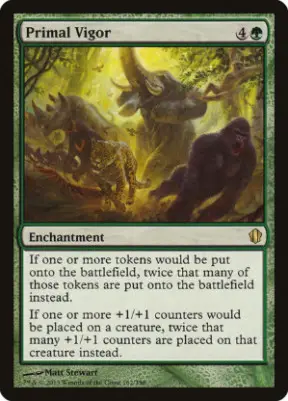
In: Hardened Scales, Doubling Season, Ajani Goldmane, Mana Reflection, Mirari’s Wake, Primal Vigor, Divine Visitation
Out: Naya Charm, Archangel, Deadwood Treefolk, Seer’s Sundial, From the Ashes, Curse of Chaos, Selesnya Charm
Power Hungry
Primary Commander:
Prossh, Skyraider of KherColors:
Black, Red, Green
Strength Out Of The Box:
This commander has proven to be one of the most popular to come from a precon, and with good reason. It is a powerful commander and is the deck’s main enabler and strength out of the box. Prossh is the definition of a commander that is an enabler and a payoff for their own abilities.
He enables the deck by creating tokens when he’s cast. He is a payoff, in the fact that he also gives you something to do with those tokens. Prossh can come down on an empty
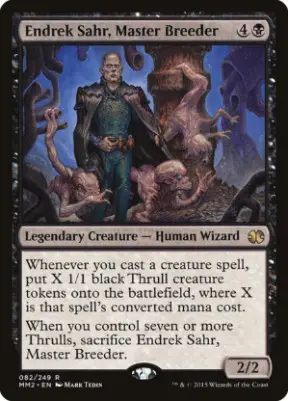
How Does The Deck Work:
This is yet another of the early precons that had quite a few layers of strategies. However, at its core, the deck wants to be creating tokens and sacrificing them. Prossh is both a token generator and a sac outlet himself. While there are a few ways to go about it, the deck wants to turn its expendable creatures into value, card draw, and lethal amounts of damage.
Notable Cards:
Pros And Cons:
| Pros | Cons |
| Versatile win cons | High mana value spells |
| Commander is payoff and enabler | More late game than early |
| Aggressive |
Upgrades:
Power hungry plays very well out of the box. However, there is certainly room for improvement. For upgrades, I mainly focused on improving the sacrifice fodder the deck can produce and adding in more sacrifice outlets.
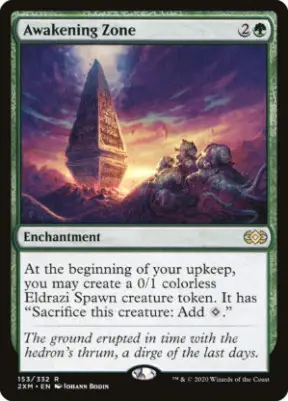
In: Parallel Lives, Necrogenesis, Awakening Zone, Army of the Damned. Mortician Beetle, Nature’s Spiral
Out: Night Soil, Tooth and Claw, Walker of the Groves, Blood Rites, Furnace Celebration, Foster
Commander 2011
Heavenly Inferno
Primary Commander:
Kaalia of the VastColors:
Red, White, Black
Strength Out Of The Box:
The strength right out of the box lies in its ability to cheat out fierce creatures. Whenever Kaalia attacks, you get to put a demon, angel, or dragon creature not only from your hand onto the battlefield but tapped and attacking as well. The creature doesn’t exile at the end of combat or the turn either. So, not only does it allow the deck to be very aggressive with its attacks but allows it to build and maintain its
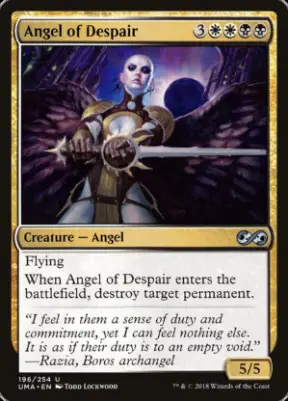
How Does The Deck Work:
Heavenly inferno has a pretty straightforward game plan. It wants to cast its commander, untap with her and manage an attack as quickly as possible. Then cheat the scariest dragon, angel, or dragon creature in hand onto the battlefield and attacking as well.
A few different things help this strategy to work at its best. First, the deck wants to protect Kaalia at all costs, as such a powerful ability will see opponents trying to remove her as quickly and as often as possible. Second, the deck loves to give Kaalia haste or otherwise improve her ability to attack.
Notable Cards:
Pros And Cons:
| Pros | Cons |
| Puts powerful creatures out early/for free | Weak against removal |
| Good early and late game | Commander needs to attack to trigger |
Upgrades:
First, I added some creatures that the deck wants to be cheating into combat. Secondly, I added in some utility cards that make our free attackers even better when they turn sideways. Lastly, I tried to add ways to protect Kaalia from removal, as getting her destroyed pre-combat feels really bad.
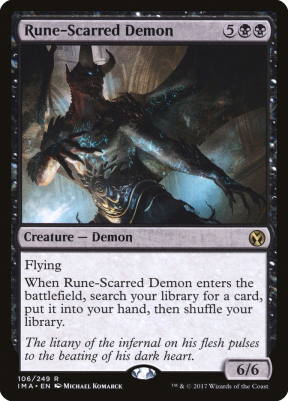
In: Master of Cruelties, Iroas, God of Victory, True Conviction, Rune-Scarred Demon, Avacyn, Angel of Hope, Darksteel Plate, Apostle’s Blessing
Out: Return to Dust, Death by Dragons, Vow of Duty, Vow of Malice, Vow of Lightning, Duergar Hedge-Mage, Fallen Angel
Counterpunch
Primary Commander:
Ghave, Guru of SporesColors:
Black, Green, White
Strength Out Of The Box:
The strength of the deck pre-upgrades comes from Ghave himself. He enables the entire deck as well as his own abilities. Ghave cares about 3 things: Having creatures, having ways to sacrifice them, and +1/+1 counters and he gives you access to all of them by himself. This makes him an extremely valuable asset to have in the command zone and gives the deck a powerful consistency right out of the box.
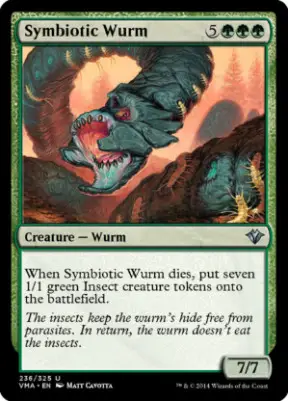
Related: MTG Proliferate: How Does it Work?
How Does The Deck Work:
The deck wants to assemble a value engine by creating and sacrificing creature tokens. There is also a strong +1/+1 counters theme because the deck has several ways to turn counters into tokens. As well as turn tokens back into +1/+1 counters. This allows the deck to gain value through its sacrifices while being able to recycle its resources. Ultimately allowing it to build up whatever creature it chooses into a counter-laden, game-ending threat.
Pros And Cons:
| Pros | Cons |
| Strong value engine | Slow starter |
| High synergy | Mana intensive commander |
| Combo potential |
Upgrades:
For the upgrades for the deck, I added a few pieces for each part of the strategy. So, ways to increase token production, improving sacrifice outlets and cards that synergize with tokens. To make room I simply cut cards that were low impact or over-costed.
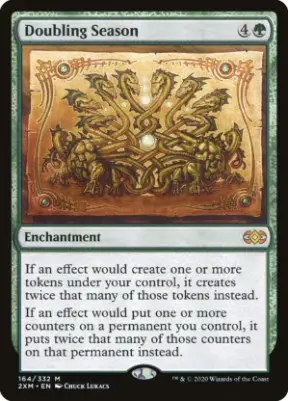
In: Ashnod’s Altar, Doubling Season, Elesh Norn, Grand Cenobite, Hardened Scales, The Ozolith, Sigil Captain
Out: Aquastrand Spider, Deadly Recluse, Monk Realist, Golgari Guildmage, Vampire Nighthawk, Fertilid
Devour For Power
Primary Commander:
The MimeoplasmColors:
Green, Blue, Black
Strength Out Of The Box:
The main strength of the deck right out of the box is its playability. By this I mean, how easy it is for The Mimeoplasm to make use of its abilities. Even without much setup or building around, creatures of yours will end up going to the graveyard. This type of inevitability makes the deck function very well as you are rewarded for simply playing magic.
How Does The Deck Work:
The deck wants to fill its graveyard up with powerful targets for its commander to mimic and clone. The deck wants its creatures to have at least one of three things: First, powerful abilities like that of Damia, Sage of Stone for the mimeoplasm to copy. Secondly, creatures with very high power to bolster his stats as much as possible. Lastly, creatures that generate value while in the graveyard.
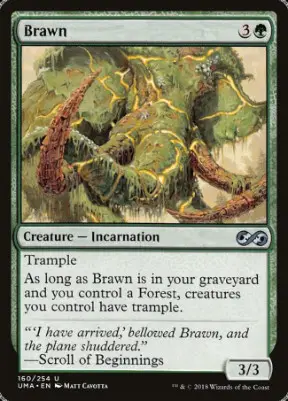
Notable Cards:
Pros And Cons:
| Pros | Cons |
| Commander abilities are very easy to get online | Relies heavily on commander abilities |
| Can generate big threats early in game | Weak against graveyard hate |
| Well costed commander |
Upgrades:
The upgrade strategy for devour for power is pretty simple. We want to upgrade cards in each of the categories the deck seeks to do well in. These would be cards that fill the graveyard, cards with powerful abilities or high power. Simply removing some of the weakest links to make room for additions.
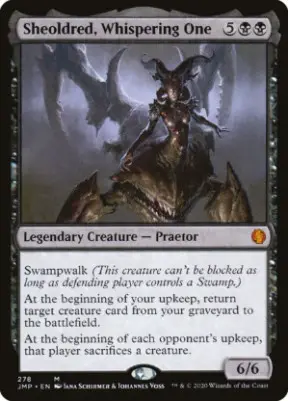
In: Necrotic Ooze, Consuming Aberration, Muldrotha, the Gravetide, Underrealm Lich, Sheoldred, Whispering One, Grisly Salvage, Hogaak, Arisen Necropolis
Out: Vow of Flight, Vow of Malice, Vow of Wildness, Dark Hatchling, Patron of the Nezumi, Sewer Nemesis, Slipstream Eel
Political Puppets
Primary Commander:
Zedruu the GreatheartedColors:
Blue, Red, White
Strength Out Of The Box:
This mtg commander precon’s out-of-the-box strength comes from its ability to pillow fort and control the game. Zedruu herself can draw cards and gain life which is great for getting to the late stages of the game where the deck shines.
The “group hug” nature of the deck means that all player’s strategies are accelerated, including opponents. However, cards like Propaganda and Ghostly Prison ensure opponents use these extra resources against each other.
How Does The Deck Work:
The deck has a very fun approach to the “group hug” strategy. It wants to accelerate all player’s game plans while protecting itself from the chaos it has produced. The deck also looks to exchange its permanents for opponent’s permanents. Oftentimes, “trading up” and getting much better cards than it gives away. Furthermore, Zedruu will draw cards and gain life equal to the number of cards opponents’ control that you own. This makes the trades even more one-sided in the deck’s favor.
Notable Cards:
Pros And Cons:
| Pros | Cons: |
| Contolling | Lacks win cons |
| Good late game | Needs pillow fort style cards for protection |
| Resiliant | Can help opponents game plans |
Upgrades:
The upgrades could be geared more towards a pillow fort style control deck or built to cause maximum chaos. However, my upgrades will be for getting the maximum amount of value out of Zedruu’s second ability. This is achievable by adding in horrendous permanents that make life hard for opponents. As well as increasing the density of the threats and win-cons.
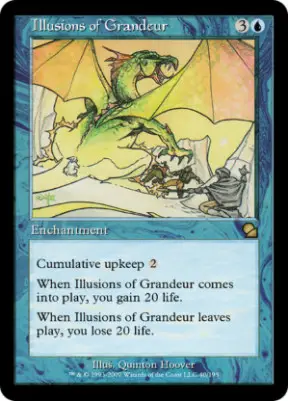
In: Nine Lives, Illusions of Grandeur, Perplexing Chimera, Aggressive Mining, Steel Golem, Pendant of Prosperity, Approach of the Second Sun
Out: Goblin Cadets, Jotun Grunt, Murmurs from Beyond, Lash Out, Perilous Research, Arbiter of Knollridge
Mirror Mastery
Primary Commander:
Riku of Two ReflectionsColors:
Blue, Red Green
Strength Out Of The Box:
This temur deck’s strength comes from its commander’s intrinsic value. By this I mean, with just a little open mana he rewards you for doing what you would be doing regardless, playing spells. There are no special card combinations or intricate set-ups required to reap the benefits of your commander’s abilities. Furthermore, his abilities are equally as good for creature and non-creature spells. This not only gives the deck versatility but means it has very few bad top decks in the late stages of the game and very few bad opening hands.
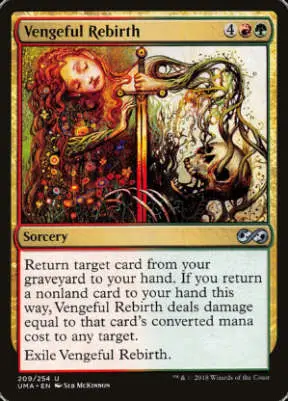
How Does The Deck Work:
The deck has a very straightforward strategy compared to some others. It wants to cast its commander later in the game when it has some mana to spare and copy whatever spell it plays each turn. While this is a simple game plan on paper, the deck usually has several play lines available to it each turn. Coping spells is not only great for card advantage but the deck’s ability to copy creatures it casts can turn any well-stated creature into a win condition.
Notable Cards:
Pros And Cons:
| Pros | Cons |
| Generates value very well | Needs lots of excess mana |
| Lots of ways to win games | Commander needs to be cast late in game |
| Game plan is easy to execute | Slow starter |
Upgrades:
Riku is one of the easiest generals to get triggers off of. Therefore, the cards I am choosing to add in are cards that give even more value each time a token copy is made. To make room for the new spells, I am mainly cutting cards that are not instants, sorceries, or creatures. As well as some cards that are un-synergistic for the strategy.
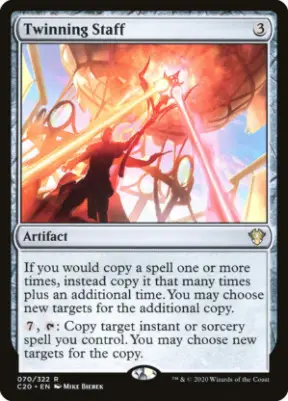
In: Adrix and Nev, Twincasters, Harmonic Prodigy, Biovisionary, Twinning Staff, Deflecting Swat, Narset’s Reversal
Out: Vow of Flight, Vow of Lightning, Vow of Wildness, Chartooth Cougar, Valley Rannet, Garruk Wildspeaker
End Step
EDH is Magic the Gathering’s most popular format, and it certainly shows in the popularity of the commander precons. They have most definitely evolved with the format over the last ten 10 years. However, one thing has always remained the same- They are something people look forward to with every set. Whether you are a veteran of the format looking for the latest reprints or someone looking to play your first EDH game there are fun and affordable precons out there for you.
